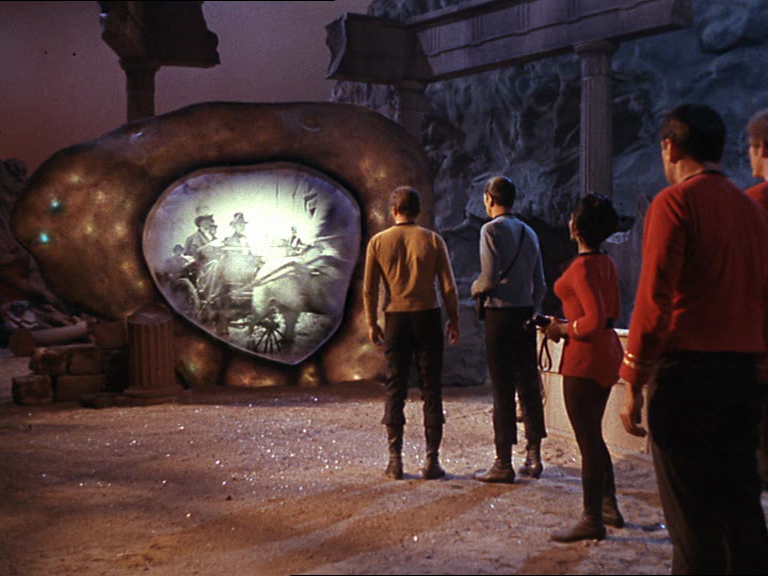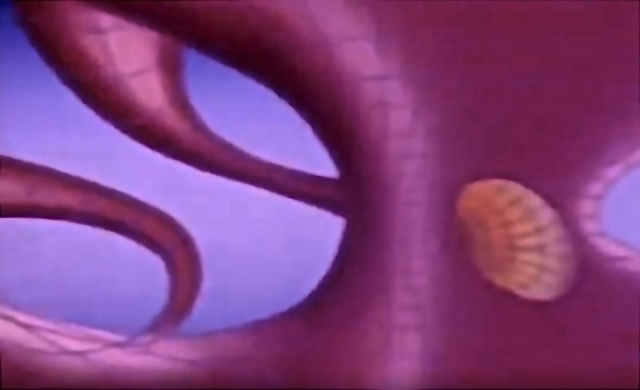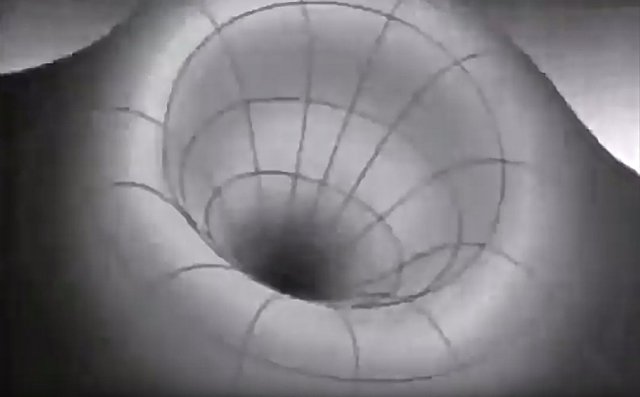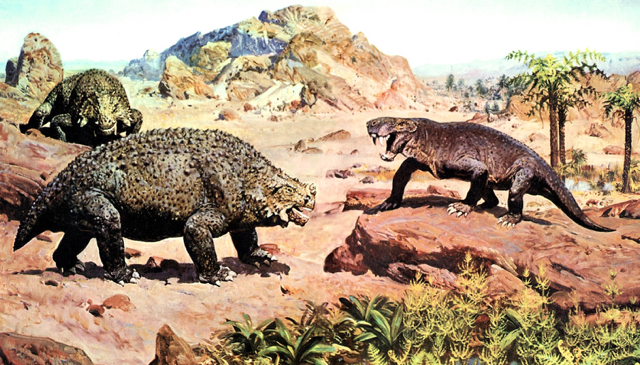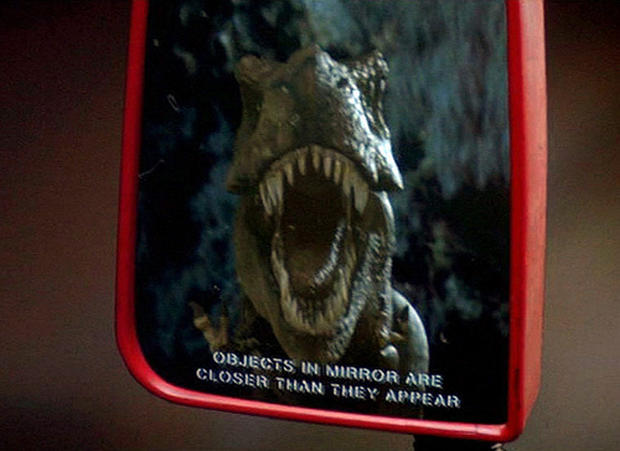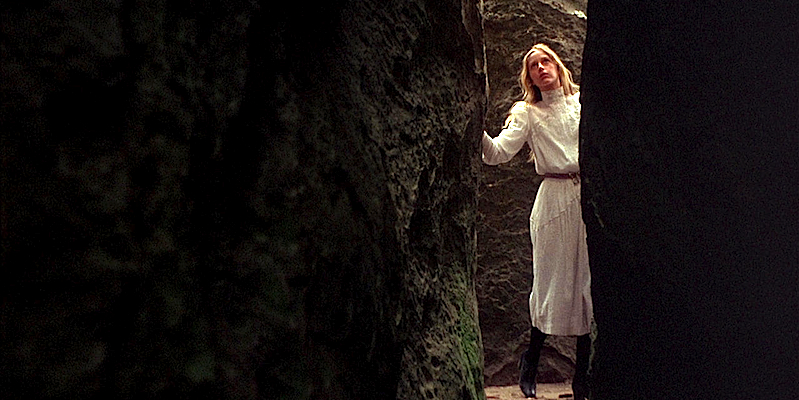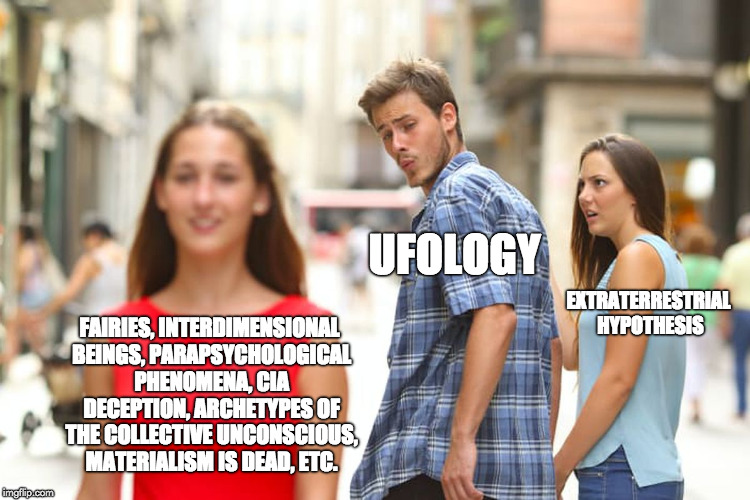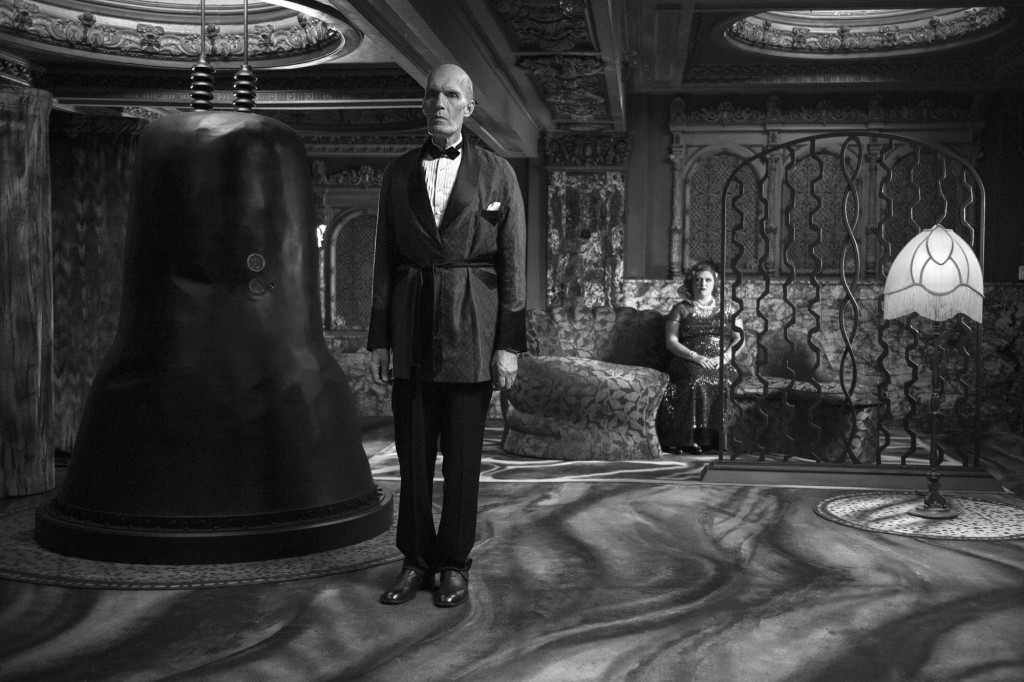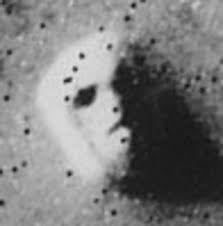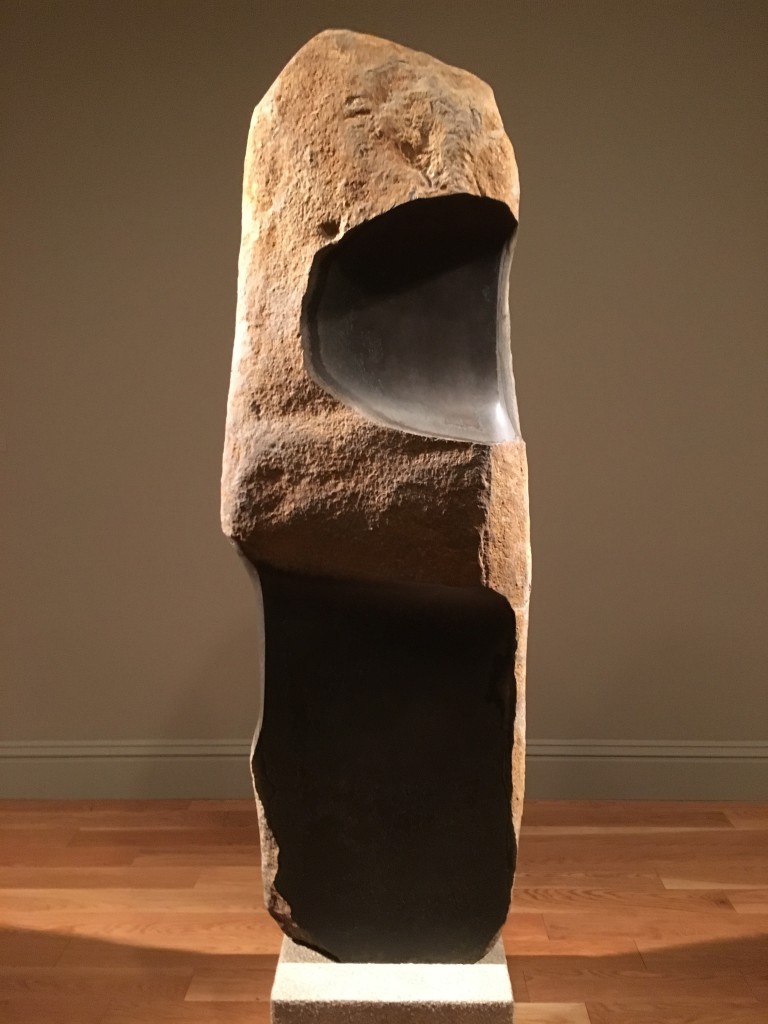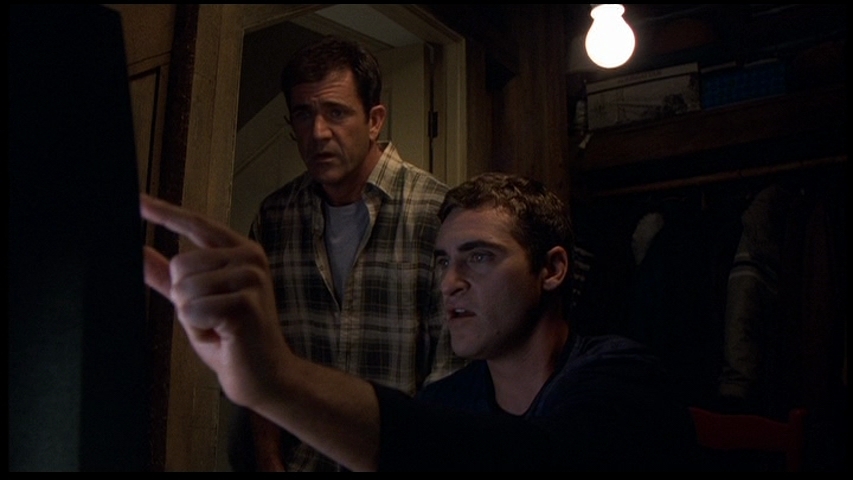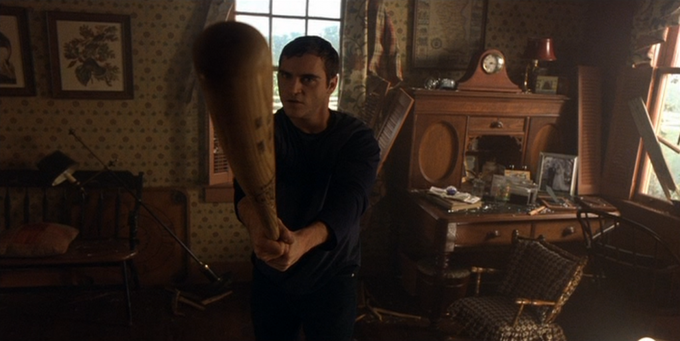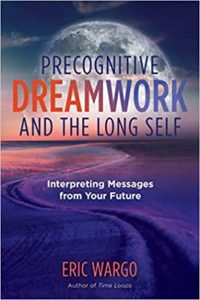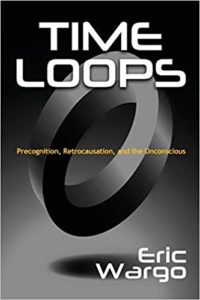The Nightshirt Sightings, Portents, Forebodings, Suspicions
What’s Expected of Us in a Block Universe: Intuition, Habit, & ‘Free Will’
Ted Chiang is an SF writer after my own heart. At every stage in my own investigation of time loops, someone sends me yet another Chiang story that addresses exactly the issues I’ve been working on. What’s more, his stories seem to act as attractors for precognitive and time-looping experiences. I’m sure his new collection Exhalation, which compiles some time-related stories that have been floating around in various publications and on the Internet for several years, will have already precipitated countless precognitive dreams.
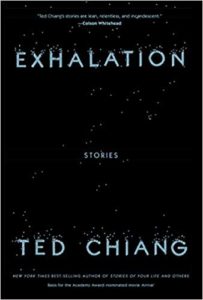 “What’s Expected of Us” is one of those stories. This story, originally published in Nature in 2005, is about a little device with a light, a button, and a precognitive circuit (or “negative time delay”) linking them. The light goes off one second before the button is pressed, and cannot be fooled no matter how hard the user tries. Users treat it like a game, trying to “beat” or outwit the light, but find they cannot. The device becomes super popular, people play with it addictively, but roughly a third of users succumb to a kind of hopelessness and immobility called “akinetic mutism,” because of what the device has taught them about the nonexistence of free will, the futility of trying to change their fate. “Like a legion of Bartleby the Scriveners, they no longer engage in spontaneous action.”
“What’s Expected of Us” is one of those stories. This story, originally published in Nature in 2005, is about a little device with a light, a button, and a precognitive circuit (or “negative time delay”) linking them. The light goes off one second before the button is pressed, and cannot be fooled no matter how hard the user tries. Users treat it like a game, trying to “beat” or outwit the light, but find they cannot. The device becomes super popular, people play with it addictively, but roughly a third of users succumb to a kind of hopelessness and immobility called “akinetic mutism,” because of what the device has taught them about the nonexistence of free will, the futility of trying to change their fate. “Like a legion of Bartleby the Scriveners, they no longer engage in spontaneous action.”
People used to speculate about a thought that destroys the thinker, some unspeakable Lovecraftian horror, or a Gödel sentence that crashes the human logical system. It turns out that the disabling thought is one that we’ve all encountered: the idea that free will doesn’t exist. It just wasn’t harmful until you believed it.
This wonderful little story cuts to the heart of the issues, as well as misconceptions, that surround the question of free will and the threats to it that we imagine are posed by precognition in a block universe, where the future in some sense already exists.
Americans have trouble with anything that appears to threaten the idea of free will. Ours is a highly freedom-loving and individualistic society, and we love the idea that we are free agents, willful determiners of our lives. We think of ourselves as cars who can go anywhere we please, even off-road, not trains fixed to a single track. If we think of the future as “already” holding something in store for us, we delimit that something to destiny, a kind of dotted line around the person we might become but aren’t obliged to. A destiny is a future that awaits our freely willed actions to fulfill or not fulfill, depending. This is in sharp contrast to the ancient notion of fate as a preordained future that will always outwit our best efforts at evasion. Classical tragedies like Sophocles’ Oedipus Rex were thought experiments about fate and how we fulfill it precisely by trying to escape it.
“What’s Expected of Us” is a mini Oedipus Rex for an age of fidget-spinners. But we don’t need to look as far back as fifth Century BC Athens for models for the Predictor. The first thing Chiang’s story reminds me of—and I’d bet the author had it in mind when he wrote the story—is an astonishing 1983 discovery by neuroscientist Benjamin Libet: The nerves in participants’ fingers readied to fire (“lit up” you might say) a fifth of a second before participants consciously decided to move their finger. Libet’s discoveries prompted other psychologists to prove that we are not really masters in our house. Experiments by Daniel Wegner and others seemed to show that we instead take credit for actions per our culturally ingrained ideas of agency. The ego sees something it likes—a successful motor action, say—and proudly goes “I did that.” It sees something it didn’t like, like tripping and falling, and chalks it up to accident or to some external force or influence impinging on it.
Conscious will as studied in psychology laboratories is not exactly the same thing as the philosophers’ free will and the question of physical determinism. But it offers an interesting entry point to the question of what we really lose by jettisoning that philosophical security blanket of imagining that the future remains open ended and under our control. If the conscious mind is a spectator, what is it we’re really talking about when we’re talking about free will? Is “akinetic mutism” really the result of giving up on our belief in it?
Seize the Fish!
In Chiang’s story, Predictor users slump into apathy and silence because they decide their actions (versus nonactions) don’t matter. And part of their problem is they can’t shake their feeling of free will even when they know it isn’t “real” in some larger sense. Lying in bed and not responding to one’s surroundings is just as much an action as getting up and seizing the day (“Carpe diem!“) in the belief that we are agents of our lives—because our thoughts and interpretations are just as much “enacted” as our physical movements.
 But what the Zen masters of China and Japan discovered is that direct experience of the illusory nature of free will actually leads to liberation, not apathy. There is a training-wheels phase, though: Trying to escape the question of free will/no free will and directly experience pure spontaneity is a familiar experience for any beginner at Zen practice, in fact. What one discovers is the ridiculousness of the pose of “not acting.” You can’t escape your thoughts. Nor can you escape the will of your body. (Hunger alone will drive you to go to the kitchen and eat, ignoring your mental bafflement: “hey, is this freely willed, or not??”)
But what the Zen masters of China and Japan discovered is that direct experience of the illusory nature of free will actually leads to liberation, not apathy. There is a training-wheels phase, though: Trying to escape the question of free will/no free will and directly experience pure spontaneity is a familiar experience for any beginner at Zen practice, in fact. What one discovers is the ridiculousness of the pose of “not acting.” You can’t escape your thoughts. Nor can you escape the will of your body. (Hunger alone will drive you to go to the kitchen and eat, ignoring your mental bafflement: “hey, is this freely willed, or not??”)
Ultimately, passively observing the flow of stuff in our head, and detaching ourselves from our actions and their outcomes, is highly freeing, not to mention empowering. What serious meditators discover is that, unburdened from the baggage of thinking about their freedom or unfreedom, their thoughts become more rewarding and their actions and words more skillful. The less free we imagine we are, the more free we feel. It’s the same joy anyone feels whenever they practice any complex skill and become so good at it that the practice becomes effortless, performed in a state of flow. Shao-lin kung-fu masters are not worried about their free will. Neither are the wise heptapods in the movie Arrival, based on Chiang’s “Story of Your Life.”
The akinetic mutists of “What’s Expected of Us” are simply stuck in that awkward in-between period, on the way to becoming enlightened Zen masters or heptapods basking blissfully in the eternity of the block universe.
The question of human precognition and free will should not be divorced from the question of skill performance. Anyone who knows how to drive a car well, be super witty on a date, or swiftly change a baby’s diaper with one hand knows that we are most effective when we don’t think about what we are doing but just do it. Research on “psi” also shows that it is an unconscious, un-willed function or group of functions. Laboratory experiments strongly support something like presentiment (“feeling the future”), and there is reason to think it could be a pervasive feature or even a basic underlying principle of our psychology. I am not the first to suggest that Libet’s findings actually reflect the tip of the iceberg of presentimental functioning.
Indeed, people who express strong “intuitive” ability often seem to do so in the context of some automatized and highly enjoyable/thrilling motor skill—piloting a plane, martial arts, mountain climbing, but also things like musical performance, stage magic, and other arts (including hammering away at a typewriter for a penny or a dollar a word). I consider dowsing to be the model, the most basic form (or stem cell) of psi as presentiment/precognition: using motor reflexes to tap into a forthcoming reward via the ideomotor effect. And whether you are a race car driver, a remote viewer, or a dowser, self-consciousness that might include an awareness of “making choices” is the last thing you want.
The relation of our conscious will to our skilled actions may be something like a time loop, in other words. We go through life behaviorally divining successful or rewarding outcomes, which we then reflect on afterward, perhaps misinterpreting that retrospective reflection as agency. But another way of putting this is that we may be “pulling our meat puppet’s strings” from a point farther along our timeline. What we interpret in hindsight as our will or intention is really the reward of having had an accurate premonition of a future successful action.
Caudate-Putamen
Interestingly, there is now potentially some neurobiological support for the linkage of “psi” specifically with compulsive, habitual, or automatic—in other words, distinctly not “consciously willed”—behaviors.
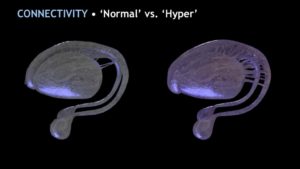 This past winter, a few blogs including Terra Obscura announced the highly intriguing findings of Garry Nolan (Rachford and Carlota Professor in the Dept. of Microbiology and Immunology at Stanford School of Medicine) and forensic neurologist Christopher “Kit” Green (Depts. of Diagnostic Radiology and Psychiatry and Behavioral Neurosciences at Wayne State School of Medicine and Detroit Medical Center) on a brain area called the caudate-putamen. In the course of working with a population of 135 high-performing military and intelligence personnel who had suffered injuries from anomalous encounters in the line of duty, the researchers noted an additional feature in a few patients’ MRIs. Twenty of the most high-functioning and “intuitive” of this group, as determined from medical and psychological records, displayed significantly enhanced connectivity between their caudate and putamen, compared to the general population.
This past winter, a few blogs including Terra Obscura announced the highly intriguing findings of Garry Nolan (Rachford and Carlota Professor in the Dept. of Microbiology and Immunology at Stanford School of Medicine) and forensic neurologist Christopher “Kit” Green (Depts. of Diagnostic Radiology and Psychiatry and Behavioral Neurosciences at Wayne State School of Medicine and Detroit Medical Center) on a brain area called the caudate-putamen. In the course of working with a population of 135 high-performing military and intelligence personnel who had suffered injuries from anomalous encounters in the line of duty, the researchers noted an additional feature in a few patients’ MRIs. Twenty of the most high-functioning and “intuitive” of this group, as determined from medical and psychological records, displayed significantly enhanced connectivity between their caudate and putamen, compared to the general population.
The work of this sample of persons is secret, as are the circumstances of the injuries that brought them to the attention of the researchers in the first place; but the implication is that those who showed the enhanced connectivity are the kinds of people who have “Spidey sense,” who could instinctively guide you down the right path in enemy territory because they sense danger down the left. A sample of remote viewers for whom MRI scans were available all showed the same caudate-putamen biomarker.
The caudate-putamen, also known as the dorsal striatum, is thought to be a kind of “hub” that integrates information from across the brain and translates that information into motor actions. Nolan and Green’s sample show exceptionally high parallel and rapid processing of what in very recent years has emerged as functions of the dorsal striatum’s receipt of incoming sensory information, and subsequent integration in the prefrontal cortex.
In presentations of their finding, the researchers have called the dense, spoke-like connectivity in these high-performing individuals an “antenna”—there is indeed something suggestive of an antenna in its visual appearance—but they have not tested the notion of any electromagnetic receiving or transmission capability, and they recognize that its precise functional role in intuitive skill performance is a matter of speculation at this point. But they did not find this feature at all in brain scans from a retrospective sample of over 300 “ordinary” people—that is, patients who had no medical histories of high executive functioning, and who served as single-blind controls.
And interestingly, it appears to run in families. The researchers fortuitously had access to siblings, parents, and children of some subjects—3 or 4 family members in a few cases—and the MRI finding was present in those individuals also. Consequently, Nolan established a genetic pilot study that is now underway, to learn more about this feature and its heritability. It is still unknown whether and to what extent life experience or training may also influence it (i.e. the brain’s plasticity). When helpfully answering my questions by email, they also stressed that their finding about the caudate-putamen in this sample has not been peer-reviewed, nor yet published, nor subjected to double-blind verification.
“Antenna” is a sexy term, and it got the attention of many people who are interested in intuitive and psychic functioning. But if further research supports this brain feature and its relation to high performance, I have a hunch “Predictor” might turn out to be an even better term for what Nolan and Green have found.
The Jouissance System
The study of psychic phenomena has always adopted some model of information-transfer, rooted in telecommunications technologies of the day. The telegraph dominated the thinking of Frederic Myers with his theory of “telepathy” in the last two decades of the 19th Century. In the Rhines’ day, radio was an obvious metaphor for ESP. And later remote-viewing researchers naturally likened the practice to tuning in on a TV signal. Today, the metaphors of nonlocality and entanglement between psychics’ minds and the wider universe are hot. But if “psi” is really precognition, then nothing necessarily needs to be sensed or detected from outside the body or even outside the nervous system. It would be the nervous system’s connection to itself across time that matters.
In that view, a soldier with Spidey sense might not actually be receiving some kind of waves coming from the IED down the left path and thus leading her squad down the right path. Her brain might instead be post-selecting on the ambivalent future reward of having taken the right path and then heard the explosion and screams of some other less-fortunate squad that took the left. Intuition would be a premonition of ambivalent future reward. If that’s the case, then the neurotransmitter dopamine and the reward circuits that use it might have a lot to do with this disturbing-yet-rewarding “signal” from the individual’s future.
 This is why I was (selfishly) a bit excited to hear about Nolan’s and Green’s discovery. In interviews such as his recent appearance on Café Obscura, Nolan has highlighted the caudate and putamen’s role in intuition, but one way of looking at intuition is generating actions from available information quickly, bypassing conscious, deliberate decision-making. When we talk about bypassing those more deliberate processes, we’re essentially talking about making our responses automatic. In a lot of neuroscience literature, the dorsal striatum is not only associated with intuition but also with habits and compulsions—actions we don’t necessarily want to engage in but do so anyway, feeling we have no choice. In other words, in the brain, intuition is closely tied to habit and to the most un-“freely willed” of our behaviors, such as compulsions and addictions.
This is why I was (selfishly) a bit excited to hear about Nolan’s and Green’s discovery. In interviews such as his recent appearance on Café Obscura, Nolan has highlighted the caudate and putamen’s role in intuition, but one way of looking at intuition is generating actions from available information quickly, bypassing conscious, deliberate decision-making. When we talk about bypassing those more deliberate processes, we’re essentially talking about making our responses automatic. In a lot of neuroscience literature, the dorsal striatum is not only associated with intuition but also with habits and compulsions—actions we don’t necessarily want to engage in but do so anyway, feeling we have no choice. In other words, in the brain, intuition is closely tied to habit and to the most un-“freely willed” of our behaviors, such as compulsions and addictions.
Like other parts of the reward circuit, the cells of the dorsal striatum, including those spoke- or antenna-like connections identified by Nolan and Green, predominantly use dopamine for signaling. It is part of what I think of as the brain’s “jouissance system.” Jouissance is just a fancy French word for the drive that takes over in a compulsive disorder like a neurosis or an addiction—a reorientation of the salience of incentives away from some euphoric payoff or reward into various cues associated with it, which perpetuate the drive. Freud called it the “compulsion to repeat,” and for him it was the basis of neurotic behavior.*
If anomalous cognition or psi is “really” (or mainly) precognition, it makes sense that brain areas governing habit and compulsivity might figure prominently in its neurobiology. The reason is that computation across the fourth dimension depends on repetition: The brain’s ability to make some sense of information coming down the pike requires self-consistency over time. Just as a New Yorker will have an easier time understanding a time traveler from a 25th Century where they still speak recognizable English in New York versus a future where everyone had switched to Russian, the more we expect our reactions to stimuli in ten minutes or a year will be the same as now, the more decontextualized information coming from our future can make sense and be useful in guiding behavior. Compulsions and habits, which in many ways are just overlearned skills, create the necessary self-expectations that might serve as the cipher-key of information back-flowing from an individual’s future.
A “Predictor” circuit could in a sense be likened to an antenna, but in the fourth dimension. Just like some antennae appear as grids, parallel lines, or “repetitions” in space, a fourth-dimensional biological antenna would likely involve repetition of behaviors over time.
iPredictor™
Here is where we come back to the theme of “free will” and Ted Chiang’s story. Not unlike people in the grip of an addiction or a compulsion, intuitive and highly skilled people are those who readily make decisions without thinking. Their high performance, as well as their “psi,” is an outside-of-conscious-will phenomenon. And it may be the best model for thinking about the unconscious in relation to consciousness: The unconscious leads the way, but it may be in a necessary partnership with the 20-20 hindsight of conscious awareness. The squad leader’s psi/jouissance needs that confirmation in the form of the screams coming from the other path. The time-looping relation to future confirmation is crucial.
 There is a tendency to think of precognition as some kind of superpower enabling the individual to scan various options ahead and select the optimal one, like a kind of radar. But if in fact precognition is just what Freud called “the unconscious” in many or all its manifestations, then we need to rethink its role in our lives. it is not, in that case, some “super” faculty giving us the ability to spot dangers and avoid them—which could lead to the paradoxical situation of preventing a foreseen outcome. It is instead the faculty that prepares us, cushions us, for alarming news and close calls that do lie ahead in our un-freely-willed future.
There is a tendency to think of precognition as some kind of superpower enabling the individual to scan various options ahead and select the optimal one, like a kind of radar. But if in fact precognition is just what Freud called “the unconscious” in many or all its manifestations, then we need to rethink its role in our lives. it is not, in that case, some “super” faculty giving us the ability to spot dangers and avoid them—which could lead to the paradoxical situation of preventing a foreseen outcome. It is instead the faculty that prepares us, cushions us, for alarming news and close calls that do lie ahead in our un-freely-willed future.
If there is something like a radar, it would really (in this view) be our ordinary conscious thought processes that consider counterfactual situations and scenarios and make us take wise precautions and adjust our behavior based on past errors. The anxious brain lying awake at 3AM consciously worrying about disasters and dangers and agonizing over mistakes is the real radar that steers us clear from undesirable outcomes ahead. However, in a block universe, action verbs like “steer” need to be seen more statically, as parts of four-D time loop formations. “Steering toward success” needs to be rephrased as “discovering you are the person who was successful.” Overhauling our language to deal with a block universe is a massive subject, for another post (or book).
But the bottom line is: I will be the first in line at the Apple store when the Chiang-inspired iPredictor goes on sale in May, 2026. Far from creating a population of akinetic mutists, it will act as a material(ized) koan, fast-tracking users to Satori.
Postscript: Failure Is Not an Option
People who find the idea of precognition, retrocausation, and time loops interesting are often of an occultist bent, and I have been asked several times how the block universe that allows precognition can be reconciled with the active intention setting that a magician might utilize. And what about the idea that thoughts and intentions create our reality? I often think of my friend Mitch Horowitz’s brilliant writings on New Thought (such as his recent book The Miracle Club), and how determinism in a block universe seems on the surface so antithetical to the outlook he describes: that thoughts are causative.
 Sometimes when two ideas seem diametrically opposed, zooming in reveals a closer kinship. For one thing, I agree with Mitch’s basic assertion that thoughts are causative. Where I may differ is in the direction of their causation. If our unconscious behaviors are premonitory of what we think of as our will, if what we “precognize” with our bodies and our automatic (unconscious) actions is our future conscious thoughts, realizations, and “intentions,” then those thoughts are by definition retro-causing the past. Our conscious realizations and intentions for the future are actually writing (or “having written”) our past life scripts. They do this not just by reordering our memories in the present (Slavoj Žižek’s cautious, not-quite-retrocausal, not-quite-Gnostic position), but by actually directing our actions from the future and influencing our younger selves.
Sometimes when two ideas seem diametrically opposed, zooming in reveals a closer kinship. For one thing, I agree with Mitch’s basic assertion that thoughts are causative. Where I may differ is in the direction of their causation. If our unconscious behaviors are premonitory of what we think of as our will, if what we “precognize” with our bodies and our automatic (unconscious) actions is our future conscious thoughts, realizations, and “intentions,” then those thoughts are by definition retro-causing the past. Our conscious realizations and intentions for the future are actually writing (or “having written”) our past life scripts. They do this not just by reordering our memories in the present (Slavoj Žižek’s cautious, not-quite-retrocausal, not-quite-Gnostic position), but by actually directing our actions from the future and influencing our younger selves.
So in other words, I think our thoughts are efficacious, and specifically in our past—that is to say, in the past (or prehistory) of the thought. This kind of retrocausation may be operative on millisecond or second scales, such as in the presentiment research of Dean Radin or the “feeling the future” studies of Daryl Bem, but also over days, years, and decades. A macro model for this is dreams, of the sort I’ve discussed frequently on this blog. If a person’s day is even slightly affected by a dream (even just in the mere act of writing it down) and the dream consists of or contains precognitive material—which it’s even conceivable all dreams do—then information from the future has exerted a shaping force on the past … even if we misinterpret the dream. If this time-looping logic goes all the way down, even to the cellular level of thoughts in the brain, as I strongly suspect it will turn out to, then our thoughts are causative of our histories. We ongoingly shape ourselves into the past. Our past is an effect of our future.
Note that this is not the same thing as “changing the past”—the idea that we could somehow meddle in and alter our timelines—the Mandela effect and whatnot. How would we ever know our timeline had changed? We can however produce improved outcomes in our near future when we realize how we have contributed to shaping our past. We can sow seeds in the past for a better tomorrow. This is exactly the payoff of the “dream paleontology” I described a few posts back, and it will turn out to be the motto or philosophy of our timefaring descendents.
We need to remember: What we think we “know” of the past (or present) is at best a tapestry of suppositions, assumptions, and interpretations. Most modern conceptual frameworks for understanding the past make no room for a teleological influence and thus we think of the past as fixed and untouchable by any later influence … but that’s just a modern, post-Enlightenment failure of imagination, not a real limitation on reality. Increasingly, evidence shows our commonsense view of causality only going in a forward direction is simply wrong—in Time Loops I call it “folk causality.” We simply need to update our imaginations.
We have no proof yet, but my hunch is that the underlying principle in precognition will probably turn out to be retrocausal processes in quantum biology—perhaps quantum computation in molecular structures controlling brain plasticity (microtubules). One way we already know quantum processes manifest in biology is the phenomenon called quantum tunneling: the apparent fast-forwarding of unmeasured particles toward their destinations. (We know photosynthesis and enzymatic actions depend on it, for instance.) The retrocausal interpretation of quantum mechanics reframes this: It is the “measurement” (or just, terminal interaction) that retro-determines the particle’s path.
This quantum fast-forwarding toward what to our eyes appear like “intended” outcomes could be the X factor separating life from lifeless matter in organic molecules, the missing “vital” principle underlying life. It would force us to reincorporate “purpose and desire” into our understanding of living systems. And it would scale up in nervous systems, which tend (to some greater-than-chance degree) to post-select on survival and rewards in the organism’s future.
This allows us to “flip” the New Thought idea that success is built on mind. Mind is really built on success. Mind IS success. And since on a basic level that “success” is post-selecting the actions leading to it, there is no “other” world of “failure” (or “missing”) out there as an option for where a particle could go or what an organism could do. That Spidey-sense squad leader automatically took the right path without the IED, and there was no alternative or counterfactual reality where she took the left path instead. Failure is literally not an option in a retrocausal universe, at least on the most basic level of particles. The Mind scales up this “tunneling toward the optimum” principle and utilizes it to create the splendiferous 4-D formations that are our biographies.
ACKNOWLEDGMENTS: Many thanks to Kit Green and Garry Nolan for sharing their research and slides with me, and for answering my many questions. My interpretations of their finding are entirely my own. Thanks also to Michael Garfield of the Future Fossils podcast for alerting me to Chiang’s “What’s Expected of Us.”
NOTES
** A similar shift of orientation toward cues rather than payoffs also reflects the intrinsic reward that takes over in practioners of highly trained skills. For a race car driver, the pleasure is in the driving, not just in crossing the finish line—in fact, the latter is a bit of a disappointment, because it means the race is over. Presumably some of the intuitive high-performers in Nolan’s and Green’s sample are fueled by the same dopamine drive, a kind of jouissance from always being on the edge of peril or risk.
Edges of Forever: Time Travel and the Stories That Might Have Been
“We can’t imagine our lives without the unlived lives they contain.”—Adam Phillips, Missing Out
Ship’s Log: star-date 3139.0. Having tracked unusual spacetime ripples to their source, the Starship Enterprise now threatens to be ripped apart as it struggles to maintain its orbit over an uncharted, weirdly time-disturbing planet. There is chaos on the bridge. Mr. Sulu, injured by his exploding control panel, is brought back to life by an injection of an adrenaline-like wonder-drug called Cordrazine … but just then, another spacetime ripple causes Dr. McCoy to accidentally inject himself with a megadose of the stimulant. Raving mad, McCoy dashes from the bridge as the rest of the crew struggle to save the ship, and he beams himself down to the planet that is causing all the spacetime havoc.
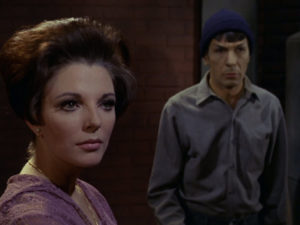 Pursuing the mad Doctor to the surface, Kirk, Spock and several crewmembers find they are in the ruins of an incredibly ancient and vast city; at its heart is an enormous loop pulsating with light. This object awakens to their presence and announces, in a deep echoing voice, that it is the Guardian of Forever, a sentient portal through time. It begins showing its visitors scenes from Earth’s history, and just as it displays a street scene from 1930s America, Dr. McCoy, who had been hiding behind a nearby rock, dashes through the portal.
Pursuing the mad Doctor to the surface, Kirk, Spock and several crewmembers find they are in the ruins of an incredibly ancient and vast city; at its heart is an enormous loop pulsating with light. This object awakens to their presence and announces, in a deep echoing voice, that it is the Guardian of Forever, a sentient portal through time. It begins showing its visitors scenes from Earth’s history, and just as it displays a street scene from 1930s America, Dr. McCoy, who had been hiding behind a nearby rock, dashes through the portal.
The landing party suddenly finds that the Enterprise has disappeared from orbit overhead. Somehow Dr. McCoy, centuries in the past, changed history, leading to a present with no Enterprise to return to, and perhaps no Star Fleet … maybe even no Earth. So Kirk and Spock have to go through the portal themselves to try and make things right.
Thus begins “The City on the Edge of Forever,” perhaps the most famous and best-loved original series Star Trek episode. Even now, over half a century since it first aired, it remains a great hour of television, with some of the most moving, funny, and (yes) campy moments in the whole series. It is also one of the few Trek episodes to attain a kind of tragic gravitas. Joan Collins delivers a memorable performance as Kirk’s love interest Edith Keeler, the Depression-era peace activist whose sacrifice to the wheels of history is required to return the river of time to its former course.
Even though it is just a piece of network TV from a much more innocent era, “City” is arguably one of the most influential time travel narratives of all time. I’ll wager that more people have seen (and remember) this one episode of Gene Roddenberry’s NBC series than have ever read H. G. Wells’ The Time Machine, for instance. It also came to define the life of its famously cantankerous scriptwriter Harlan Ellison in ways that weirdly—really weirdly—mimicked the original treatment and teleplay he penned for it. This is no accident, as I believe it is yet another case of the literary-creative precognition that is so prevalent among imaginative writers. As we saw with Joan Lindsay and her novel Picnic at Hanging Rock, these cases always fractally swirl around “time gimmicks” of one sort or another. Ellison’s time machine (which only became the sentient stone-loop Guardian in the filmed episode) made the perfect “strange attractor” for a precognitive writer’s soul. And as in Lindsay’s case, it was the alterations made to Ellison’s story by other people that created this defining time warp in his life.
Anger Issues
Trek nerds know what went down, at least in its rough outlines, and Marc Cushman gives all the sordid details in the first volume of his essential tome, These Are the Voyages. Ellison, already a respected writer of SF stories and screenplays for series like The Outer Limits, was commissioned by Roddenberry in 1966 to write an episode for the first season of his new space series. The treatment Ellison delivered contained the brilliant premise we all know and love—Kirk travels into the past and falls in love with an idealistic peace activist whom he must then allow to die … but it was also totally unfilmable as written, at least to fit within a single hour of network TV. Also, it contained dark elements that were way out of character with what Roddenberry envisioned for his still-unaired utopian show.
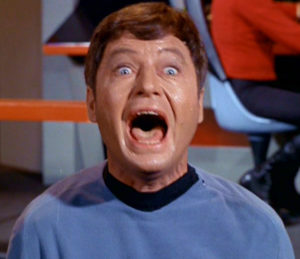 Ellison’s version opens with a drug deal. The ship’s navigator, hopelessly addicted to an alien narcotic called the Jewels of Sound, purchases some of the stuff from a shady officer named Beckwith. We fade to the bridge, where the navigator, now high as a kite, nearly destroys the ship and is relieved by an angry Mr. Spock. When the navigator, below decks, announces to Beckwith he’s going to go straight and turn the dealer in, Beckwith murders him. There follows a court martial that finds Beckwith guilty, and Kirk and Spock lead a landing party down to a desolate planet to execute Beckwith by firing squad. Their immediate punitive plans are interrupted when they spot an ancient city high in the distant mountains. Because Star Fleet protocols prohibit executing criminals on inhabited worlds, they need to investigate this city before executing Beckwith, a “creature not even worth calling a man.”
Ellison’s version opens with a drug deal. The ship’s navigator, hopelessly addicted to an alien narcotic called the Jewels of Sound, purchases some of the stuff from a shady officer named Beckwith. We fade to the bridge, where the navigator, now high as a kite, nearly destroys the ship and is relieved by an angry Mr. Spock. When the navigator, below decks, announces to Beckwith he’s going to go straight and turn the dealer in, Beckwith murders him. There follows a court martial that finds Beckwith guilty, and Kirk and Spock lead a landing party down to a desolate planet to execute Beckwith by firing squad. Their immediate punitive plans are interrupted when they spot an ancient city high in the distant mountains. Because Star Fleet protocols prohibit executing criminals on inhabited worlds, they need to investigate this city before executing Beckwith, a “creature not even worth calling a man.”
Once the landing party reaches the city, they find it long abandoned except for a group of tall, ancient, bearded immortals who protect a portal-like time machine. After Beckwith flees through the machine while it is showing scenes of the Depression, the landing party beams back up, only to find that the ship is no longer the Enterprise but a renegade pirate ship called the Condor. This is when Kirk and Spock decide to go back down and go through the portal to try and change history back, while the rest of the landing party fight off the pirates. Once in 1930s America (Chicago in Ellison’s version), Kirk and Spock are chased by a xenophobic mob, steal some clothes, and then get jobs while waiting for Beckwith to appear. All this happens before we ever meet Kirk’s love interest Edith Koestler (she was changed to Keeler in a later version) in Act Three.
It’s a two-hour movie, in other words, not a 50-minute Star Trek script. And did I mention it was dark? After Kirk and Spock repair history by preventing Beckwith from pushing Edith out of the way of a truck, they return to the future; there, the “wise” (in fact, sadistic) Guardians assure Spock and the grief-immobilized Kirk that history has been repaired, but as a favor they request that they leave Beckwith with them, so they can punish him appropriately. They beckon Beckwith toward a pillar of light, and he “finds himself materializing in the heart of a sun.”
An execution that goes on forever and ever, for the Guardians have altered their machines so that Beckwith is caught in a time-Mobius. An interlocked time-phase that puts him into the heart of a blazing inferno just long enough to die, then snaps him out to a moment before he died, then puts him back then takes him out, over and over and over and over…
Yeah. It’s a really angry story. Ellison was a famously angry man. (Writer Nat Segaloff titles his biography of Ellison A Lit Fuse.)
The script Ellison delivered after Roddenberry’s requested cuts and changes simplified things a little—for instance, the court martial and firing squad from the treatment were eliminated in favor of Beckwith just fleeing to the surface—but the changes were not sufficient. Thus, Roddenberry had his writing staff—Steven Carabatsos, Gene Coon, and Dorothy Fontana—perform a series of rewrites that greatly simplified Ellison’s story. Beckwith was eliminated and an accidentally drugged McCoy became our history-altering MacGuffin. The Guardians of the time portal were eliminated and the portal itself became sentient, saving further on cost. The scene where the landing party beams up to the Condor and Yeoman Rand fights to hold the pirates at bay, was cut. Scenes showing a fascist demagogue stirring up hate in the streets and an employer’s racist treatment of Spock (passing himself off as a “Chinee”) were also cut. They also eliminated other, moving but strictly extraneous scenes and characters, including one involving a legless veteran of the Battle of Verdun named Trooper—more on whom below.
Apart from just simplifying (and way lightening up) Ellison’s sprawling story, the rewrites clarified and strengthened the narrative in crucial ways. In Ellison’s original version, Spock merely convinces Kirk that Edith must die because of supposition on his part that her peace movement might alter history by delaying the U.S. entry into WWII. Fontana, the unsung script doctor and secret heart of much of Star Trek, added the contrivance of a radio tube mechanism whereby Spock is able to use his tricorder to actually view news headlines from the original and the altered timelines, thereby convincing Kirk (and the audience) that, as he repeatedly says, “Edith Keeler must die.” This simple, elegant plot device is crucial to understanding and being compelled by the story.
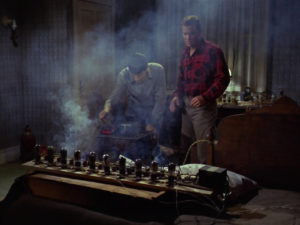 I’m hardly the first to say that, even though Ellison’s teleplay is beautifully written and also contains the most badass scene ever written for Yeoman Rand*, it’s not Star Trek. It is unnecessarily sprawling—way too sprawling for an hour-long show. Whatever we might think of moralistically bowdlerizing realities (even on future starships) like drug-dealing and addiction, or the dangers of fascism, it reads less like an installment of the essentially utopian future of Roddenberry’s series than like a stand-alone film script. The logical and compassionate Spock’s repeated epithets about Depression-era Earthers (“savages” and “barbarians”) do not compute. Nor does it seem realistic that Kirk would be willing to let his beloved Edith die simply because Spock persuades him she might change history a certain way, based on cryptic hints provided by the ancient Guardians of the portal. There needs to be something concrete, and the viewer needs to see on Spock’s amped-up tricorder those conflicting headlines (“SOCIAL WORKER KILLED” and “F.D.R. CONFERS WITH SLUM AREA ‘ANGEL’”) as well as scenes of Hitler’s rallies, to be really sold on the necessity of letting history resume its former shape through the sacrifice of Edith. The mad-scientist contrivance of radio tubes—made as Spock memorably says, from “stone knives and bearskins”—is just the ticket.
I’m hardly the first to say that, even though Ellison’s teleplay is beautifully written and also contains the most badass scene ever written for Yeoman Rand*, it’s not Star Trek. It is unnecessarily sprawling—way too sprawling for an hour-long show. Whatever we might think of moralistically bowdlerizing realities (even on future starships) like drug-dealing and addiction, or the dangers of fascism, it reads less like an installment of the essentially utopian future of Roddenberry’s series than like a stand-alone film script. The logical and compassionate Spock’s repeated epithets about Depression-era Earthers (“savages” and “barbarians”) do not compute. Nor does it seem realistic that Kirk would be willing to let his beloved Edith die simply because Spock persuades him she might change history a certain way, based on cryptic hints provided by the ancient Guardians of the portal. There needs to be something concrete, and the viewer needs to see on Spock’s amped-up tricorder those conflicting headlines (“SOCIAL WORKER KILLED” and “F.D.R. CONFERS WITH SLUM AREA ‘ANGEL’”) as well as scenes of Hitler’s rallies, to be really sold on the necessity of letting history resume its former shape through the sacrifice of Edith. The mad-scientist contrivance of radio tubes—made as Spock memorably says, from “stone knives and bearskins”—is just the ticket.
As Fontana later revealed, one transformation in the story was not due to rewriting but to a comical misreading. Ellison’s ancient city was, like its Guardians, like something out of Tolkien—an ethereal vision of spires in the high mountains. Ellison had even described it as full of “rune stones.” The director of the art department, however, who admitted reading it after a couple drinks, did not know what “runes” were and, when he consulted a dictionary, happened on the word “ruins” and decided that that must be what Ellison intended. So the city in the filmed episode became an ancient, ruined city—an anachronistic (but now iconic) mix of broken Doric columns and the distended bagel-shaped Guardian of Forever.
Ellison hated it.
Success Has Many Parents
It is always easy to laud the solitary genius writer and fault the producers when things go wrong in Hollywood, but it is harder to acknowledge that Hollywood’s successes often arise from the same process. As Leonard Nimoy diplomatically puts it in a statement about Ellison’s script, “Success has many fathers. Failure is an orphan.” Fathers and mothers. The rewrites by Carabatsos, Coon, Fontana, and ultimately Roddenberry himself took Ellison’s great core premise and made it even better by stripping it of what was inessential and amplifying the love story at its heart. They also, it must be said, made it affordable—they made it possible to make the episode. Besides being too long, Ellison’s script had called for large crowds, glimpses of a mastodon rampaging through the Pleistocene, a pirate ship in orbit, and many more locations and characters. The success of the episode, and indeed its very existence, really was the product of a collaborative effort … and even happy accidents like the drunk art director thinking “rune” meant “ruin.”
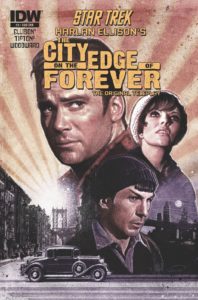 Ellison was never able to see it that way … at least not consciously. He was already used to producers changing his scripts, and on other shows had opted to use the name “Cordwainer Bird” to disown the ones he felt were butchered. That name honored Paul Linebarger’s nom de plume Cordwainer Smith, while giving the “bird” to the producers who ruined his work. Fontana’s naming of the super-stimulant that drives McCoy mad, “Cordrazine,” was clearly a preemptive acknowledgment that Ellison would probably react badly to how she was changing his work. (Viewers should thus understand McCoy’s Cordrazine-crazed “Murderers! Assassins!” as Fontana’s affectionate parody of Ellison’s imagined reaction to her script-doctoring.)
Ellison was never able to see it that way … at least not consciously. He was already used to producers changing his scripts, and on other shows had opted to use the name “Cordwainer Bird” to disown the ones he felt were butchered. That name honored Paul Linebarger’s nom de plume Cordwainer Smith, while giving the “bird” to the producers who ruined his work. Fontana’s naming of the super-stimulant that drives McCoy mad, “Cordrazine,” was clearly a preemptive acknowledgment that Ellison would probably react badly to how she was changing his work. (Viewers should thus understand McCoy’s Cordrazine-crazed “Murderers! Assassins!” as Fontana’s affectionate parody of Ellison’s imagined reaction to her script-doctoring.)
Despite the extensive rewrites, Roddenberry begged Ellison not to use his nom de plume on this episode. The success—indeed, survival—of his bold new series depended on the high-caliber names he was bringing to the project. In fact, the producer had already elicited Ellison’s aid in a letter-writing campaign to “save Star Trek.” It has been argued that it was the success of “City” specifically that led to the renewal of the show for a second season. Thus, Ellison’s script, and his name, became inextricably entangled with Star Trek and its success.
While his initial experience was certainly frustrating, Ellison’s ire mainly grew over the subsequent decades when, at Star Trek conventions and in interviews, Roddenberry persisted in saying that the rewrites of “City” were necessary because Ellison’s original script was poor and that “he had Scotty dealing drugs”—both of which were demonstrably false, as anyone reading the draft can attest. Roddenberry’s lies over the years helped turn Ellison’s entanglement with Star Trek and with everyone’s favorite episode into a kind of festering wound: It became a dark sun, one that he couldn’t walk away from.
A fixture at Trek conventions and friend of many of its cast, Ellison’s grievance over Roddenberry’s unprofessional behavior and the original script of “City” that might have been—which he never stopped asserting was far superior to what was filmed—became part of the Trek myth. It was eventually published, along with Ellison’s incendiary rant and supporting essays by Nimoy, Fontana, and other Trek staff and cast, in 1995. Then in 2014 a comic series was made based on it, with gorgeous art by J. K. Woodward and covers by Juan Ortiz and Paul Shipper.
Thus, Ellison’s name came to be indelibly associated with the show. And arguably, at least for the wider public, it may be “City on the Edge of Forever” that Ellison is best known for. It is certainly what I knew him best for, even before I was aware of any of this saga, and I had even read a lot of his other fiction as a teen. All his fiction is outstanding, but “City” is fairly or unfairly regarded as one of his masterpieces.
Here’s the thing: I think this big existential/creative clusterfuck, this big unfolding train wreck having to do with authorship and counterfactuals—what-ifs having to do with what he perceived as the ruination of his script, the “show that might have been,” and his good name appearing on what was really a collective creative effort—are precisely what his original script of “City” is about. In that story, he was vividly precognizing the “counterfactual neurosis” he suffered after it was rewritten and aired on April 6, 1967.
Mattering in the Time Flow
James Gleick argues in his book Time Travel that the SF premise of traveling back in time and undoing past mistakes is a way of dealing with trauma and regret. (“Regret,” he writes, “is the time traveler’s energy bar.”) The psychoanalytic term for regret and the counterfactual fantasies that repair our regrets is “castration.” That term is not just (or mainly) about lost genitalia. It is about being and nonbeing, having and losing, and fundamentally indeterminate there/not-there impossibility around which our desires and wishes revolve. The inner life of the neurotic is, one way or another, a confusing landscape of superimposed counterfactuals, “what ifs” and “what if nots” hovering over everything.
 As I argue in Time Loops, life’s castrations—episodes in which we gain something despite a loss, or lose something despite a gain—are precisely what the precognitive (i.e., time traveling) unconscious focuses on.
As I argue in Time Loops, life’s castrations—episodes in which we gain something despite a loss, or lose something despite a gain—are precisely what the precognitive (i.e., time traveling) unconscious focuses on.
Ellison’s script centers on a counterfactual situation involving the destruction (vs. rescue) of something pure and beautiful and innocent. Kirk, who has fallen in love with the do-gooder activist Edith, must override his urge to stop Beckwith from pushing her out of the way of an oncoming truck … thus restoring history and returning the Enterprise to that future sky, so our heroes can go home. In other words, the life of this innocent beautiful pure thing must be taken or mangled so that others may live and that history must resume the shape that it already has.
It is interesting, first of all, that key characters cut from Ellison’s story have a curious there/not there quality even in his script. First, it seems significant how much deal—bizarrely too much—Ellison’s story makes of the erasure/obliteration of the “evil” character Beckwith, who was replaced by the temporarily Cordrazine-addled McCoy in the filmed version. It’s like the script’s MacGuffin was written to disappear, first to be executed on the most desolate planet imaginable—it is described as being so lonely and hopeless in the dead of intergalactic space that the ship’s blinds are drawn to keep the crew from having to view it (seriously!)—and then at the end to be condemned to infinite deaths in the heart of a sun by the “wise” Guardians. They keep bringing him back only to destroy him again, and again, and again.
Careful readers of the original script will note an uncomfortable paradox about Beckwith and his punishment: Despite his depravity, it is Beckwith whose human impulse is to rescue Edith at the climactic moment of the story as Ellison told it: Impulsively, he rushes to save her as a truck barrels down on her. It’s not Kirk’s love for Edith that changes the past, in other words—an obvious premise for a lesser writer—but the angry, drug-dealing murderer. But with Kirk and Spock now on the scene to make things right, Beckwith is thwarted from redeeming himself.** His flickering there/not there quality is like the larger counterfactual premise in which he is embedded, as well as the counterfactual history of Ellison’s script itself.
Something similar is true of Trooper, the legless survivor of the battle of Verdun, who appears at the beginning of the final act of Ellison’s script. “He is a man destroyed,” Ellison writes. “The light has gone out in the eyes, the mouth speaks a silent sadness. Disillusioned. He was the drummer boy who went to war, and came back to find no one needed him.” A sympathetic Kirk offers a couple dollars to Trooper, who is selling apples on the street from his wheeled cart, to let him know if he sees an armed, unusually-dressed man—Beckwith—appear in the neighborhood. Later, when Kirk and Spock are out walking at night, the veteran lets them know that a man fitting that description is nearby. Beckwith ambushes them and fires his phaser, vaporizing Trooper, and then gets away. Spock is concerned about Trooper’s death, noting: “Any death in this era that alters the sum of intelligence … alters time permanently.” Saddened, Kirk adds, “If he mattered in the time-flow.”
Later, after the accident that kills Edith and Kirk and Spock bring Beckwith back to the future, the time guardians announce, “Time has resumed its shape.” The first thing Spock asks is “What of the death of the cripple?” “He was negligible,” the wise Guardians reassure Spock.
So here again: The veteran’s mutilated condition, then his literal phaser-vaporization within the story and the assurance that history remains unchanged despite his death, both prefigure his “castration” from the story itself as it was eventually filmed.*** He is created to be unnecessary, disposable. Interestingly, the creators of the five-part comic version of Harlan Ellison’s The City on the Edge of Forever depicted Trooper as Ellison—honoring the writer by depicting him as its most poignant character.
Did Ellison’s precognitive brain grasp his own “castration” already as he was writing the character of Trooper? It is almost as if, in writing this character, Ellison was channeling his future regret at capitulating to his nemesis Roddenberry over the issue of his real name appearing on the title card—not standing up to him, in other words. For the famously feisty Ellison, this uncharacteristic capitulation to a producer may have been the crux of his counterfactual neurosis, the regret that drove him repeatedly into the past to make things right.
“Let Me Help”
Another interesting “counterfactual” difference between “City” as it might have been in Ellison’s version and as it “really was” in the televised version happens to center on my favorite bit of dialogue in all Star Trek. As Edith and Kirk are out walking in the evening, on a date, she notes how otherworldly he seems and his difficulty talking about his past. First, here’s how it appears in Ellison’s script:
EDITH: Sometimes you seem, well, disoriented, Jim, like a man fresh from the country.
KIRK: Iowa?
EDITH: Further away than that.
KIRK: “When night proceeds to fall, all men become strangers…”
EDITH: It’s true. Who said it, I don’t recognize it.
KIRK: Wellman 9. An obscure poet. Someday people will call his work the most beautiful ever known in the galaxy.
EDITH: That’s a lot of territory.
It’s poetic and beautiful—indeed, like much of Ellison’s script. But now read the scene as it appeared in the filmed version:
EDITH: Whatever it is, let me help.
KIRK: Let me help. A hundred years or so from now, I believe, a famous novelist will write a classic using that theme. He’ll recommend those three words even over I love you.
EDITH: Centuries from now? Who is he? Where does he come? Where will he come from?
KIRK: Silly question. Want to hear a silly answer?
EDITH: Yes.
KIRK: A planet circling that far left star in Orion’s belt…
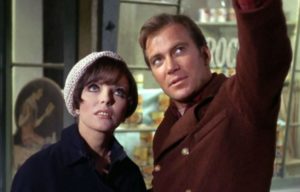 I don’t know whether it was Coon or Fontana (or Roddenberry) who wrote this beautiful scene. But note how the final version not only manages to substantiate Kirk’s enigmatical nature in poetic terms (as Ellison did), but also makes the scene romantic (it slips “I love you” in there) as well as expressing what Spock will later say in starker terms: “She was right, but at the wrong time.” Kirk so much as tells Edith here that her own ethic of helping really is the way of the future—beyond mere love between two people. Kirk’s soliloquy becomes about Edith, in other words, instead of about himself: She is ahead of her time, just as much as he is out of his.
I don’t know whether it was Coon or Fontana (or Roddenberry) who wrote this beautiful scene. But note how the final version not only manages to substantiate Kirk’s enigmatical nature in poetic terms (as Ellison did), but also makes the scene romantic (it slips “I love you” in there) as well as expressing what Spock will later say in starker terms: “She was right, but at the wrong time.” Kirk so much as tells Edith here that her own ethic of helping really is the way of the future—beyond mere love between two people. Kirk’s soliloquy becomes about Edith, in other words, instead of about himself: She is ahead of her time, just as much as he is out of his.
My point is by no means that Ellison is a lesser writer than Coon or Fontana; he came up with the story, and he came up with the scene. It is simply that, like all good script revisions, a good idea is often refined further to become great. Behind many great writers there is also a great editor.
One has to wonder how much of the darkness and conflict in Ellison’s story, such as the dripping-with-cruelty punishment of Beckwith, or even the line about all men becoming strangers, reflected his own future conflicted feelings the “impossible” situation his script for “City” had put him in as an artist, because of the way his original creation differed from what audiences saw. Although the core premise and situation of “City” is every bit Ellison’s genius, much of what was shown in the episode was someone else’s. Besides the scene about “Let me help,” those “not Ellison” parts include also its most famous and memorable lines like “stone knives and bearskins” and “Edith Keeler must die.” Yet there’s Ellison’s name, in bold yellow letters right in the title credits. Taking (or being given) credit for other people’s good work is just as uncomfortable for a serious artist as having one’s words mangled or changed for the worse.
Having Our Cake…
The psychoanalytic essayist Adam Phillips almost sounds as if he has Ellison specifically in mind when he writes in his book Missing Out that “what was not possible all too easily becomes the story of our lives. Indeed, our lived lives might become a protracted mourning for, or an endless tantrum about, the lives we were unable to live.”
Again, Ellison maintained to the bitter end that his script was far superior to what Star Trek audiences saw that April night in 1967 (and endlessly on reruns in the 1970s), and he always promoted his script as the “City on the Edge of Forever” that should have been. But the thing about counterfactuals, about worlds and lives that might or should have been, is their disingenuousness. They are predicated on changing some nagging detail that bugs us, but without facing all the many consequences that would inevitably arise from making such a change in the real world. They are about having our cake and eating it too.
When you read Ellison’s bilious rants about Roddenberry and his Star Trek experience, his tirades against the talentless hacks who make life a living hell for writers, his scorn for idiot actors and the “bimbo queen” Joan Collins who tarnished his pure character Edith with her steamy reputation, the phrase “protests too much, methinks” comes to mind. Indeed, protests too much against a reality that really favored him in many ways.
There is no doubt Roddenberry lied and behaved unprofessionally, and for that, Ellison was right to feel aggrieved. But where is the acknowledgment that Star Trek and “City” were important and even central features in his life? Where is the acknowledgment that sometimes producers make the right decisions with scripts and that simplifying his sprawling story made it filmable? A reality of writing for the TV and film industry is that scripts are rewritten—and yes, sometimes badly. But the success of “City” as it was filmed—it won a Hugo award and was listed by many fans, cast, and crew as their favorite Trek episode—attest that the rewrites and other creative decisions made by Roddenberry’s team did not hurt this particular episode one bit. Quite the opposite.
The situation here is very similar to that of Joan Lindsay’s Picnic at Hanging Rock: Had changes not been made to the original story, it either would not have been published or filmed, or it would have failed to gain a huge following. An unfilmed or poorly produced “City” would have failed to win the hearts and minds of audiences and thus would have failed to help sustain the ship of Star Trek into a second season … and then sustain ongoing interest of the fans. The same may be true had Ellison’s name not been attached to it. In either case, he would not have been associated—angrily or pleasantly—with the show and its enormous fan base and success over the next decades and for the rest of his life. (He was a regular feature at those Trek conventions.)
The disingenuous of Ellison’s later-life reflections on “City”—and I think, his deep-down awareness of their disingenuousness—are encoded, precognitively, right in the script’s basic “grandfather paradox” premise: that one person could change the past and that his shipmates could pursue him and undo or nullify his action. I mean, any ten-year-old can see, and does see on some level, that if the past has been altered to the extent that there’s no more Enterprise in orbit, there can’t be a Kirk and Spock and landing party standing there in front of the Guardian of Forever either. (This glaring problem was even more obvious in Ellison’s script, where the landing party beams back up to a different ship, now a pirate vessel manned by criminals; what are the odds that in the altered timeline an evil counterpart to the Enterprise just happened to be overhead?) Moreover, it is precisely while on a date with Kirk that the truck runs Edith over and that Beckwith (in Ellison’s version) or McCoy (in the final version) can be thwarted by our heroes from saving her.
The counter-history, in other words, depends on the “real” (or corrective/corrected) history at every turn. These problems stood out like sore thumbs in Ellison’s original script and would have made it that much harder to suspend disbelief. The rewrites hid them more effectively, but they are still there in the basic premise.
Our thoughts about how reality might be different unfold within this reality as it is. It is this easily forgotten fact that can serve as the “cipher key” of precognitive art, symptoms, and dreams.
Soldier
It is often time gimmicks of one sort or another that are the dead tip-off that some sort of real time loop by way of precognition may be occurring in an artwork as much as in a dream. It is interesting that while Ellison wrote a wide range of stories, and not only science fiction, he may be best known for three TV scripts about time travel: one that became an ongoing source of frustration into his future (“City”), another that resulted in a plagiarism suit, and a third that got associated with another filmmaker’s later work by association. All three involve future conflicts displaced or transposed into the past.
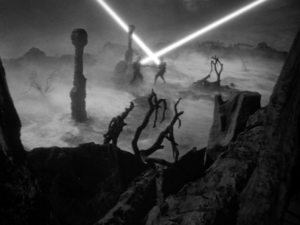 In 1964, Ellison adapted one of his short stories (“Soldier from Tomorrow”) for the series The Outer Limits. This episode, “Soldier,” starred Michael Ansara (whom Trek fans will recognized as the Klingon Commander Kang from “Day of the Dove”) as a future warrior named Qarlo Clobrigny who accidentally slips back through time to 20th Century LA, followed by an unnamed enemy soldier intent on finding and killing him. The opening scene of this episode (a post-apocalyptic battlefield with rayguns cutting through the night sky), and its basic premise (future warriors pursuing each other into the past), are virtually identical to James Cameron’s Terminator two decades later. When someone alerted Ellison to this similarity even before the film was released, he managed to get a look at the film in an early screening and sued the production company and distributor. Part of the evidence supporting Ellison’s claim of plagiarism was that Cameron had admitted in an interview with Starlog magazine that his story was inspired by some old Outer Limits episodes. A settlement was reached that included a credit to “the works of Harlan Ellison” in the home video version.
In 1964, Ellison adapted one of his short stories (“Soldier from Tomorrow”) for the series The Outer Limits. This episode, “Soldier,” starred Michael Ansara (whom Trek fans will recognized as the Klingon Commander Kang from “Day of the Dove”) as a future warrior named Qarlo Clobrigny who accidentally slips back through time to 20th Century LA, followed by an unnamed enemy soldier intent on finding and killing him. The opening scene of this episode (a post-apocalyptic battlefield with rayguns cutting through the night sky), and its basic premise (future warriors pursuing each other into the past), are virtually identical to James Cameron’s Terminator two decades later. When someone alerted Ellison to this similarity even before the film was released, he managed to get a look at the film in an early screening and sued the production company and distributor. Part of the evidence supporting Ellison’s claim of plagiarism was that Cameron had admitted in an interview with Starlog magazine that his story was inspired by some old Outer Limits episodes. A settlement was reached that included a credit to “the works of Harlan Ellison” in the home video version.
Cameron didn’t agree with the settlement, but it is obvious, watching “Soldier,” that his film did borrow from it (perhaps unconsciously). Could it also be the case that “Soldier” was precognitively inspired by Terminator—or rather, by Ellison’s uncomfortable encounter with that film—two decades hence? I find it odd that, here again, a story involving time travel, centering on a clash between two mighty foes chasing each other into the past, also resulted later in hard feelings between Ellison and a bigshot director that pertained directly to questions of originality and authorship.
Time travel stories are stories about origins. The linguist who studies Qarlo and takes him into his home determines that he has no family—no parents (he was, he reveals, raised in a “creche hatchery”). The unparented, the unborn, the truly original, with which we are led to sympathize, is pursued into the past by an enemy. Is this not a little like how Ellison might have seen Cameron’s apparent plundering of his 20-year-old “Soldier”?****
Even more uncannily, just as Trooper is depicted as legless in Ellison’s original “City” script, the pursuing unnamed future warrior in “Soldier” is trapped for most of the episode between times, struggling with his legs still in the future while his upper body is in the past. He literally struggles, legless, to free himself from his limbo throughout the episode.
People who are vaguely aware of Ellison’s legal wrangling around Terminator sometimes confuse or conflate “Soldier” with another, even better (and stranger) Outer Limits episode Ellison also penned in 1964, called “Demon with a Glass Hand.” This episode is about a mystery man named Trent, played memorably by Robert Culp, who is pursued to 20th Century Los Angeles from the far future by alien Kaibans, bent on exterminating the last survivor of the human race. Trent is fitted with a glass hand, a computer whose memory is contained in missing fingers that he must obtain from the Kaibans who are pursuing him. In the end, having finally recovered all his fingers, the computer reveals that he himself is an android whose torso contains the memory of the entire human race on a copper wire—he must wait 2000 years for their memory to be reconstituted.
 The possible confusion with the Terminator story here is the role of the hand—recall that Terminator 2 is premised upon the attempt to back-engineer technology recovered from the arm of the original robot assassin left behind in the past. But what a viewer of “Demon” today will be stunned by is the familiarity of the setting: The action takes place in the Bradbury Building in Los Angeles, which is where the climax of Blade Runner also takes place. Watching “Demon” now is like a weird B&W déjà vu, “revisiting” this gorgeous Victorian building with its wrought iron railings and its elevators. Like in Blade Runner, some of the action takes place in its attic and on its roof. And like Blade Runner’s climactic scenes with a fixation on hands that are mangled or maimed (Deckard’s broken fingers, Roy Batty’s self-impalement), “Demon” also centers on images of Trent’s glass hand that is disturbingly incomplete, missing some of its digits.
The possible confusion with the Terminator story here is the role of the hand—recall that Terminator 2 is premised upon the attempt to back-engineer technology recovered from the arm of the original robot assassin left behind in the past. But what a viewer of “Demon” today will be stunned by is the familiarity of the setting: The action takes place in the Bradbury Building in Los Angeles, which is where the climax of Blade Runner also takes place. Watching “Demon” now is like a weird B&W déjà vu, “revisiting” this gorgeous Victorian building with its wrought iron railings and its elevators. Like in Blade Runner, some of the action takes place in its attic and on its roof. And like Blade Runner’s climactic scenes with a fixation on hands that are mangled or maimed (Deckard’s broken fingers, Roy Batty’s self-impalement), “Demon” also centers on images of Trent’s glass hand that is disturbingly incomplete, missing some of its digits.
Here again, is sci-fi causality simply proceeding in the usual, billiard-ball direction, with a more modern filmmaker (Ridley Scott in this case) paying homage to a brilliant predecessor? Or is there a degree of bidirectional causality going on too? Did Ellison’s time travel scripts fractally reflect his later mixed feelings over the role of those scripts in his life, which by then appeared as forgotten ghosts haunting big science fiction blockbusters?
There is no way to answer these kinds of questions definitively, and we cannot ask Ellison about it because he passed away in June of last year. But in my experience with dreams and writing, time travel is a conveniently gimmicky way for the precognitive unconscious to package an idea or a feeling that comes from one’s future. I suspect Ellison, at least in these famous time-travel stories, was drawing on his future conflicts with other artists as well as with his future self, as the source and wellspring of his creativity.
2+2=4
A psychoanalyst professor of mine used to relate a piece of professional lore that applies to a conflicted person like Ellison, or to anyone insofar as we are conflicted: A normal person says “two plus two equals four.” A psychotic person says “two plus two equals five.” But a neurotic person says “two plus two equals four … and I hate it.” The moment of cure in psychoanalysis is equivalent to becoming able to say that two plus two equals four without screwing one’s face into a grimace—an acceptance of reality as it is, without nursing the kinds of counterfactual fantasies that consume so much of our inner energy.
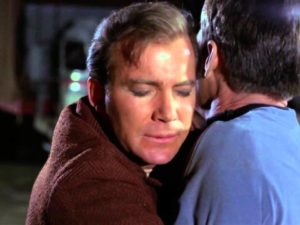 The Zen experience of “suchness” or tathata, is identical to this almost euphoric satisfaction of things being just as they are. In other words, nothing is different, but suddenly I don’t need to worry so much about it. I don’t need to mentally rummage in the past to correct things that can’t be fixed anyway. And I don’t need to stress out that my actions now might lead to a future that will compare unfavorably to one in my imagination.
The Zen experience of “suchness” or tathata, is identical to this almost euphoric satisfaction of things being just as they are. In other words, nothing is different, but suddenly I don’t need to worry so much about it. I don’t need to mentally rummage in the past to correct things that can’t be fixed anyway. And I don’t need to stress out that my actions now might lead to a future that will compare unfavorably to one in my imagination.
The Guardian of Forever in the famous, filmed version of “The City on the Edge of Forever” has its own way of pronouncing the psychoanalytic cure, or tathata, and one that is even more poetic: Upon Kirk, Spock, and McCoy’s return to the future, it announces: “All is as it was before.”
All is as it was before. It is a deeply reassuring statement to the rest of the landing party, who barely noticed Kirk and Spock were gone (from their vantage point, they had only been away a minute or two) and now find the Enterprise hailing them from orbit. It is not totally reassuring to Kirk, smarting (to put it mildly) from the pain of losing Edith Keeler. But restoring time to its normal shape is often painful, even while it is freeing—regaining one’s “legs,” so to speak, or one’s ship. You are free to move on.
It enables you to say, as Kirk does at the end of “City”: “Let’s get the hell out of here.”
Personal Postscript
I’ve been putting off writing about “City” for a long time. It is such a powerful myth in my own life that I am almost superstitious about it. It initially aired exactly one month after my birth, and it is indelibly etched in my brain from a childhood steeped in Star Trek reruns. Over the years I have had significant, powerful dreams that centered on motifs and objects from this episode. These dreams were not about that episode—why would evolution equip us with a brain that obsessed over old television shows?—rather, like all dreams, they were using its elements and themes as symbols to represent concerns in my life then and even, I think, thoughts from my future. Those thoughts including some of the ideas about time, time loops, and counterfactuals that have been obsessing me in the past year or so.
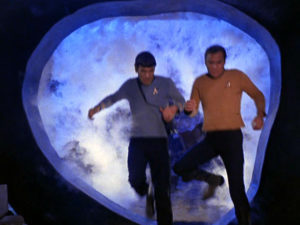 Another, equivalent way of looking at it is that these present thoughts—even this blog post—shaped me in my past, even decades ago, via those dreams.
Another, equivalent way of looking at it is that these present thoughts—even this blog post—shaped me in my past, even decades ago, via those dreams.
For example, Spock’s radio-tube contraption as a kind of “counterfactual detector” has been a recurring theme in my dreams over the years. It is often conflated or mashed up with an old tube amp I purchased at a music store on Pearl Street in Boulder, Colorado, in my freshman year of college and very regretfully swapped for a less cumbersome solid-state one a couple years later. (Both amps are now long gone from my life.) This “amp that might have been” (always threatening to overheat, as Spock’s does) has reappeared in dreams over the years in connection with counterfactual situations, sometimes with a “time gimmick” involved. In one dream, for example, I used the device to play a heavily distorted version of the Doctor Who theme song. That too was years before I knew I’d be devoting a significant chunk of my life to the study of time and our mental travel through it.
In another powerful dream from 1995, I made an initiatory journey through a stone loop in a wild landscape toward a plaster mastodon (ancient bones in a cast), prefiguring by more than two decades my parapsychological interest in time loops and the autobiographical project of dream paleontology … and possibly even prefiguring my recent reading of Ellison’s teleplay, which includes a mastodon appearing in his time portal.
The lesson of time travel is that the past cannot be changed from what already is, but that it can be (and always was) created by us in the present. As we move through life, especially as we become increasingly conscious of our four-dimensional nature (our “long body”), we can ongoingly unearth evidence of how our experiences and thoughts now contributed to who we were and what we did then. This mindblowing perspective on our biographies will increase as we become more culturally comfortable with retrocausation. With that comfort will come the setting aside of security blankets like “many worlds” and multiverses that let us have the cake of our exquisite regrets (like foolishly getting rid of that totally sweet tube amp) and eat them too.
NOTES
* I’m obviously somewhat biased in favor of “City” as it was filmed, but one regret about the version that might have been is that Ellison had written such a good scene for Yeoman Rand, fighting to keep the pirates at bay aboard the renegade ship Condor. Grace Lee Whitney, who played Rand, had already been let go from the series by the time this episode shot, however. In a counterfactual history where Whitney was still with the series, her role would probably have been reduced to the one Nichelle Nichols’ Uhura had to play in the filmed version, delivering it’s most cringeworthy line: “Captain, I’m frightened.” The gender backwardness of the series must be acknowledged.
Also, the circumstances around Whitney’s dismissal cast even poorer light on Roddenberry, and may even have added an unspoken dimension to Ellison’s anger at Roddenberry over the ensuing decades. What really happened has been the subject of much controversy, but the general picture that emerges was the kind of thing that has become all too familiar in our Me Too era: Whitney claims she was raped by one of the producers—some figure, from hints in her memoir, that it was Roddenberry himself. Almost immediately after this happened, Roddenberry allegedly capitulated to pressure from the studio to cut her character due to the perception that she made Kirk seem less available. Whitney was devastated, but claimed that she ultimately forgave Roddenberry. Whitney returned to the franchise for roles in several of the films.
According to his biographer Nat Segaloff, Ellison and Whitney had been dating in the years before he wrote his episode for Star Trek. Ellison later contended that the “studio pressure” to dispense with the character of Yeoman Rand was really pressure from Majel Barrett (Nurse Chapel), who was at that point having an affair with Roddenberry and was jealous of Whitney.
Yes, Star Trek was really a soap opera. Did I mention Marc Cushman’s These Are the Voyages is essential reading?
** In Ellison’s version, Kirk himself is too conflicted to stop Beckwith, so Spock is the one who has to intercede.
*** The filmed version contained instead a scene of an anonymous homeless man who witnesses McCoy’s emergence in the past and who manages to get his phaser. He accidentally destroys himself with it—and here again, the heartless presumption of the story is that “he doesn’t matter” in the sum of intelligence of the universe.
**** Viewers of “Soldier” today will also be stunned at how much parts of it resemble the movie Arrival—indeed, almost as if the filmmakers were unconsciously borrowing from Ellison’s old Outer Limits episode, just as Cameron had done when he made Terminator. As in Arrival, the story begins with the recruitment of a linguist by a government agency to help translate the words of the captured Qarlo, with the plot centering on the linguist’s gaining the mysterious man’s trust.
SOURCES
Marc Cushman, These Are the Voyages, Vol. 1. San Diego, CA: Jacobs Brown (2013).
Harlan Ellison, The City on the Edge of Forever. New York: Open Road (1995).
Harlan Ellison, Scott Tipton & David Tipton, J. K. Woodward, Harlan Ellison’s The City on the Edge of Forever: The Original Teleplay (5 issues). San Diego, CA: IDWPublishing (2014).
James Gleick, Time Travel: A History. New York: Pantheon (2016).
Adam Phillips, Missing Out: In Praise of the Unlived Life. New York: Picador (2012).
Nat Segaloff, A Lit Fuse. Framingham, MA: NESFA Press (2017).
Wormholes, Freud, and Jacob the Dreamer
In the 1980s, when the possibility of wormholes began to capture physicists’ imaginations, there was the inevitable concern about what such objects might mean for causality in an Einsteinian, time-elastic universe. Wormholes through space meant, inevitably, wormholes through time. And so, naturally, people thought of the grandfather paradox, that strange fantasy of killing one’s patriarchs that is the big stumblingstone for rational people when trying to countenance the idea of time travel. Killing one’s grandfather or (Oedipally) one’s father, though, boils down to a fantasy of self-negation; so, when physicists model this problem, it is more convenient to cut out the patriarchal middlemen and ask about the neurotic possibility of self-inhibition or (more extremely) suicide in time-traveling objects.
In the early 1980s, a Russian physicist named Igor Novikov worked out that physical law would actually prevent any such self-inhibition, that in fact a principle of self-consistency would govern a wormhole-riddled universe. Even if an object could enter a wormhole at some time point B and emerge earlier, at some time point A, it could never actually interfere with its own entry into the wormhole at that later time point B. Two Caltech students of black hole and wormhole expert Kip Thorne checked and found that Novikov was right: First, a time-traveling billiard ball cannot take the place of its younger self—a kind of “exclusion principle” would prevent that (more on which in a future post). Instead, what happens is the time-traveling object encounters its earlier self and interferes in such a way that its later entry into the wormhole is actually facilitated.
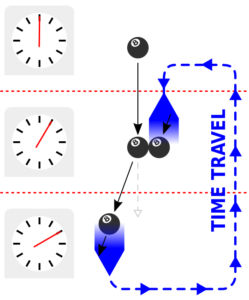 All possible paths of a billiard ball entering a wormhole later (bottom, in graphic at right) would in fact, upon exiting the wormhole earlier (top), nudge itself into the mouth of the wormhole later, thus completing the causal tautology, or what physicists call the closed-timelike curve. These days, quantum physicists use the idiom of “post-selection”—a kind of informational-causal Darwinism which ensures that the only information that survives its journey into the past is information that does not foreclose its origins in the future.
All possible paths of a billiard ball entering a wormhole later (bottom, in graphic at right) would in fact, upon exiting the wormhole earlier (top), nudge itself into the mouth of the wormhole later, thus completing the causal tautology, or what physicists call the closed-timelike curve. These days, quantum physicists use the idiom of “post-selection”—a kind of informational-causal Darwinism which ensures that the only information that survives its journey into the past is information that does not foreclose its origins in the future.
My book Time Loops touches lightly on the physics of time-traveling billiard balls and quantum informational reflux into the past, but it delves mainly into the psychodynamic principles governing time-traveling information in our tesseract brains. It is no coincidence, I think, that the associative laws of the unconscious work so nicely to prevent paradox in beings who are subject much more than we know to premonitions and who are constantly guided by a kind of presentimental orientation toward future rewards. The unconscious, I suggest, is just ordinary conscious thought displaced in time. Paradox is prevented by the very nature of the rules that allow information to reflux into the past, specifically the limitations on making that refluxing information meaningful as opposed to noise.
Dreams offer the best example for what I’m talking about. A typical precognitive dream is an oblique and indirect associative halo around some future experience or train of thought; its exact relationship to that experience or train of thought only becomes clear in hindsight. There are apparent exceptions: more obvious premonitions that may even be almost “video-quality” in their transmission backward of some future scene (I believe this is exactly what sleep-paralysis episodes and “out of body experiences” may in fact be*); but even in those cases, the “metadata” of the transmission is always lacking: the when, where, and how, as well as the meaning, or how the event fits into the ordinary course of life. One way or another, the information that arrives from the future in dreams and altered states is garbled or incomplete and thus cannot be used to foreclose the inciting experience.
Could the laws preventing billiard balls from interfering with themselves in wormholes offer us a new way of thinking about the processes of distortion in dreams?
Irma’s Injection
The mechanisms that control the back-flow of information in the tesseract brain are probably not as picturesque as spacetime-bending wormholes—I suggest they probably will turn out to have something to do with quantum computation controlling brain plasticity (the constantly updated strengths of neural connections). But whatever the ultimate explanation, the principles are similar: Our future conscious thoughts interfere with us in the present and deflect us just the right way so we end up having those future thoughts at just the right time, creating time loops in our lives.
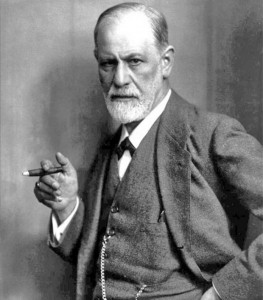 The best example of this happens, not coincidentally, to be one of the most famous and influential dreams in history: Freud’s “specimen dream” about “Irma’s Injection” in Chapter II of The Interpretation of Dreams. I discuss this dream at length in my book, but the short version is this: In 1895, Freud dreamed he was examining a patient and childhood friend of his, Anna Hammerschlag, whom he gave the name “Irma” to protect her anonymity. In real life, Anna’s problems were purely psychological (“hysteria”), but when Freud’s dream-self looked inside her mouth, he saw a white patch and scabs on her cheek and palate and a feature that should only have been visible in the nose. It was hard to get her to open her mouth—she acted like a woman shy because of wearing dentures. He summons a trio of physician friends to have a look—they poke and prod and pompously mansplain, like stereotypical Victorian doctors—and lastly Freud’s dream-self concludes that what caused Irma’s oral malady was an injection administered thoughtlessly, with a dirty syringe, by one of those friends, his family pediatrician, whom he gave the pseudonym “Otto.”
The best example of this happens, not coincidentally, to be one of the most famous and influential dreams in history: Freud’s “specimen dream” about “Irma’s Injection” in Chapter II of The Interpretation of Dreams. I discuss this dream at length in my book, but the short version is this: In 1895, Freud dreamed he was examining a patient and childhood friend of his, Anna Hammerschlag, whom he gave the name “Irma” to protect her anonymity. In real life, Anna’s problems were purely psychological (“hysteria”), but when Freud’s dream-self looked inside her mouth, he saw a white patch and scabs on her cheek and palate and a feature that should only have been visible in the nose. It was hard to get her to open her mouth—she acted like a woman shy because of wearing dentures. He summons a trio of physician friends to have a look—they poke and prod and pompously mansplain, like stereotypical Victorian doctors—and lastly Freud’s dream-self concludes that what caused Irma’s oral malady was an injection administered thoughtlessly, with a dirty syringe, by one of those friends, his family pediatrician, whom he gave the pseudonym “Otto.”
After free-associating on this dream’s various elements, Freud concluded that the “latent dream thought” embedded in this tableau was a wish that he be innocent of any failures or malpractice in his treatment of Anna (malpractice was going around in his medical circle at the time) and that Otto instead be the one at fault for the fact that, in real life, his friend Anna had not improved despite his psychoanalytic treatment. It was this dream that led Freud to the famous, controversial conclusion that all dreams are the disguised fulfillment of repressed wishes.
In 1982, a Brazilian psychoanalyst and cancer surgeon named Jose Schavelzon noticed something amazing: The precise symptoms displayed in dream Irma’s mouth matched the progression of oral cancer that Freud himself suffered nearly 3 decades later: a white patch, followed by scabs in the aftermath of increasingly invasive surgeries and radiation treatments; surgeons had to remove part of his jaw and palate, which exposed his nasal cavity to view inside his mouth—it would have exposed precisely the feature he thought he could see in “Irma’s” mouth. It became hard for Freud to open his mouth once a denture-like prosthetic was fitted, and he could only barely talk for the last decade and half of his life. The “Irma dream” seems, in other words, like a premonitory dream about the grave illness that severely impeded Freud’s quality of life in his old age.
The premonitory nature of this dream has been discussed by other writers such as Robert Moss and Larry Dossey, but I think we should go farther: This dream needs to be re-read as representing/dramatizing a set of conscious thoughts (and wishes) Freud would have had in 1923, following his cancer surgeries, rather than “unconscious” wishes belonging to the year 1865 when he had the dream.
When bad things happen to good people, even good people may find themselves wishing the bad thing had happened to someone else. We have no proof, obviously, but Freud’s thoughts in 1923 and later may well have included a vague wish that someone else and not him might suffer the awful cancer and brutal surgeries he was enduring. In any case, we can be quite confident that his thoughts at this point in his life would certainly have included a self-reproach for not following the urging of his best friend Wilhelm Fliess (another in that physician trio), who in 1895 had been trying get him to quit smoking his cigars for the sake of his health. In fact, Freud had just relapsed from a short period of abstinence just before having the dream and was specifically worried what his friend would say—this may have even sparked the temporal “short circuit” with his later situation. That situation was caused, one will note, by something symbolically very like a “dirty syringe.” Freud’s dream-self reproaches his patient “Irma” with the very words he might have consciously directed at himself: “You know, it’s really only your own fault.”
Most importantly, I argue, Freud could not have been blind, in 1923, to the similarity between what was happening in his own body then and the symptoms Irma had displayed in the dream 28 years earlier that wound up putting him on the scientific map. Thus, his thoughts would have returned to that dream and included a wish that he had been correct that dreams (especially that one fateful dream) are really “just” wish-fulfillments and not premonitions of future events. That dreams could predict the future was a common folkloric belief that, throughout his career, he took every opportunity to disclaim and debunk, but how could this coincidence not have unsettled that outward certainty? Wishing he was right about dreams being just wishes would effectively wish away his cancer as well as put himself above any professional reproach for having misled the world about the meaning of our dreams.
It is precisely the kind of situation Freud found himself in in following 1923—surviving, but at a cost—that precognitive experiences typically focus on. Dreams seem to navigate us through perilous shoals in life, ironic and unsettling ordeals (usually much more minor ones) where we come out the other end changed and, typically, humbled.
Psychic 8-Ball
How do wormholes fit in to all this? Remember that time-traveling billiard ball, deflecting the path of its earlier self so that it nudges itself into the wormhole, completing the loop. Freud noted that dreams commonly saddle others with our own unwanted predicaments and “give” thoughts we don’t want to acknowledge having to other people in our lives. This fact has been noted again and again in other dream theories, but Freud’s theory explicitly framed it in terms of “defense mechanisms” such as projection and displacement. The unacceptable thought struggling to be expressed is deformed and sent off course by a kind of “psychic” (in the older sense of the term) force field, a kind of deflection.
 By the laws of self-consistency and post-selection, Freud’s dreaming brain saw fit to deflect his symptoms onto someone close enough to him to be highly salient. (In Time Loops, I discuss various reasons why his friend Anna Hammerschlag fit the bill), but in such a way that its premonitory nature would not and could not have occurred to him … until it was too late. One of Freud’s biographers noted that various other maladies of dream Irma and discussed by the physician trio were actually Freud’s own illnesses at the time he had his dream—rheumatism, intestinal issues, etc.—so their inclusion in a bundle with his later cancer makes perfect sense.
By the laws of self-consistency and post-selection, Freud’s dreaming brain saw fit to deflect his symptoms onto someone close enough to him to be highly salient. (In Time Loops, I discuss various reasons why his friend Anna Hammerschlag fit the bill), but in such a way that its premonitory nature would not and could not have occurred to him … until it was too late. One of Freud’s biographers noted that various other maladies of dream Irma and discussed by the physician trio were actually Freud’s own illnesses at the time he had his dream—rheumatism, intestinal issues, etc.—so their inclusion in a bundle with his later cancer makes perfect sense.
In short: Freud’s most famous dream was like a billiard ball sent back to his younger self by his 68-year-old brain. The big 8-ball in his life that deflected him onto being the great pioneer of the new method called psychoanalysis was itself a wish from his future self that he’d done a few things different when he was younger, including being less adamant that dreams were only disguised fulfilments of repressed wishes. It was a corner he could not back himself out of. This is why I say that it was “not coincidental” that his most famous and significant dream happened to center on the most grave circumstance of his later life: It had to be a particularly powerful and significant shot to deflect him in just the right direction, that many years before.
There are many other looping dimensions to this dream—it’s a veritable temporal-biographic clusterfuck, and you’ll need to read Chapter 9 of my book for all the amazing details. And it couldn’t really have been clearer than it was. Freud could not have had a crystal-clear (or video-quality) premonition of his own cancer that terrified him into quitting smoking, because then he wouldn’t have gotten cancer, and thus wouldn’t have had the dream. His dream, and in some sense his whole career—indeed his “immortality”—depended on that outcome, and the specific ways in which he misinterpreted it from his younger vantage point.
A principle could be formulated here: Our blindness to our precognitive nature is what leads us to having the experiences our dreams precognize. There are still many open questions: Is it the message itself that is distorted in its backward temporal passage, or is it our conscious interpretation of those pieces of mail from our future self that distorts their message? In other words, is the dream itself a misinterpretation of a clear retrograde signal or is the signal itself distorted in its backward passage, or both?
Jacob’s Bum Hip
In artistic and critical contexts, the defense mechanisms that protect the ego by deforming our thoughts and actions are sometimes called tropes, “turnings,” or what Harold Bloom calls swerves. These are good terms: Instead of having a dangerous realization, our thoughts deviate onto a safer path, and we only feel a troubling anxiety, like our hair standing on end from a nearby electric field. It is not an accident that Freud’s famous time-traveling archetype Oedipus walked with a limp—in fact, it’s the etymological meaning of his name (“swollen foot”). Like a shopping cart with one stuck wheel, the dreaming self swerves in its avoidance of thoughts that will cause trouble (thoughts like Freud’s famous “wanting to sleep with your mother”). On its own, the mind wants to go in circles of rationalization and denial rather than press forward into uncharted and dangerous territory. This is the repetitive, “orbiting” behavior of the neurotic symptom.
It so happens that one of the most famous Biblical dreamers, Jacob, also swerved, because of a dream. I’m not referring to his famous dream of angels ascending and descending a ladder to heaven. The more decisive episode in this trickster-shaman’s life is his all-night wrestling match on his return trip from Canaan, with a shadowy, silent figure on the banks of the river Jabbok.
The same night he arose and … crossed the ford of the Jabbok. … And a man wrestled with him until the breaking of the day. When the man saw that he did not prevail against Jacob, he touched his hip socket, and Jacob’s hip was put out of joint as he wrestled with him. Then he said, “Let me go, for the day has broken.” But Jacob said, “I will not let you go unless you bless me.” And he said to him, “What is your name?” And he said, “Jacob.” Then he said, “Your name shall no longer be called Jacob, but Israel, for you have striven with God and with men, and have prevailed.”
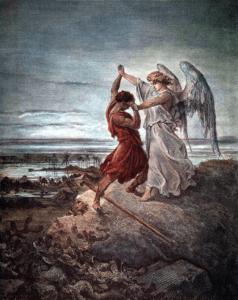 Rule #1 of myth interpretation is that any ordeal that “lasts all night” and ends with the sunrise is referring to a dream. Jacob encountered and struggled with what he thought was God in his dream. Was it God or was it his own future self? Could the former not be our misrecognition of the latter? Philip K. Dick suggested this, and so did precognitive-dream pioneer J. W. Dunne, for whom our dreaming higher consciousness was equivalent to the God of the mystics. Whoever Jacob wrestled with, it left him with a limp.
Rule #1 of myth interpretation is that any ordeal that “lasts all night” and ends with the sunrise is referring to a dream. Jacob encountered and struggled with what he thought was God in his dream. Was it God or was it his own future self? Could the former not be our misrecognition of the latter? Philip K. Dick suggested this, and so did precognitive-dream pioneer J. W. Dunne, for whom our dreaming higher consciousness was equivalent to the God of the mystics. Whoever Jacob wrestled with, it left him with a limp.
Again, it may be that we misrecognize our own future experiences and thoughts and wishes in our dreams, and thus take oblique and even mildly self-destructive paths in our lives, precisely to the extent that we cannot recognize ourselves in them and still remain self-consistent. Moreover, our swerves to avoid self-recognition, the defense mechanisms that distort our reasoning (the debased modern word, infected with an arrogant scientism, is “bias”) may be the more extreme the more our fate is spectacular. The patriarch Jacob’s fate was highly significant—he assumed the name “Israel” after this dream, after all—and his displacement by his backward-traveling-billiard-ball future self felt like no less than a struggle with the Creator. Freud’s fate was spectacular too—I would argue, deservedly so, despite many missteps and mistakes along his path—and his defensive swerving was also spectacular and multidimensional, as I show in my book. But we all have it in us to be pioneers in exploring and laying claim to our own country. We all have it in us to be Jacobs.
How do you claim ownership of your life? Go back to your dreams, the ones you have never forgotten and may even have written down, yet naturally imagine could not have any relevance to little you, right now, today. I have found not only in my study of famous writers’ dreams but also in my own humble dream life that the “biggest” dreams, the ones that might even have inspired us in a decisive course of action or study, often reach across years of our lives; they were big precisely because they have to do with the ways we return to them or reflect on them much later. Your initially unrecognized reflection may seem especially huge and symbolically complex in an old dream, like looking at yourself in a parabolic mirror.
Look at your old dreams again with new, Freudian eyes, but leave aside Freud’s defensive admonition that dreams never show us our future. He was right about their characteristic swerves, but he was wrong in denying their time-defying character.
The Question
The reality of precognition in our lives (a constant reality, I argue, to which occasionally noticed precognitive dreams gives just a taste) offers a totally new way of looking at the basic question Freud posed most clearly for our time: Why do we know ourselves so poorly? What accounts for the vastness of our un-conscious? If we are getting glimpses of our future, shouldn’t we know ourselves better?
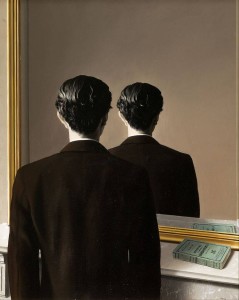 Maybe the whole question of self-knowing is wrong, or wrongly posed. Freud operated within the classical assumption of the mind as a mirror of the world. It goes by many names—representationalism, for one—but the basic assumption was that ideally the mind should reflect reality, including the pre-existing reality of who we ourselves are. To explain our foibles and irrationality, Freud appealed to our baser instincts and desires that were incompatible with our socialized egos. In our repression of facts we don’t want to face about ourselves, we distort that mirror … and it ends up distorting everything else along with it.
Maybe the whole question of self-knowing is wrong, or wrongly posed. Freud operated within the classical assumption of the mind as a mirror of the world. It goes by many names—representationalism, for one—but the basic assumption was that ideally the mind should reflect reality, including the pre-existing reality of who we ourselves are. To explain our foibles and irrationality, Freud appealed to our baser instincts and desires that were incompatible with our socialized egos. In our repression of facts we don’t want to face about ourselves, we distort that mirror … and it ends up distorting everything else along with it.
But as Richard Rorty argued in his now-classic Philosophy and the Mirror of Nature (in a perhaps unconscious transmission of the sixth Zen patriarch Hui-Neng, whose two-word version was “What mirror?”), maybe that mirror itself is the problem. Modeling knowing on the eye and what it apprehends led to many unproductive assumptions about the mind, including the idea that there is some knowable essence that we get wrong, or misrepresent, and thus that there is a truth lying behind these distorted appearances. Rorty, a pragmatist-deconstructionist, sees this all as a kind of smokescreen distracting us from grasping thinking as something we do, with other people (an extension of communicating). One of the things we do, I would add, is discover ourselves, discover who we are, at every moment. And as I argued in my last post (and in Time Loops), what if that discovering is simultaneously our own making, in our past?
What if there’s no “truth” about ourselves, precisely because we always arrive at a truth that is its own making? What if our entire substance is swerves (or loops)?
What Freud called the unconscious is really that portion of our consciousness (or our cognition) that happens in our future, and that inflects our actions and bends our interpretations in the present (including future memories, future discoveries about the moment we are living through right now). At every moment, we are Jacob on the shore of the Jabbok, wrestling with a presence that is unrecognized and unknown—our own future self. In Interstellar, “Coop’s” future self tries to warn his younger self against going on a mission that involves traveling through a wormhole, but obviously that won’t work. What happens instead is that his messages are understood from the wrong point of view, the point of view of his ignorant younger self. He is the billiard ball that deflects a younger version of himself into the wormhole, quite literally.
This is our predicament: We are always ignorant of the future that is inflecting us. The only times we aren’t is when that future is unavoidable.
When we see our behavior at every moment as a compromise our outcome of efficient causes “pushing” from our past and refluxing thoughts from our future deflecting or swerving us, we see ourselves in a different light, and even may get a new, philosophical distance on age-old, unproductive hangups like whether or not we possess free will. In the Glass Block Universe, our field of “freedom” is not our future; it is our self-creation in and of our own past, the simultaneous discovery and creation of who we always were.
NOTES
* Episodes of sleep paralysis, I have come to suspect strongly (as a lifetime sufferer), are lucid dreams in which you vividly and realistically precognize being awake in bed a few minutes later. You may see your surroundings just as they are in real life, as though your eyes are open, but in fact, those experienced with sleep paralysis may note that in fact their eyes are not open even though they seem to see their room, etc.—hence the incorrect belief that you are awake and paralyzed, rather than still sleeping but lucidly precognizing a future awake situation. You feel frustrated and terrified at your inability to move, and the confused sleeping brain may interpret this as a malevolent possession or inhibition (e.g., being sat on by an “old hag” in some folkloric contexts). My hunch is that the intense terror arises from the semi-lucid brain’s maddening inability to control the body from a temporal vantage point in the visual stimulus’s past.
Look Back in Amber: Dream Paleontology as a New Gnosis
We are four-dimensional beings. As I argue in my new book Time Loops, our behavior at any given moment is shaped not only by the exigencies of that moment and what has preceded it, but also by what comes next; we are informed by things we will learn in our future, not just by what we know from our past. It goes by many names: Teleology is an old one; syntropy is a newer idiom; retrocausation is what they call it in physics. Whatever you call it, it is a basic principle shown in the precognition and presentiment experiments of parapsychologists like Dean Radin and Daryl Bem. But those experiments, I believe, just show us the tip of the iceberg of how we—and all creatures—inhabit time.
The retrocausation paradigm in quantum physics, coupled with advances in quantum biology and other fields, is opening the door to thinking scientifically about teleological causation, not as some nifty little add-on to the basic billiard-ball nature of biology, but as possibly even the very foundation of biology. Scale up quantum retrocausation in a complex nervous system and you have what humans are gifted with: the ability to orient toward future rewards unconsciously, as well as the ability to be guided by information across our lifespan, both past and future. The really interesting thing is, because we don’t believe in it or understand how such a thing could be possible, we invariably misinterpret the perturbations caused by information refluxing from our future. Consequently, we shoehorn anomalous experiences into some easier-to-think conceptual mold like “synchronicity” or telepathy, or (more likely) disregard those experiences altogether.
Parapsychologists sometimes talk about precognition (and other claimed psi abilities) as the bleeding edge of human potential. I think of it more as human actual: It is not simply some new superpower that, once unlocked, will give us a new ability to shape our destinies. Whenever we act intuitively or creatively, paying attention to what gets glossed “the unconscious,” we are already in tune with our precognitive natures. We have always been precognitive. The unconscious, the source of our dreams and art as well as our neuroses, is simply consciousness displaced in time.
Likewise, the boons of precognitive dreamwork go way beyond using the “power of premonitions” to avert trouble or guide ourselves toward success. Again our intuition already does that—keep listening to it. Rather—and this was the biggest surprise for me over the past several years of working with my dreams in the manner J. W. Dunne recommended—the rewards are spiritual. Precognition is a new gnosis, a path of insight, one that connects us with our higher—although I prefer to say longer—Self.
Because precognition can only be confirmed in hindsight (and dreams can only be studied after they have been written down), precognitive dreamwork is, ironically, a retrospective, archaeological or even “paleontological” endeavor. It is a venturing into one’s own past, but in a way that, you will find, literally has a creative power to shape that past. It is a way to simultaneously find and make the shape of our biography.
As a kind of gnosis, precognition comes complete with its own ecstasies, its “highs,” its altered states, that are astonishing … and what’s more, almost completely unprecedented. With the exception of certain moments in Phil Dick’s Exegesis, I’m not aware of any spiritual writings describing what precognitive dreamwork has offered me on a few occasions: the utterly sublime and illusion-shattering experience of actually recognizing my own time-looping intervention in my timeline.
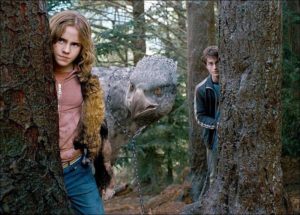 The best models for this experience are in SF and fantasy, where it is something of a staple. There is “Coop’s” attempt to contact his younger self via the tesseract in Interstellar, for instance, and the film Arrival, which I’ve discussed previously on this blog and also discuss in my book. Another vivid cinematic example I have been thinking about recently is the third Harry Potter film, Harry Potter and the Prisoner of Azkaban. I was not a huge Harry Potter fan, but Alfonso Cuaron handles time travel wonderfully in this film. Midway through, Hermione leads Harry several hours back in time using a “time turner” so they can rescue their slightly younger selves from a series of perils they had narrowly escaped in the first half of the movie. At each step of the way, they keep realizing that various anomalies they had experienced the night before (a rock hitting Harry in the head out of nowhere, a sound that distracted a werewolf pursuer, etc.) were themselves trying to get their own attention or otherwise save their own lives.
The best models for this experience are in SF and fantasy, where it is something of a staple. There is “Coop’s” attempt to contact his younger self via the tesseract in Interstellar, for instance, and the film Arrival, which I’ve discussed previously on this blog and also discuss in my book. Another vivid cinematic example I have been thinking about recently is the third Harry Potter film, Harry Potter and the Prisoner of Azkaban. I was not a huge Harry Potter fan, but Alfonso Cuaron handles time travel wonderfully in this film. Midway through, Hermione leads Harry several hours back in time using a “time turner” so they can rescue their slightly younger selves from a series of perils they had narrowly escaped in the first half of the movie. At each step of the way, they keep realizing that various anomalies they had experienced the night before (a rock hitting Harry in the head out of nowhere, a sound that distracted a werewolf pursuer, etc.) were themselves trying to get their own attention or otherwise save their own lives.
Dream journaling with an eye to precognition offers a real, literal time turner in which you can sometimes find yourself doing precisely this (albeit perhaps less dramatically than in Harry Potter): being a shaping presence in your own past. The reason is that the more attuned to dream precognition you become, the more you discover evidence of the phenomenon, and the more your amazement at these discoveries becomes included in your precognitive dreams. Your mature amazement becomes an influence in your life at an earlier point in time. I mean this quite literally.
The counterintuitive part, the “secret” if you will, is that that younger, naïve self is always unconscious; the dreamer does not, and by the laws of physics, cannot “know” what is going on, any more than the slightly younger Hermione and Harry know who is throwing rocks at their heads or rustling the bushes ahead of them. Sense—and again, a kind of vertiginous sublime epiphany—comes later, when the awake, conscious You goes back to the dream, in the form of your dream journal. The dream is not the time portal, the dream journal is. Its pages are the shale-like strata in which your most stunning paleontological discoveries are made. (This is why I keep telling you to keep a dream journal. Here, here’s a nice Amazon link to the particular journal I use for the purpose. You’re welcome.)
Let me illustrate the paleontological dream hermeneutic with a particularly striking example of mine from earlier this year.
Permian Battle
In late January, I wrote down a lucid dream that consisted of two parts. I’ll discuss the first later, but in the second part, my dream self was flying over a hillside, toward some large animals that seemed (from a distance) to be dinosaurs. This excited me greatly—I thought, how cool to visit a prehistoric landscape in a lucid dream! I was eager for a Jurassic Park-like experience. However, as I drew near, the creatures turned out not to be dinosaurs exactly but much more boring, squat, quadrupedal carnivores that I associated with some earlier period preceding the dinosaur era. The animal on my right in my dream was brown and vaguely dog-like, with a squarish head and saber-teeth; it was advancing on another creature, lumpy, squat, and black, more evil and reptilian-looking. They were about to clash in a fight, and landing between them, I had to intervene, holding the muzzles of both at arms’ reach as they tried to close on each other. Weirdly, there was a red dot, as from a laser pointer or laser gun-sight, fixed immovably on the body of the reptilian creature on my left, but I couldn’t turn my head to see what hunter was “targeting” it.
I jotted down notes on this in my notebook immediately on waking—it was probably around 6 AM—and then I wrote a couple paragraphs describing the dream in more detail in my electronic dream journal later that morning. The “fulfillment” of this dream came about 12 hours later, right after I checked my mail that evening.
 The previous fall, I had purchased a subscription to a magazine called Prehistoric Times—a sort of quarterly “fan” magazine about dinosaurs, dinosaur art, and dinosaur culture (toys, collectibles, etc.)—partly because I like showing dinosaur pictures to my small daughter, but also out of increasing personal nostalgia for my own dinosaur-saturated childhood. When I checked my mail, I was pleasantly surprised to find the new (Winter 2018) issue of Prehistoric Times, my first issue since subscribing. It contained a feature about therapsids. Therapsids (I quickly learned) were the vaguely dog- or cat-like proto-mammals of the Permian period, the period preceding the dinosaur-dominated Mesozoic era. (I remembered such animals dimly from my childhood, as the boring early land carnivores shown at the beginning of some dinosaur books, preceding the exciting Mesozoic animals every kid is really interested in.)
The previous fall, I had purchased a subscription to a magazine called Prehistoric Times—a sort of quarterly “fan” magazine about dinosaurs, dinosaur art, and dinosaur culture (toys, collectibles, etc.)—partly because I like showing dinosaur pictures to my small daughter, but also out of increasing personal nostalgia for my own dinosaur-saturated childhood. When I checked my mail, I was pleasantly surprised to find the new (Winter 2018) issue of Prehistoric Times, my first issue since subscribing. It contained a feature about therapsids. Therapsids (I quickly learned) were the vaguely dog- or cat-like proto-mammals of the Permian period, the period preceding the dinosaur-dominated Mesozoic era. (I remembered such animals dimly from my childhood, as the boring early land carnivores shown at the beginning of some dinosaur books, preceding the exciting Mesozoic animals every kid is really interested in.)
The painting on the first page of the article—the one at the top of this post—was unmistakeably and stunningly the scene from my dream: It showed, side by side, exactly the two creatures that had moved to attack each other and that I had struggled to keep apart. From the caption I learned that the evil reptilian-looking one on the left was a scutosaurus and the saber-toothed therapsid on the right was a sauroctonus. The feature was specifically on therapsid paintings by the Czech illustrator Zdenek Burian, an artist from the middle years of the century whom I already knew and liked, but this was not a picture I had ever remembered seeing, nor did any books in my collection contain pictures of these creatures. Not only the two animals in my dream, but also the dream setting was exactly like that Burian painting—sort of a low hillside.
I have recorded a couple hundred dreams that I have identified as seeming precognitive—I have written about a handful of them in previous posts on this blog—but this was probably the most crystal-clear example of dream precognition so far in my life. No amount of Freudian free-association was necessary to unpack the dream’s connection to the next day’s experience. There were no puns or other substitutions. I quite literally dreamed that picture, with the embellishment that I was in the scene, interacting with those two animals. The only odd detail not in the actual picture was the laser dot. But that dot turned out to be the key to the time loop.
 I initially scrutinized the various therapsid pictures in the magazine article, expecting maybe to find something like that dot, perhaps a printer’s blemish on one of the images. But all it took was a moment’s free-association to realize its significance: The first thing it reminded me of was the red dot of a laser gunsight on the forehead of Linda Hamilton in The Terminator, when Arnold Schwartzenegger first tries to assassinate her in a crowded bar. I hadn’t thought about that movie in years, yet what is that movie but a story about a hunter from the future traveling back in time to “target” someone in the past?
I initially scrutinized the various therapsid pictures in the magazine article, expecting maybe to find something like that dot, perhaps a printer’s blemish on one of the images. But all it took was a moment’s free-association to realize its significance: The first thing it reminded me of was the red dot of a laser gunsight on the forehead of Linda Hamilton in The Terminator, when Arnold Schwartzenegger first tries to assassinate her in a crowded bar. I hadn’t thought about that movie in years, yet what is that movie but a story about a hunter from the future traveling back in time to “target” someone in the past?
Recall that, in the dream, I couldn’t turn my head to see who was targeting this ancient creature. In fact, the out-of-sight hunter was me, about 12 hours ahead in my own timeline. The dream pre-presented my own retrospective scrutiny of these dream fauna from the point of view of amazedly, there on my living room couch, realizing that I myself was a time traveler, a hunter in my own past.* It was a dream pre-presentation of going back to the dream in hindsight.
Time Gimmickry
I have found, again and again, that dreams that turn out to have been precognitive often contain some representation of the act of returning to the dream to verify this fact. In other words, the precognitive nature of the dream is represented within the dream, like a fractal. “Time gimmicks” in dreams give the tip-off—elements having to do with time travel or “going back.” This includes rearview mirrors or juxtapositions of old and new. It only seems to happen, however, when the dream is recognized as precognitive at or near the time when the “confirming” event comes to pass, rather than at some time later. This is because dreams seem to be mnemonic (or pre-mnemonic) “bundles” binding experiences within a narrow window of time, usually an hour or two of waking life. If your realization that your dream was precognitive coincides with the experience being precognized, your realization will be included in the dream.
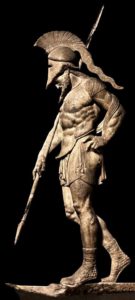 The above dream contained an additional time gimmick in addition to the laser dot. In an earlier part of that lucid dream, I had been zooming uncontrollably (I can never control my dream flight) through a vast enclosed cavern or gallery, like a vast subterranean hall, crowded with balconies that were densely packed with pale statues of ancient heroes—thousands of statues packed together on these balconies, almost like this enormous space had been converted into a storage facility for some huge trove of ancient marble statuary. I had a sense that some of the heroes were wearing helmets and light armor like ancient Greek or Roman warriors, but the only figure I remembered distinctly was an archer drawing back the string on his bow.
The above dream contained an additional time gimmick in addition to the laser dot. In an earlier part of that lucid dream, I had been zooming uncontrollably (I can never control my dream flight) through a vast enclosed cavern or gallery, like a vast subterranean hall, crowded with balconies that were densely packed with pale statues of ancient heroes—thousands of statues packed together on these balconies, almost like this enormous space had been converted into a storage facility for some huge trove of ancient marble statuary. I had a sense that some of the heroes were wearing helmets and light armor like ancient Greek or Roman warriors, but the only figure I remembered distinctly was an archer drawing back the string on his bow.
Given that the “Permian battle” scene was so clearly precognitive, I suspected this episode probably also pointed to the same magazine issue. I saw no obvious referent to such statuary later in the magazine (although the magazine did have several ads for superhero action figures). But when I flipped back to the beginning of the issue and paged through it a second time, I realized—with some amusement—that my “statues of ancient heroes” had a clear (but this time not literal) referent in the issue, on the pages immediately preceding the feature on therapsids. Since I hadn’t even been thinking about my dream at that point, I had simply missed it.
It was a feature with photos of a collector’s cramped dinosaur figurine collection, showing thousands of pale dinosaur models crammed together on shelves in a packed room of a house. I had not noticed the correspondence at first because my sublimely vast dream caverns were totally out of scale and proportion with this packed room, but the general sense was the same: “statues of ancient heroes” (many of them “lightly armored”) crammed together like in a multilayered storage facility. As I have described before, the exaggerated scale and importance of things in dreams often starkly contrast with the objective puniness or triviality of their precognitive or mnemonic referents in waking life.
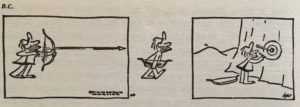 It occurred to me to free-associate on the “archer” among my dream statues, and I immediately thought of one of my favorite Dunne dream examples from the published literature, a minor case that I had written about for Chapter 8 of my book: A patient of the psychoanalyst-parapsychologist Jule Eisenbud related to him a dream about being unable to hit a target with an arrow, and the next morning his favorite comic strip B.C. by Johnny Hart showed a character drawing a target around an arrow he had shot into a wall (above). It’s not the most amazing Dunne dream as Dunne dreams go (or the most hilarious comic strip), and for various reasons, Eisenbud didn’t even count it as a true precognitive dream. But because of it, these days, archery and arrows represent for me the issues of causation and retrocausation that I have been immersed in for the past few years while writing my book. Substituting a dinosaur model in the next issue of Prehistoric Times with an ancient hero drawing back his bowstring was a time gimmick a lot like the laser dot on the scutosaurus, or an archery dream precognizing a B.C. comic strip on the same topic.
It occurred to me to free-associate on the “archer” among my dream statues, and I immediately thought of one of my favorite Dunne dream examples from the published literature, a minor case that I had written about for Chapter 8 of my book: A patient of the psychoanalyst-parapsychologist Jule Eisenbud related to him a dream about being unable to hit a target with an arrow, and the next morning his favorite comic strip B.C. by Johnny Hart showed a character drawing a target around an arrow he had shot into a wall (above). It’s not the most amazing Dunne dream as Dunne dreams go (or the most hilarious comic strip), and for various reasons, Eisenbud didn’t even count it as a true precognitive dream. But because of it, these days, archery and arrows represent for me the issues of causation and retrocausation that I have been immersed in for the past few years while writing my book. Substituting a dinosaur model in the next issue of Prehistoric Times with an ancient hero drawing back his bowstring was a time gimmick a lot like the laser dot on the scutosaurus, or an archery dream precognizing a B.C. comic strip on the same topic.
I can’t emphasize enough: Discovering a past dream representation of yourself “looking back” at the dream later is a sublime, awe-inspiring experience. For me, it is the most powerful validation of precognitive dream interpretation as a gnosis: The knower is literally included in the known. It is also a startling confirmation of what Hermann Minkowski and Albert Einstein argued about the solid, block-like nature of spacetime: The past is still here, and the future is already here, we just usually lack eyes to see it. Again, such representations will be noticed more and more, the more you become attuned to precognitive dreaming.
O Attic Shape!
It can’t be stressed enough that a precognitive dream is not about “the future.” It is about a future experience in one’s life. But more than that, it is about the thoughts, feelings, and associations that will be provoked by that experience. This goes a long way toward explaining the interesting ways dreams deviate from the real-life experiences that precognitively catalyze them.
It is unusual in my experience for a dream image or scene to so literally pre-present a real scene or stimulus in my life as the “Permian battle” in my dream did. More often, dreams distort things in the manner of the “ancient heroes” in the subterranean gallery. They did not look like dinosaurs in the dream; the sense of them came through the verbal/symbolic register, a transposition that made sense only when the visual image (Greco-Roman military statuary) was translated into words: statues of ancient heroes. (Remember, it was reconnecting with the “heroes” of my childhood, dinosaurs, that prompted me to subscribe to Prehistoric Times in the first place.) This transposition into ancient human heroes facilitated the link to archery and the B.C. dream of Eisenbud’s patient, and via that to many associations from my book.
 It connected, for instance, to the theme of Minkowski spacetime, where the past still exists. A vast (i.e., cosmic) storehouse packed with memorials, beings frozen in time, is a dream-representation of an idea that naturally comes to mind when I discover a dream was precognitive: a sense of awe at the “still-here-ness” of the past and the “already-here-ness” of the future. Among my other associations to the subterranean gallery full of marble ancient heroes was the confrontation between Perseus and Medusa in the original Clash of the Titans: Ray Harryhausen’s awesome animated Medusa slithers through her subterranean temple full of “statues,” which are really warriors that had been turned to stone by the Titan-archer’s terrible gaze.
It connected, for instance, to the theme of Minkowski spacetime, where the past still exists. A vast (i.e., cosmic) storehouse packed with memorials, beings frozen in time, is a dream-representation of an idea that naturally comes to mind when I discover a dream was precognitive: a sense of awe at the “still-here-ness” of the past and the “already-here-ness” of the future. Among my other associations to the subterranean gallery full of marble ancient heroes was the confrontation between Perseus and Medusa in the original Clash of the Titans: Ray Harryhausen’s awesome animated Medusa slithers through her subterranean temple full of “statues,” which are really warriors that had been turned to stone by the Titan-archer’s terrible gaze.
And I also thought of Keats’ “Ode on a Grecian Urn,” a poetic image expressing the same basic idea, of stasis and eternity and permanence. When I looked up Keats’s poem, I found that “marble men” is an explicit image in its last stanza.
O Attic shape! Fair attitude! with brede
Of marble men and maidens overwrought,
With forest branches and the trodden weed;
Thou, silent form, dost tease us out of thought
As doth eternity: Cold Pastoral!
When old age shall this generation waste,
Thou shalt remain, in midst of other woe
Than ours, a friend to man, to whom thou say’st,
“Beauty is truth, truth beauty,—that is all
Ye know on earth, and all ye need to know.”
Butch and Sundance
Eisenbud pointed out that his patient’s dream-choice of a B.C. comic for its precognitive target was itself a significant part of its meaning. I have found that precognition “likes” future stimuli having to do with juxtapositions of time. My two-part lucid dream about a dinosaur magazine is an obvious example. In early 2017, I wrote down the following dream that also exemplified the same principle:
Dream about Butch Cassidy and the Sundance Kid—a long introduction to the movie that I had not seen before, in which Butch and Sundance are reunited at Union Station in Denver and warmly embrace, Sundance tells Butch he missed him, and then they kiss. The dream shifted and they were lying together in an MRI or CT scan tube, and I was a bit surprised that they had that technology back then. On a countertop were some modern medical supplies and some sort of salve or ointment from CVS.
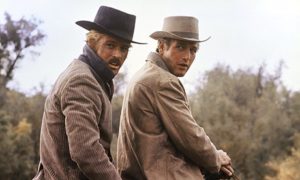 My natural thought when I dream of a celebrity (or their character) is that they may have died; I have never once been right in this assumption, yet on a few occasions my research has turned up something else even more interesting. On the day after I had this dream, I did a Google search on Robert Redford, worrying that perhaps he had passed away and thus been “reunited” with his co-star Paul Newman. Instead, Google led me straight to an article about Redford’s warm, real-life friendship with Newman—something I may have been dimly aware of years ago but certainly had no reason to be thinking of at this point in my life. Among other things, Redford was quoted as saying how much he missed Newman. That article, however, led to an even more interesting Esquire piece about Redford’s career and his early, unfair treatment by the critic Pauline Kael. There, I came across a striking passage about Kael’s “savaging of The Sting, the reunion of Redford and Newman and [director] George Roy Hill.” Kael’s review of the movie is quoted in the very next sentence: “I would much rather see a picture about two homosexual men in love than see two romantic actors going through a routine whose point is that they’re so adorably, smiley butch that they can pretend to be in love and it’s all innocent.”
My natural thought when I dream of a celebrity (or their character) is that they may have died; I have never once been right in this assumption, yet on a few occasions my research has turned up something else even more interesting. On the day after I had this dream, I did a Google search on Robert Redford, worrying that perhaps he had passed away and thus been “reunited” with his co-star Paul Newman. Instead, Google led me straight to an article about Redford’s warm, real-life friendship with Newman—something I may have been dimly aware of years ago but certainly had no reason to be thinking of at this point in my life. Among other things, Redford was quoted as saying how much he missed Newman. That article, however, led to an even more interesting Esquire piece about Redford’s career and his early, unfair treatment by the critic Pauline Kael. There, I came across a striking passage about Kael’s “savaging of The Sting, the reunion of Redford and Newman and [director] George Roy Hill.” Kael’s review of the movie is quoted in the very next sentence: “I would much rather see a picture about two homosexual men in love than see two romantic actors going through a routine whose point is that they’re so adorably, smiley butch that they can pretend to be in love and it’s all innocent.”
My dream seemed to have been pre-inspired by this passage suggesting a homoerotic “reunion” of Butch and Sundance.** Per standard dream overdetermination, the dream doubly represented the idea of a reunion by setting the dream kiss of Butch and Sundance at “Union Station,” a place familiar from my childhood. The CVS ointment or salve on the counter points associatively to the idea of an insect bite or sting. My dreaming brain’s placing of these characters in a modern CT scanner (and feeling “surprised they had the technology back then”) was another time gimmick, pre-presenting my own internet scrutiny of Redford and Newman’s relationship after the dream, and my dreaming brain’s confused juxtaposition of the computer-mediated nature of that “scan” and the sepia-toned setting of those period movies starring the real-life actor buddies.
In other words, the anachronism of Butch Cassidy and the Sundance Kid itself—a distinctly modern-feeling buddy comedy (with late-1960s Burt Bacharach score, etc.) set the better part of a century earlier (and I might add, one of my all time favorite films)—was itself folded into its precognitive significance. Anachronisms of one sort or another act as “attractors” for the precognitive brain.
Postscript: All Ye Need to Know
Another magazine I subscribe to, and also avidly read (although not to my two-year-old), is New Scientist. In a recent (July 14-20, 2018) issue, one of its editors, Rowan Hooper, penned a “Field Notes” piece about his visit to the 35th annual International Dream Conference in Phoenix. He visited the “interdisciplinary” (his scare quotes) conference to learn about the latest in scientific psychology and neuroscience of dreaming but found himself in a disturbingly mixed (one might even say interdisciplinary) group that included New Agers, psychoanalysts, and (shudder) parapsychologists expressing a profoundly distressing panoply of beliefs about dreams—such as that they may foretell future events. Having lunch with a psychoanalyst who believes dreams can be precognitive, he writes, he nearly choked on his burrito. Many people at that meeting, he lamented, expressed their belief in precognitive dreams.
“Our fascination with dreams goes back millennia, with many ancient cultures believing they carried messages from spirits or spoke to us of the future,” Hooper writes. “How sad that thousands of years later, we are still bogged down in such mysticism, when we could instead be probing what truly generates dreams, and what they tell us about consciousness and how our brains work.”
In other words, despite the famous mystery, even to scientists, of dreams and dreaming, this editor clearly went in “knowing all he needed to know” about dreams: they’re not “mystical”; they don’t speak of the future, etc. He wanted to see a homogeneous set of scientists upholding that narrowly materialistic (in the bad sense) viewpoint. “Call me naïve,” Hooper writes, “but it was a shame to find an ‘us versus them’ attitude among the non-scientists.” The psychoanalyst he had lunch with would call that projection, since Hooper himself clearly took such an attitude toward those non- or para-scientific ‘others’ and their “mumbo jumbo.” Who is the “us” and who the “them,” exactly?
Lest any New Scientist readers be on the fence about the possibilities of precognitive dreaming, Hooper provides the standard explaining-away: “No matter that with so many people dreaming each night, this is quite likely to happen by chance.” But the law of large numbers argument skeptics like Hooper always rest their cases on depends on the phenomenon in question happening rarely. In fact, those who have followed in the footsteps of J. W. Dunne and investigated their own dreams for evidence of precognitive material often come away with substantial evidence that precognitive dreams are the norm. When people can show from their own dream databases that precognitive dreams are common, even nightly occurrences (see for instance Bruce Siegel’s excellent Dreaming the Future, or Andrew Paquette’s Dreamer), then the law of large numbers argument flies straight out the window.
Lots of alleged precognitive dreams, because their relationship to a putative target consists of highly personal associations, understandably hold little weight with skeptics, who are as hostile to psychoanalytic premises as they are to parapsychological ones. If I were to relate the “statues of ancient heroes” dream episode to someone like Hooper and show him the magazine spread I alleged it precognized, he would no doubt roll his eyes. I wouldn’t really blame him. And if I related a dream like the one about Butch and Sundance, he would quite reasonably counter that if I looked long and hard enough in an Internet search about any famous person, I would eventually find some piece of text that might seem to match my dream. Fair enough. (It’s sort of the “put 20 monkeys in a room with typewriters and you’ll eventually get Hamlet” principle.)
But if I really wanted to make Hooper choke on his burrito, I would relate the “Permian battle” dream and ask how coincidence could in any way, shape, or form explain its exact correspondence to a picture in a magazine I received in the mail the next day.
 Despite my love of prehistoric animals, I never dream about them. I have on a few occasions in roughly a quarter century of keeping an electronic dream diary dreamed about trilobite-like, vaguely prehistoric sea invertebrates; and dinosaur-related books or films have appeared in a few dreams in my journals, but the number of times dinosaurs, dinosaur fossils, or similarly charismatic extinct creatures have appeared in my dreams can be counted on the fingers of one hand. And I have never in my life dreamed about Permian fauna. Again, this is in 25 years of (mostly faithfully) recording my dreams.
Despite my love of prehistoric animals, I never dream about them. I have on a few occasions in roughly a quarter century of keeping an electronic dream diary dreamed about trilobite-like, vaguely prehistoric sea invertebrates; and dinosaur-related books or films have appeared in a few dreams in my journals, but the number of times dinosaurs, dinosaur fossils, or similarly charismatic extinct creatures have appeared in my dreams can be counted on the fingers of one hand. And I have never in my life dreamed about Permian fauna. Again, this is in 25 years of (mostly faithfully) recording my dreams.
I knew practically nothing about Permian land carnivores before this dream; I did not know what they were called; and I did not know they were going to be featured in the Winter 2018 issue of Prehistoric Times. The previous issue of the magazine (I quickly verified) contained no “In the Next Issue …” teaser—not that I would have known what “therapsids” referred to in any case. I had basically forgotten about my subscription by the time this issue arrived, so its arrival was a total surprise. There is simply no way my dream about a scutosaurus fighting with a sauroctonus on the morning before getting the magazine featuring these obscure creatures was coincidental. And the fact that I wrote the dream down beforehand rules out retroactive memory distortion. More to the point, though, the correspondence, even if it was uniquely vivid, fits a very common, widely replicated pattern, undercutting the notion that it must be seen as a rare one-off (and thus “likely to happen by chance”).
Debates between psi-believers and skeptics are a lot like Keats’ Grecian Urn: Attic figures frozen in time, locked in an eternal dispute that goes nowhere. Meaning-centered phenomena resist purely scientific approaches, and this has put the study of dreams (like the study of psi) at an impasse for decades. Ever wonder why every popular science piece proclaiming the answer to why we dream (“it’s nocturnal therapy,” “it prepares us for threats,” and so on) sounds vaguely unconvincing and then is replaced by a completely new answer a few months later? It’s an argument why the humanities need to be brought into the dialogue with sleep scientists, to move things forward. That’s right, interdisciplinarity, one of the things I make a case for in my book.
The “extraordinary claims require extraordinary evidence” thing, also, needs to be re-thought. It is really just a paradigm buttress, and an excuse to avoid dealing with threatening data, by moving the goalposts. No one with access to research dollars is going to jeopardize their career by studying the question of dream precognition in a way that might produce “extraordinary” evidence. This effectively exiles the whole topic to the disreputable zone of anecdote or, at best, small studies in parapsychology journals that mainstream scientists readily ignore. Hooper writes that his head was in his hands by the end of a keynote address by Stanley Krippner, who conducted what are still the best-known dream-ESP studies a half century ago; but they were tiny studies and thus hold zero scientific weight in the world of big-budget science Hooper is used to.
Around the question of precognition and precognitive dreams, I think “extraordinary claims” should be turned around: What is really so extraordinary about dreams providing a glimpse of the future? Could the fact that people for thousands of years have believed, even assumed, this was the case be a clue worth at least taking seriously? Collective skepticism around precognition can be shown to be rooted in historical-social convention and taboo, not reason or even evidence. Physics allows information to reflux from the future. Quantum computers can scramble causal order (as you can even read in New Scientist), and a kind of computation across time may even be what gives them their power. And guess what pinkish-gray squishy organ is increasingly thought, by serious scientists, to be a quantum computer?
Once the larger paradigms (in physics and biology) shift, psychology and other fields will eventually be forced to follow. Rather than further belaboring the case for precognition to anxious, cognitive-dissonance-fearing audiences who won’t listen anyway, I think our time is best spent working out its mechanisms and its implications … as I do in Time Loops (available from an internet mega-retailer near you).
NOTES
* Not accidentally, a literary example that was also fresh in my mind at that point, because of my book, was the story “A Sound of Thunder,” by Ray Bradbury. It is about time-traveling hunters who travel to the Cretaceous period to bag a T-Rex but find upon their return that one of them had, by stepping off an assigned path, crushed a butterfly in the distant past, and thereby altered the course of history.
** Another common experience in the precognitive-dreamwork path is doing research in a book or online, spurred by a dream, and coming across a piece of text or a picture that is clearly the precognitive “source” of the dream. Phil Dick recorded several examples of this time-looping logic in his letters, for instance, and the dream about Butch and Sundance is just one of several examples of this phenomenon in my own experience.
Time Loop at Hanging Rock
Valentine’s Day, 1900. A group of Australian schoolgirls, all clad in white dresses, are driven by coach to Hanging Rock, an enormous volcanic formation in central Victoria, Australia, for an afternoon picnic. Four girls, including the most popular, Botticelli Venus-looking Miranda (played by Anne-Louise Lambert), defying the orders of the school’s stern headmistress, venture off from the group, ascending through a maze of crevices in a kind of dreamy reverie; later, one girl, Edith—the least pleasant of the lot—reappears, disheveled and upset. The rest have seemingly vanished into thin air—along with the school math teacher, Mrs. McCraw, who had followed after them.
Thus begins Peter Weir’s debut masterpiece Picnic at Hanging Rock, one of the many gems of mid-1970s cinema (and recently remade as a 6-part Amazon miniseries, which I have not seen). I have always had good memories of Weir’s 1975 film from seeing it on television when I was young, and even vaguely thought of it as a “paranormal” movie, although without remembering quite why. When I watched it recently for the first time in probably two decades, I was again stunned at its beauty, and like many viewers I was gripped by the mystery that is presented as somehow, vaguely, a “true story.” A visit to Google immediately after the credits rolled revealed a much more complex and ambiguous reality. It turned into a month of gathering and reading everything I could about the source novel and its author, Joan Lindsay.
 There are so many fascinating wrinkles to the story that it is hard to know where to begin. First, if you have never seen the film, do yourself a favor and watch it. With its gorgeous cast and costumes and scenery and a Georghe Zamfir pan-flute melody that will be stuck in your head for days, it is brilliant from start to finish. But no spoiler warnings are really necessary, because none of the questions raised in the first 30 minutes of the film are answered by the end. The mysteries only deepen as the remaining schoolgirls and their teachers and headmistress—as well as two young men who were the last to see the girls ascending the rock—attempt to unravel the mystery and deal with the consequences of the girls’ disappearance.
There are so many fascinating wrinkles to the story that it is hard to know where to begin. First, if you have never seen the film, do yourself a favor and watch it. With its gorgeous cast and costumes and scenery and a Georghe Zamfir pan-flute melody that will be stuck in your head for days, it is brilliant from start to finish. But no spoiler warnings are really necessary, because none of the questions raised in the first 30 minutes of the film are answered by the end. The mysteries only deepen as the remaining schoolgirls and their teachers and headmistress—as well as two young men who were the last to see the girls ascending the rock—attempt to unravel the mystery and deal with the consequences of the girls’ disappearance.
We never find out what happened to the girls, and there are only subtle hints of anything paranormal in the film, or even in the book, unless you are paying close attention. The paranormal is mainly in the backstory of the author, the unusual circumstances of the writing of her 1967 novel, and especially in what was excised from the text prior to publication. Lindsay’s novel turns out to be a kind of “fractal” representation of the paranormal and its fate in our culture: to be “disappeared,” just like the alluring, disobedient schoolgirls.
Time Without Clocks
The 70-year-old Joan Lindsay wrote her novel, which quickly became a classic of Australian fiction, over the course of a mere week in 1966, after a series of obsessive dreams. The whole novel came to her in these dreams, and it did have at least one obvious autobiographical component. Appleyard College in the novel was clearly based on a real private girls’ boarding school, the Clyde School in Mt. Macedon, near Hanging Rock, which she had attended as a young woman in the late 19-teens. She prefaced her novel with the words “Whether Picnic at Hanging Rock is fact or fiction, my readers must decide for themselves. As the fateful picnic took place in the year nineteen hundred, and all the characters who appear in this book are long since dead, it hardly seems important.”
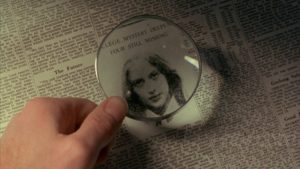 Well, you could not ask for a more powerful invitation to discover the “truth” behind the mystery. And there is nothing like the mysterious disappearance/death of beautiful young women to fire the imagination. Just ask David Lynch. The novel, with the help of Weir’s film, which the author fully endorsed, cast a spell on a nation. Especially after the film was released in 1975, Australian fans obsessively scoured newspapers from the period for reports of missing schoolgirls at Hanging Rock—in vain. One critic, Yvonne Rousseau, compiled various theories of the girls’ disappearance in her 1988 book The Murders at Hanging Rock.
Well, you could not ask for a more powerful invitation to discover the “truth” behind the mystery. And there is nothing like the mysterious disappearance/death of beautiful young women to fire the imagination. Just ask David Lynch. The novel, with the help of Weir’s film, which the author fully endorsed, cast a spell on a nation. Especially after the film was released in 1975, Australian fans obsessively scoured newspapers from the period for reports of missing schoolgirls at Hanging Rock—in vain. One critic, Yvonne Rousseau, compiled various theories of the girls’ disappearance in her 1988 book The Murders at Hanging Rock.
In reality, Hanging Rock had been a pretty dangerous place in the late 1800s. People sometimes did go missing. Prospectors returning to Melbourne from nearby gold fields were sometimes robbed and murdered there. According to a 1975 documentary about the film, a nearby town has a monument to three children who went missing sometime in the late 1800s. The Rock also was “haunted” by Australia’s colonial history and the murder of indigenous peoples, for whom the site was regarded as sacred. Visitors still regard it as a spooky, mysterious place.
Another clear influence on Lindsay’s novel was a painting that had hung in the office of her husband, Sir Daryl Lindsay, a famous Australian painter and director of the Australian National Gallery. At the Hanging Rock (below) by William Ford shows a group of Victorian picnickers under the looming formation, in what could almost be a promotional still for Weir’s film.
But a few astute readers and friends of Joan Lindsay had all along suggested that there was something else going on with the novel, and that it had to do with the author’s unusual beliefs about time. At the beginning of the story (and the film) the visitors’ watches all are found to have stopped in the vicinity of the rock. And there is an odd, easily overlooked but telling detail early in the novel when the girls who have left the group gaze down on the valley below and muse philosophically on human purpose, almost like aliens surveying people from some Archimedean vantage point; one of the girls then hears a sound like drums:
The plain below was just visible; infinitely vague and distant. Peering down between the boulders Irma could see the glint of water and tiny figures coming and going through drifts of rosy smoke, or mist. ‘Whatever can those people be doing down there like a lot of ants?’ Marion looked out over her shoulder. ‘A surprising number of human beings are without purpose. Although it’s probable, of course, that they are performing some necessary function unknown to themselves.’ … The ants and their business dismissed without further comment. Although Irma was aware, for a little while, of a rather curious sound coming up from the plain. Like the beating of far-off drums.
 Readers who are paying attention note that a search party several hours later bangs on sheets of tin to try and signal to the missing girls. “No wonder the bloodhounds lose the trail,” Lindsay’s journalist friend Phillip Adams remarked in a newspaper column, “For the girls aren’t lost on the rock. Like Alices stepping through the looking glass, they’re moving into another dimension.” A week later, the girl who heard the drums, Irma, is found high on the rock asleep, unharmed except for a few scratches, but with no memory of what became of her friends or their math teacher.
Readers who are paying attention note that a search party several hours later bangs on sheets of tin to try and signal to the missing girls. “No wonder the bloodhounds lose the trail,” Lindsay’s journalist friend Phillip Adams remarked in a newspaper column, “For the girls aren’t lost on the rock. Like Alices stepping through the looking glass, they’re moving into another dimension.” A week later, the girl who heard the drums, Irma, is found high on the rock asleep, unharmed except for a few scratches, but with no memory of what became of her friends or their math teacher.
Lindsay in real life claimed that clocks would not function near her, and friends confirmed that their watches would stop in her presence. In her memoir Time Without Clocks, she described her own hatred of the clock-bound life most people lead. There were few clocks at Mulberry Hill, the Lindsays’ home in Victoria. She didn’t even know her own birth date until she asked another journalist friend, Terence O’Neill, to help her research it. In his own confusion of chronology, Adams described that “Long before Einstein revealed his relativity theory, in which time ceases to be something solid and dependable and becomes elastic, Joan believed that it was somehow dreamlike, that yesterday is still with us while tomorrow is already here.” In reality, Joan was still a little girl when Einstein formulated his theory—but what’s a little time warp between friends?
The Missing Chapter
The more readers pressed Lindsay for details about her inspiration, the more she clammed up—and even complained at how people kept showing up uninvited at Mulberry Hill, to get answers. Yet her various coy allusions to a true story, and to real people concealed in her novel, kept readers digging.* Amid all the speculation by readers, there were rumors of a final chapter that had been cut from the novel prior to publication, which contained the answer to the mystery.
The rumors proved … entirely true. Although the “explanation” the missing chapter provided is one that few readers could understand, let alone accept. The missing “Chapter 18,” published in 1987 as The Secret of Hanging Rock (along with a couple critical commentaries), is one of the most fascinating and beautiful pieces of “paranormal fiction” I have ever read. And the story of how it came to be excised from the novel is just as interesting, and telling.
 The novel as published chronicles various upheavals in the community following the girls’ disappearance. These include the re-exploration of the rock by the two young men who had last seen the girls, the recovery of Irma, the suicide of one of the other students (who the film suggests had been in love with the missing Miranda), and the descent into drink and finally suicide of the headmistress Mrs. Appleyard (played by Rachel Roberts in the movie), after several parents withdraw their daughters and their money from her school. The missing Chapter 18 does indeed return us to the Rock and to “what happened,” but it is nothing that would fit within the usual coordinates of a romantic mystery novel.
The novel as published chronicles various upheavals in the community following the girls’ disappearance. These include the re-exploration of the rock by the two young men who had last seen the girls, the recovery of Irma, the suicide of one of the other students (who the film suggests had been in love with the missing Miranda), and the descent into drink and finally suicide of the headmistress Mrs. Appleyard (played by Rachel Roberts in the movie), after several parents withdraw their daughters and their money from her school. The missing Chapter 18 does indeed return us to the Rock and to “what happened,” but it is nothing that would fit within the usual coordinates of a romantic mystery novel.
The trio of girls—the otherworldly beauty Miranda, the intellectual Marion (who gazed down on the picnickers like at ants), and the wealthy Irma—are on a high ledge, drawn toward a stone monolith that exerts a kind of spiral magnetic force, “pulling, like a tide.” Beyond it, the girls fall asleep briefly and then encounter a “clown-like figure” dressed only in her undergarments and boots—clearly the math teacher, Mrs. McCraw, whom Edith later recalled with embarrassment seeing coming up the hill in only her underwear while she was running down it. Yet the girls don’t recognize the woman—they are already in a dream-like state where reality has been transfigured.
Marion then gets the idea they should all discard their restricting corsets, which they toss off a precipice, only to see them hanging motionless in mid-air. The math teacher/stranger says “they are stuck fast in time,” at which one of the girls tells her “when you said that about time I had such a funny feeling I had met you somewhere. A long time ago.” The older woman replies, “Anything is possible, unless it is proved impossible. And sometimes even then.” She then asks for the girls’ names, even though she should know them, and notes she has forgotten her own name: Waving toward a bush, she says “I have apparently left my own particular label somewhere over there.”
It is a “trippy” exchange—indeed, like a group of people under the influence of a powerful hallucinogen. And it gets stranger. When the brainy Marion suggests they keep moving before the sun sets, the older woman utters further perplexities:
“For a person of your intelligence—I can see your brain quite distinctly—you are not very observant. Since there are no shadows here, the light too is unchanging.”
Irma was looking worried. “I don’t understand. Please, does that mean that if there are caves, they are filled with light or darkness? I am terrified of bats.”
Miranda was radiant. “Irma, darling—don’t you see? It means we arrive in the light!”
“Arrive? But Miranda … where are we going?”
“The girl Miranda is correct. I can see her heart, and it is full of understanding. Every living creature is due to arrive somewhere. …”
Which is when they see a hole open up before them:
It wasn’t a hole in the rocks, nor a hole in the ground. It was a hole in space. About the size of a fully rounded summer moon, coming and going. She saw it as painters and sculptors saw a hole, as a thing in itself, giving shape and significance to other shapes. As a presence, not an absence—a concrete affirmation of truth. She felt that she could go on looking at it forever in wonder and delight, from above, from below, from the other side. It was a solid as the globe, as transparent as an air bubble. An opening, easily passed through, and yet not concave at all.
The “hole in space” fades out, after which they observe a snake descend down a physical hole below some boulders. The woman formerly known as Mrs. McCraw then confidently decides to lead the girls into the hole. She wriggles into it, undergoing a kind of transformation as she does so (“The thin arms, crossed behind the head with its bright staring eyes, became the pincers of a giant crab”)—followed by Marion and Miranda in turn. Then to Irma’s horror another boulder falls on the hole, sealing it off.
Irma had flung herself down on the rocks and was tearing and beating at the gritty face of the boulder with her bare hands. She had always been clever at embroidery. They were pretty little hands, soft and white.
So that is how Joan Lindsay originally ended her novel: with Hanging Rock itself devouring the girls and their teacher. In contrast to the matter-of-fact tone of the rest of the book, it is more like something out of Carlos Castaneda—or indeed, Lewis Carroll. As Yvonne Rousseau wrote in her commentary to this chapter, it also bears close rereading. Among other things, there is something punnily akin to dream in these strange events: Mrs. McCraw’s crab-transformation is into a kind of claw; the corsets that hang in midair were colloquially called “stays,” and stay in spacetime is what they do. It is a stunning vision of the Minkowski block universe.
Lindsay’s Time Slip
It is certainly significant that Lindsay had experienced at least one “time slip,” which made such an impression that she related the story to several friends. Probably in 1929, her husband Daryl had been driving her to another town, Creswick, to visit his mother, and on the way Joan saw something strange. One friend, John Taylor, recalled her story in his commentary to the missing chapter: “half a dozen nuns were running frantically across a field and climbing a fence. Her husband saw nothing. Puzzled, she asked her mother-in-law if there was a convent in the area. There had been, she was told, but it had burned down years earlier.”
Lindsay’s time slip in 1929 undoubtedly was a significant influence on her beliefs about time, but so was another, more famous time slip that dated to the same period her novel was set in. She confided to her friend Adam Phillips that her writing of Picnic had been very influenced by the book An Adventure, first published anonymously in 1911 by a pair of English academics, later revealed as Charlotte Anne Moberly and Eleanor Jourdain, about an alleged shared time-slip experience while wandering the gardens of Versailles in 1901: The women reported seeing a number of people in anachronistic dress that they later determined must have been the ghosts of Marie Antoinette and her courtiers circa 1789, just before their deaths in the French Revolution.
 Although it is the most famous time slip, Moberly and Jourdain’s account has also proven to be one of the least persuasive to critics. One critic chalked it up to costume parties an aristocrat was known to throw on the grounds; another, Lucille Iremonger, attributed it to a lesbian folie-a-deux between the two women (because lesbians, of course, are always hallucinating). The real problem is that weeks had elapsed after the women’s visit before they even conferred on what they had seen, and both seem to have experienced different things. There is no telling how much their memories of their first visit may have been shaped by the decade of research delving into the history of the Trianon garden and Versailles as well as their subsequent visits to the gardens, or how much their memories influenced each other. If there was a real time slip, it may have just been just one of them who experienced it, the other having adjusted her memory to conform with the notion of “something strange” occurring. At this point, there is no telling.
Although it is the most famous time slip, Moberly and Jourdain’s account has also proven to be one of the least persuasive to critics. One critic chalked it up to costume parties an aristocrat was known to throw on the grounds; another, Lucille Iremonger, attributed it to a lesbian folie-a-deux between the two women (because lesbians, of course, are always hallucinating). The real problem is that weeks had elapsed after the women’s visit before they even conferred on what they had seen, and both seem to have experienced different things. There is no telling how much their memories of their first visit may have been shaped by the decade of research delving into the history of the Trianon garden and Versailles as well as their subsequent visits to the gardens, or how much their memories influenced each other. If there was a real time slip, it may have just been just one of them who experienced it, the other having adjusted her memory to conform with the notion of “something strange” occurring. At this point, there is no telling.
Still, it made for an interesting book—one that was influential on many writers, including J.R.R. Tolkien (as Verlyn Flieger discusses in her book A Question of Time). But I think even more importantly, the edition that Lindsay is likely to have read, which was published in 1931, also included an introductory note by J.W. Dunne, the aeronautical engineer and precognitive dreamer whose 1927 book An Experiment with Time is probably the most important book ever written on the subject of precognition and its relation to the Einsteinian time-elastic universe. He writes that he was asked to comment on the scientific plausibility of the women’s account, and states that “if Einstein is right, the contents of time are just as ‘real’ as the contents of space. Marie Antoinette—body and brain—is sitting in the Trianon garden now.” More than anything in Moberly and Jourdain’s text, it is that line from Dunne’s note that surely exerted its effect on Lindsay when opening her Chapter 18:
It is happening now. As it has been happening ever since Edith Horton ran stumbling and screaming towards the plain. As it will go on happening until the end of time. The scene is never varied by so much as the falling of a leaf or the flight of a bird. To the four people on the Rock it is always acted out in the tepid twilight of a present without a past. Their joys and agonies are forever new.
“An Uncomfortable Style”
You will be right to ask about Chapter 18’s authenticity: A “missing chapter” to a nationally beloved novel turning up shortly after the death of the author should always be suspect. However, in this case, there does not seem to be any question of the text being a forgery, as there are living witnesses to the original manuscript with the chapter in place.
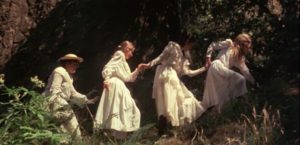 When Lindsay originally submitted her novel to her friend, publisher Andrew Fabinyi, he was enthusiastic; but he assigned it to a junior editor, Sandra Forbes, who felt uncomfortable about the ending. As described by Janelle McCulloch in her recent book Beyond the Rock, Forbes wrote in a letter to Lindsay: “I’m very doubtful about the last chapter. On the whole, would prefer to omit it altogether.” In an interview with McCulloch, Forbes asserted that the decision to cut the chapter had been agreed on by the author: “We all discussed it and it seemed the right thing to do.”
When Lindsay originally submitted her novel to her friend, publisher Andrew Fabinyi, he was enthusiastic; but he assigned it to a junior editor, Sandra Forbes, who felt uncomfortable about the ending. As described by Janelle McCulloch in her recent book Beyond the Rock, Forbes wrote in a letter to Lindsay: “I’m very doubtful about the last chapter. On the whole, would prefer to omit it altogether.” In an interview with McCulloch, Forbes asserted that the decision to cut the chapter had been agreed on by the author: “We all discussed it and it seemed the right thing to do.”
It is hard to know how to evaluate Forbes’ claim. Lindsay’s friend and literary agent John Taylor, to whom she entrusted the typed pages of the cut chapter in 1972 and who published it as The Secret of Hanging Rock in 1987, three years after her death, insisted that she intended it to be published; it was part of her original vision and clearly expressed spiritual truths that were important to her. “Certainly, she wanted Chapter 18 to appear,” Taylor wrote in his commentary to the chapter. “What artist wants to conceal an unflawed work?” Taylor claimed that despite her natural artistic wish not to excise part of her novel, she allowed herself to be persuaded by others: “She was meticulous in respecting the interests of those who were exploiting her work, and understood that it might have worked against those interests.”
Besides losing a very personal and important part of her story, the absence of the final chapter also had become a kind of negative Albatross for Lindsay by the time of her death. It left readers to concoct fictions of their own to solve the puzzle, and their demands for confirmation left her and her husband with little peace during their old age. Taylor wrote: “Although she knew perfectly well that the huge success of both book and film had a lot to do with the mystery of ‘what really happened’, she had moments of wishing she had published the final chapter and saved herself the pestering.” Lindsay gave Taylor the copyright to the final chapter after Weir’s film came out, “as part of her general horrified reaction to the flood of demanding inquiries” about the true fate of the girls. As her literary agent, it was Taylor’s job to deal with the constant questions.
Taylor, like Forbes, was not unbiased in the matter—he perhaps stood to gain from publishing the chapter—so we cannot be certain of his claims that Lindsay intended Chapter 18 to come out. Purely in terms of the bottom line, Forbes clearly made the right editorial decision, since the book would never have been as successful without the question mark it leaves in the reader’s mind. Taylor acknowledges this as well, keenly comparing the missing chapter to the Psalmist’s “stone rejected by the builders,” which becomes the cornerstone of the edifice. Chapter 18 is “the previously invisible foundation stone on whose absence the Australian film industry built itself.” The missing Chapter 18 is, he notes, “totally unfilmable.” Still, despite Forbes’ implication that the decision to cut Chapter 18 was mutual, it appears to have been a very ambivalent one for Lindsay.
Just as interesting as the chapter itself is the discomfort it aroused in her editor, Forbes. In another recent interview by Helen Goltz for the book No Picnic at Hanging Rock, Forbes recalled conversations with Taylor in 1984, after Lindsay’s death, about the possibility of publishing the missing chapter; she reiterated her earlier sentiments: “I didn’t like the final chapter, it was not written in the same style, it was an uncomfortable style and I don’t think the final chapter did the book any service to publish it.” Goltz herself seems to share Forbes’ discomfort with the chapter, agreeing with the decision to leave it out and finding it merely bizarre: “I suspect the reader will be more bewildered as to the outcome of the young women on reading The Secret of Hanging Rock.”
 These are clearly not readers of science fiction, or the paranormal. Indeed, the core issue with Lindsay’s book is that in its original form it transgressed genres. Although Forbes may not have articulated it this way, Chapter 18 turned Picnic at Hanging Rock into SF, or some kind of supernatural Gothic mystery. Especially at the time (1967), those belonged to a low-level literary ghetto where, besides there being no literary respectability, there was also no money. As Jeffrey Kripal has shown in his books like Mutants and Mystics, the collective cultural discomfort with the paranormal experiences that have driven many writers of imaginative fiction reflects just how transgressive these experiences are.
These are clearly not readers of science fiction, or the paranormal. Indeed, the core issue with Lindsay’s book is that in its original form it transgressed genres. Although Forbes may not have articulated it this way, Chapter 18 turned Picnic at Hanging Rock into SF, or some kind of supernatural Gothic mystery. Especially at the time (1967), those belonged to a low-level literary ghetto where, besides there being no literary respectability, there was also no money. As Jeffrey Kripal has shown in his books like Mutants and Mystics, the collective cultural discomfort with the paranormal experiences that have driven many writers of imaginative fiction reflects just how transgressive these experiences are.
Lindsay was transgressive in other ways besides her time slips and her inhibitory effect on timepieces. Although married, she appears to have maintained life-long erotic friendships with two women, for instance. But like many women of her generation, she felt compelled to subordinate her own artistic and intellectual talents, to be a satellite of a talented, high-achieving man.
Sir Daryl Lindsay was one of the leading Australian painters of his generation, and then a high-profile director of Australia’s National Gallery for many years. The Lindsays led an enviable life surrounded by fascinating bohemians and celebrities. Through it all, Joan had little time or opportunity to express herself or develop her own unique talents as a writer, and she received little encouragement from Daryl. Another thing her life with Daryl suppressed, according to McCulloch, was her mysticism. She had long been drawn to the mystical and the paranormal—her friends all regarded her as a psychic—but avoided talking about these matters in front of Daryl. Although I can only conjecture, it is easy to imagine Daryl may have shared Forbes’ negative assessment of Chapter 18.
Precognitive Deconstruction
As readers of this blog know, I think misrecognized precognition is behind many paranormal experiences. In cases of “time slips,” for instance, there is typically a striking learning experience about the traversed landscape in the individual’s near future, and it typically matches the vision, whether or not it really matches historical reality. Lindsay’s vision was not of nuns going about their daily activities or doing any of the ordinary things nuns might have done in their lives, but of fleeing from something, and this acts as a “tracer” pointing directly to the story told by her mother-in-law later the same day. In other words, Lindsay’s vision was likely a premonition of a mental image formed upon hearing that exciting, entropic story, not a slip into the past. I suggest that “psychics” may often be people who tend more readily than others to map such future mental images onto their present sensory experience, almost like a kind of augmented-reality app. (One wonders how much of what gets diagnosed as psychosis is really precognition unrecognized.)
And as I argue in my book Time Loops, precognition is also the source of creative genius: Writers and artists are drawing on upheavals in their own futures, and this is particularly visible with visionary and genre writers—or those who barely manage to escape a genre pigeonhole through clever reframing or, in Lindsay’s case, editorial bowdlerization. Their lives and works often show evidence of bizarre causal tautologies or self-fulfilling prophecies. Lindsay, I believe, belongs to the club of highly precognitive writers, and her novel lends itself to a kind of precognitive rereading.
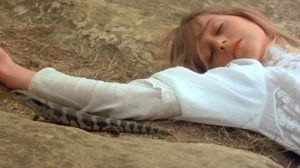 Consider: Picnic at Hanging Rock stages a traumatic disappearance—a group of schoolgirls go on a picnic and come back minus three, and minus one math teacher—and then describes the ripple effects of that disappearance. While there was no actual disappearance of schoolgirls at Hanging Rock either around the turn of the century or in the 19-teens when Lindsay attended Clyde School, there was a traumatic disappearance in Lindsay’s near future when she wrote her manuscript: none other than the cutting of her final chapter, with its beauty and strangeness and its mathematical-physical musings.
Consider: Picnic at Hanging Rock stages a traumatic disappearance—a group of schoolgirls go on a picnic and come back minus three, and minus one math teacher—and then describes the ripple effects of that disappearance. While there was no actual disappearance of schoolgirls at Hanging Rock either around the turn of the century or in the 19-teens when Lindsay attended Clyde School, there was a traumatic disappearance in Lindsay’s near future when she wrote her manuscript: none other than the cutting of her final chapter, with its beauty and strangeness and its mathematical-physical musings.
The cut was traumatic because that final chapter was the most personal statement of Lindsay’s spiritual and scientific beliefs about time. Yet as everyone agrees and Lindsay even came to agree, the novel never would have been popular had the cut not been made. Taylor confirms it was thus a source of deep ambivalence for Lindsay. These are precisely the kinds of mixed emotions that characterize precognition-worthy experiences.
We could thus read the complete dream-inspired novel as originally written in late 1966, with its final chapter, as being about the subsequent editorial cut of its final chapter and the aftereffects of that cut. In the novel, Appleyard College is beset by unwelcome, curious visitors in the aftermath of the disappearance. Mulberry Hill, the Lindsay’s home, was beset by unwelcome, curious visitors in the aftermath of the novel’s publication and especially of the movie: people wanting to find out the truth.
As it happens, the loss of the spiritual chapter, Chapter 18, wasn’t a complete excision, however, and some of the novel’s peculiarities assume a precognitive significance in light of this fact also.
One of the three girls, Irma, who has heard the beating of drums and then witnesses the disappearance of her friends into the hole, is found alive and returns to the school near the end, but without any memory of what happened. It so happens that the passage about the beating of drums (which some readers like Taylor and Phillips thought was a clue that the author was playing tricks with time) originally appeared in Chapter 18 (that is, in correct chronology). Lindsay preserved it and re-placed it, along with a few other passages, earlier in the book when she agreed to cut the rest of the final chapter. The opening paragraph, about the events being frozen in time, was also retained and re-placed to an earlier chapter. In other words, fragments of the missing chapter do appear throughout the book as published, because Lindsay saw fit to have them “rescued” from the editorial edict. The rescue and return of Irma might thus be “prophetic” of the rescue and return of these fragments.
So I suggest—though obviously it would be impossible to prove—that Lindsay’s week of dreams in the winter of 1966, which she feverishly spent her days writing into the novel that made her famous, represented “the whole package” of what was about to happen in her life as a direct result of writing those dreams down—in other words, a time loop. The core thread of prophetic jouissance is a kind of reward and excitement. What could be more exciting than writing an amazing mystery novel and then becoming widely known and admired for it (not to mention the royalties and movie rights)? But like most or all precognitive experiences, it also pointed to the survival of a loss, a cut, a sacrifice that needed to be made for that success, and it was the sacrifice of the bulk of the most radical, personal, and spiritual part of what Lindsay had written.
Fans, I suggest, were thus looking in the wrong direction for the “reality” behind Lindsay’s mystery. The story—a party that traumatically loses a few members and provokes a desperate search, as well as other ripple-effects—rather strikingly anticipates the fate of the novel itself: the traumatic disappearance of its final chapter, leaving everyone “hanging” as to its meaning, and provoking widespread obsessive search for the “true story” underlying it, as well as frustration by the author at having had her most important convictions silenced. Lindsay no doubt did want people to see it, yet felt prevented—silenced, or indeed, castrated.
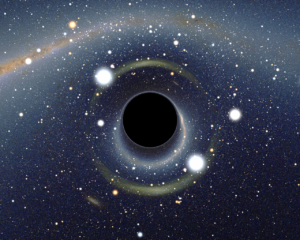 It is incredibly Freudian, really. A castration is a kind of sacrifice or threatened sacrifice that keeps things within their proper limits, a warning or punishment for transgression. In the child’s imagination, it leaves behind a “hole.” It is also Einsteinian: Although the possibility of gravitational singularities had been described in the upper echelons of astrophysics for years, they did not enter the public consciousness until, wait for it, 1967, when the term “black hole” was coined. Lindsay’s “hole in space” image was, again, written late the previous year.**
It is incredibly Freudian, really. A castration is a kind of sacrifice or threatened sacrifice that keeps things within their proper limits, a warning or punishment for transgression. In the child’s imagination, it leaves behind a “hole.” It is also Einsteinian: Although the possibility of gravitational singularities had been described in the upper echelons of astrophysics for years, they did not enter the public consciousness until, wait for it, 1967, when the term “black hole” was coined. Lindsay’s “hole in space” image was, again, written late the previous year.**
Most significantly, the girls’ stunning vision high atop the Rock, of a convex absence that was also a presence, which they could not stop gazing at with pleasure, seems symbolic of the role of the spiritual/paranormal itself in and around the book: The hole is the final chapter in which it is embedded, the excised spiritual core of the novel, the really fascinating part, the solution to the mystery, which everyone wanted to see but which no readers got to see, a presence that became an absence simply because it made a cautiously realist editor uncomfortable.
No Party Is More Important than the Hole
In his classic manual, The Art of Dramatic Writing, Lajos Egri tells a story about the sculptor Rodin and his famous massive sculpture of the writer Balzac. When he had finished and showed it to a group of his pupils, all they could do was rave at how exquisitely he had rendered the writer’s hands, held out in front of his body. According to Egri, this enraged the sculptor, who grabbed an axe and chopped off the hands. “I was forced to destroy these hands because they had a life of their own. They didn’t belong to the rest of the composition. Remember this and remember it well,” he exhorted his students, ”No part is more important than the whole!”
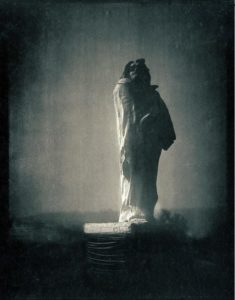 I had always remembered this story about Rodin, from when I had read Egri’s book in college. And since it seemed so appropriate to the story of Joan Lindsay and her Chapter 18, I returned to it for the sake of writing this chapter. I did not have a copy, so I was forced to search the Internet for the quote I was seeking—and that search revealed quite quickly that what Egri had written was not true. Rodin, at least as far as I could determine, never took an axe to his sculpture of Balzac to break off its distractingly wonderful hands. It was merely a bit of artful (and thus memorable) dramatic writing. The reality is both less dramatic but also more revealing—and indeed, even more illustrative of the point I am trying to make about Joan Lindsay’s excised Chapter 18.
I had always remembered this story about Rodin, from when I had read Egri’s book in college. And since it seemed so appropriate to the story of Joan Lindsay and her Chapter 18, I returned to it for the sake of writing this chapter. I did not have a copy, so I was forced to search the Internet for the quote I was seeking—and that search revealed quite quickly that what Egri had written was not true. Rodin, at least as far as I could determine, never took an axe to his sculpture of Balzac to break off its distractingly wonderful hands. It was merely a bit of artful (and thus memorable) dramatic writing. The reality is both less dramatic but also more revealing—and indeed, even more illustrative of the point I am trying to make about Joan Lindsay’s excised Chapter 18.
By the time he was planning his statue of Balzac, Rodin had come to care little about public opinion—about his works or anything else—and his plan for his statue was to depict the writer in the act of masturbating, which Rodin knew had been part of the writer’s creative process. Studies for the final sculpture show the writer gripping the end of his thrust-out member. But his need to satisfy the Société des Gens de Lettres that had made the commission no doubt contributed to Rodin’s self-bowdlerization of his original vision, placing Balzac’s hands under his robe, where it will be unclear to all but the dirtiest-minded viewer (or those who know of Balzac’s habits) what his hands are up to. In the end, it didn’t matter—Rodin lost the commission, his sculpture languished, and it wasn’t finally cast in bronze until long after his death. (It is now on prominent display at the corner of Boulevard du Montparnasse and Boulevard Raspail in Paris.) Undoubtedly, that would not have happened had Rodin remained true to his original vision; it would ultimately have been censored, kept hidden away.
Why did Egri tell his story the way he did? Did he misremember the true story? Was his unconscious so threatened at a statue showing masturbation, or of the “castration” of such a vision, that his memory twisted Balzac’s phallus into hands?
The paranormal is “obscene” in very much the same way as—although perhaps for different reasons than—Rodin’s original vision for his statue of Balzac. Its fate is to be marginalized and denied—erased—and then to haunt us in the way the repressed, per Freud, always returns. Moreover, even when a cultural authority reincorporates what has gone missing, it will often be in a distorted, “safe,” and untrue-to-life fashion, almost as though the real thing has a force field around it, leading to distortion and denial.
The fate of Joan Lindsay’s Chapter 18 is the fate of the paranormal itself in our culture: to be excised, “cut,” from the rest of life in order for everything to add up and not challenge our conventional views of time and causation. We would rather be faced with a traumatic disappearance—a kind of literary castration—and then play the game of hunting for a sensible, materialist cause (the girls were murdered, they fell down a crevasse, etc.) than confront a baffling, science-fictional vision like what Lindsay had presented in her original draft, based on her own intuitions about the nonexistence of time and the living mysteries of the Australian landscape.
Notes:
* Although no schoolgirls seem to have really gone missing at Hanging Rock around the turn of the century or later, the obsessive search for sources for Lindsay’s story did turn up the likely basis for her many coy comments that “something did happen.” According to McCulloch, during her attendance at Clyde School in the mid-19-teens, Lindsay had been editor of the school’s paper, The Cluthan. A couple years after she left the school, in 1919, a math teacher named Miss McCraw published in The Cluthan an account of a field trip of the school’s Camera Club to Hanging Rock at night, to take moonlit pictures. They departed, Miss McCraw described, as a row of “freshly clad maidens” yet returned, after difficult scrambling over rocks and brambles, in a disheveled state: “sorry objects.” The field trip evidently became a source of rumor and mild scandal among students in subsequent years.
** Particularly prescient was Lindsay’s description of what a “hole in space” might look like. For nearly five decades, until Christopher Nolan’s 2014 film Interstellar (which was science-advised by black hole expert Kip Thorne), black holes were confusedly depicted in art and science fiction films as concave whirlpools in space rather than as convex spheres. Her description of a convex hole in space not only anticipated black holes, in other words, but also fast-forwarded to a revolution in black hole iconography that was far off in the future.
Sources:
Anon., An Adventure (with a note by J.W. Dunne)
Phillip Adams, The Unspeakable Adams
Lajos Egri, The Art of Dramatic Writing
Verlyn Flieger, A Question of Time
Helen Goltz, No Picnic at Hanging Rock
Lucille Iremonger, The Ghosts of Versailles
Jeffrey J. Kripal, Mutants and Mystics
Joan Lindsay, Picnic at Hanging Rock
Joan Lindsay, The Secret of Hanging Rock (with commentaries by John Taylor and Yvonne Rousseau)
Joan Lindsay, Time Without Clocks
Janelle McCulloch, Beyond the Rock
Terence O’Neill, “Joan Lindsay: A Time for Everything” (The LaTrobe Journal no. 83, May 2009)
Yvonne Rousseau, The Murders at Hanging Rock
Welcome to the Noöverse
Check out my article in the March 2018 issue of EdgeScience, on why the extraterrestrial hypothesis should be kept on the table (with some modifications).
(And thanks to all my readers who have been patient during my writing hiatus. The book is almost done!)
The Nightshirt Guide to the Twin Peaks Rebirth
“We live in a world of opposites, of extreme evil and violence opposed to goodness and peace. It’s that way here for a reason but we have a hard time grasping what the reason is. In struggling to understand the reason, we learn about balance and there’s a mysterious door right at that balance point. We can go through that door anytime we get it together.” — David Lynch
“Luminous beings are we, not this crude matter.” — Yoda
With the new incarnation of Twin Peaks, David Lynch is inviting obsessive scrutiny, as always. That scrutiny is paying off in all kinds of ways … although it is unclear how much of it is distraction, bones being tossed to the most obsessive fans, and how much is essential for “getting” his remarkable series. I think it’s about half and half.
Lynch’s specific concern is the things that can go wrong or amiss in the spiritual economy of (re)birth.
As strange as what we’ve seen so far is—especially the astonishing, destined-to-be-legendary Episode 8 (spoilers ahead, obviously)—I am surprised at how explicit and clear Lynch is being about some of the themes and ideas that he used to make us guess at. We now actually have concrete answers to some of the biggest questions that always hovered over Twin Peaks‘ world, such as: How did the evil spirit Bob got here, and when? What is the “fire” that the spirits want us to walk with? If I have any slight worry about where this is all going, it is that we might know too much by the time it’s over, rather than being left with myriad questions, the usual Lynch experience. (But it’s not a big worry.)
 Some of the hidden stuff I feel sure is just there just to beguile the obsessed. For instance one fan has discovered that of all things the flashing windows in the jet carrying Gordon Cole et al to South Dakota in Episode 7 is not sun reflection but was added digitally, creating some kind of code … but what? I won’t go down this rabbit hole, or anything numerical; I have no head for numbers. There are other lures in the form of numerical sequences: The “15” that becomes a “3” on the electrical reincarnation machine in the rebirthing lounge in Episode 3, for instance (seen here). I have no clue what that means either (unless something is going to happen in Episode 15 that links to it). [Update 6/29/17: Michael M. Hughes notes in his comment that 315 was Dale Cooper’s room at the Great Northern, as seen on his green room key.] Nor do I know about the numbers (“One one nine!!”) blurted out by the mostly unconscious drug-addicted mom in the Rancho Rosa development (is it just 911 in reverse?).
Some of the hidden stuff I feel sure is just there just to beguile the obsessed. For instance one fan has discovered that of all things the flashing windows in the jet carrying Gordon Cole et al to South Dakota in Episode 7 is not sun reflection but was added digitally, creating some kind of code … but what? I won’t go down this rabbit hole, or anything numerical; I have no head for numbers. There are other lures in the form of numerical sequences: The “15” that becomes a “3” on the electrical reincarnation machine in the rebirthing lounge in Episode 3, for instance (seen here). I have no clue what that means either (unless something is going to happen in Episode 15 that links to it). [Update 6/29/17: Michael M. Hughes notes in his comment that 315 was Dale Cooper’s room at the Great Northern, as seen on his green room key.] Nor do I know about the numbers (“One one nine!!”) blurted out by the mostly unconscious drug-addicted mom in the Rancho Rosa development (is it just 911 in reverse?).
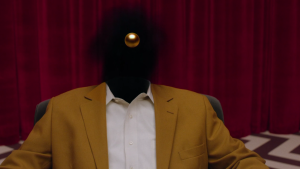 Color seems to be a code here too—the color gold, for instance. We’ve never seen so much gold in a Lynch work—it feels almost gaudy coming from him—and note its prevalence particularly in Episode 3 around Good Cooper’s debut into the real world. Jade’s jeep, the casino, the sport jacket Dougie is wearing before he goes poof (right) and the gold ball he turns into; also Dr. Jacoby’s gold-painted shovels. For the alchemists, “gold” meant (you guessed it) rebirth. The purple color of the rebirth ocean/planet (below) is also interesting, with possible reference to the “astral plane,” often associated with the color purple. There is a lot of Theosophical or pseudo-Theosophical stuff going on here, as we’ll see.
Color seems to be a code here too—the color gold, for instance. We’ve never seen so much gold in a Lynch work—it feels almost gaudy coming from him—and note its prevalence particularly in Episode 3 around Good Cooper’s debut into the real world. Jade’s jeep, the casino, the sport jacket Dougie is wearing before he goes poof (right) and the gold ball he turns into; also Dr. Jacoby’s gold-painted shovels. For the alchemists, “gold” meant (you guessed it) rebirth. The purple color of the rebirth ocean/planet (below) is also interesting, with possible reference to the “astral plane,” often associated with the color purple. There is a lot of Theosophical or pseudo-Theosophical stuff going on here, as we’ll see.
 But another code I’ve detected, and that bears greater exploration I think, consists of a series of interesting cinematic allusions. Lynch seems to be deliberately indexing both his own films but also an assortment of other directors’ works in a somewhat systematic way. Some are the usual suspects like Kubrick; others, though odd on the surface, make greater sense on examination.
But another code I’ve detected, and that bears greater exploration I think, consists of a series of interesting cinematic allusions. Lynch seems to be deliberately indexing both his own films but also an assortment of other directors’ works in a somewhat systematic way. Some are the usual suspects like Kubrick; others, though odd on the surface, make greater sense on examination.
Since I have not seen this “intertextual code” talked about yet, I’m offering it here as my own contribution to the collective fan exegesis, for what it may be worth, along with consideration of the paranormal mythemes Lynch is developing in this breakthrough show.
Lynch is the Monolith and the Ape; Drink Deep, and Descend
Remember that Lynch is a lover of cinema and its history, and has always indexed and referenced other films quite explicitly. He deliberately referenced Ingmar Bergman’s Persona in Mulholland Drive, for instance. So it’s really not surprising he’s doing it again in Twin Peaks. But I think he may be doing it here not only systematically but also semantically—sending a message with some of these film references, not just paying homage to directors he likes.
In the bardo, you can get re-routed and detained, you encounter really creepy beings, and there seem to be multiple levels or staging areas through which you must pass. You wander through it in a daze.
The most obvious references are to films by Kubrick, especially 2001. I think 2001 is the biggest single key to Lynch’s work, especially the final segment “Jupiter and Beyond the Infinite.” Most of Lynch’s films, starting with Eraserhead and Elephant Man and continuing with Twin Peaks and his films of the 1990s and 2000s (everything but Dune, Blue Velvet, and Wild at Heart, essentially), could be seen as “themes and variations” on what happens to Dave Bowman after he passes through the Jovian stargate and becomes the Star Child. (And appropriately enough, a good indicator of whether a person likes Lynch is whether they think 2001 is the most brilliant thing ever or is just meaningless psychedelia. You know where I stand: Don’t be that one man-ape off in back, picking his nose, who doesn’t take any interest in the slab—it’s there to evolve you. Go up and touch it.)
 The various rooms we’ve seen so far in the ‘Rebirth Fortress’ (my name for the place where the technology of reincarnation seems to be housed, and where its caretakers seem to live) on the Purple Planet are very much like the hotel suite in 2001—ambiguous, weirdly “terrestrial” and “historical” places of transition prior to rebirth. I was particularly struck that when we enter the fortress in Episode 8, it is via a black aperture that looks exactly like the 2001 monolith. This is deliberate, and Lynch’s most explicit indicator yet that 2001 is his touchstone for all this.
The various rooms we’ve seen so far in the ‘Rebirth Fortress’ (my name for the place where the technology of reincarnation seems to be housed, and where its caretakers seem to live) on the Purple Planet are very much like the hotel suite in 2001—ambiguous, weirdly “terrestrial” and “historical” places of transition prior to rebirth. I was particularly struck that when we enter the fortress in Episode 8, it is via a black aperture that looks exactly like the 2001 monolith. This is deliberate, and Lynch’s most explicit indicator yet that 2001 is his touchstone for all this.
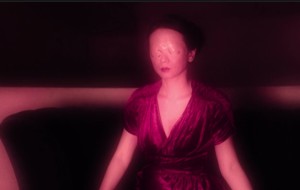 It’s not about Jupiter of course; it’s about what in Tibetan religion—or the faux Tibetan religion delivered by Theosophist Walter Evans-Wentz—is called the bardo, the dimension or plane between lives. Lynch’s specific concern is the things that can go wrong or amiss in the spiritual economy of (re)birth. In the bardo, you can get re-routed and detained, you encounter really creepy beings, and there seem to be multiple levels or staging areas through which you must pass. Nothing makes much sense, and you wander through it in a daze.
It’s not about Jupiter of course; it’s about what in Tibetan religion—or the faux Tibetan religion delivered by Theosophist Walter Evans-Wentz—is called the bardo, the dimension or plane between lives. Lynch’s specific concern is the things that can go wrong or amiss in the spiritual economy of (re)birth. In the bardo, you can get re-routed and detained, you encounter really creepy beings, and there seem to be multiple levels or staging areas through which you must pass. Nothing makes much sense, and you wander through it in a daze.
Kubrick’s own examination of the problem of rebirth and its vicissitudes was The Shining—which he made under the direct influence of Lynch’s Eraserhead (he made the cast watch it); and The Shining in turn was a major influence on Twin Peaks and Lynch’s subsequent work. The various rebirths/possessions through caretaker after caretaker in the Overlook Hotel are a template for the various incarnations of Bob. The Black Lodge with its red curtains is not only like the hotel/bardo of 2001 but also like a “redrum” (i.e., red room).
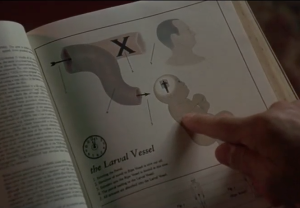 There are other films Lynch is explictly signaling, such as Spike Jonze’s Being John Malkovich. From the first, Dougie’s boss, Bushnell Mullins, a former boxer and founder/owner of “Lucky 7 Insurance,” gave me a strong vibe of Orson Bean as the eccentric Dr. Lester, president of the filing service LesterCorp on the 7 1/2th Floor of the Mertin-Flemmer Building in New York City. Mullins’ interest in Dougie’s cryptic scribbles on the stack of files he had assigned Dougie to work on at home clinched this connection for me. The allusion to Dr. Lester in Jonze’s film is, I think, deliberate: In Being John Malkovich, Lester is a nearly expired “vessel body” for the spirit of the original founder of the company, Captain Mertin, and at one point in the movie we see old diagrams in a book in his home, recalling Theosophy-esque theorizing about “larval vessels” and “ripe vessels” and the transmigration of souls from one body to another. Of all films by other directors, Being John Malkovich captures the essence of what all of Lynch’s oeuvre, and especially Twin Peaks, is about. I doubt it is accidental that John Malkovich himself “channeled” Lynch and the various characters from Twin Peaks a few years ago in a short film. (It’s not very impressive, in my opinion—John Malkovich can’t not seem like John Malkovich. Although maybe that’s the joke.)
There are other films Lynch is explictly signaling, such as Spike Jonze’s Being John Malkovich. From the first, Dougie’s boss, Bushnell Mullins, a former boxer and founder/owner of “Lucky 7 Insurance,” gave me a strong vibe of Orson Bean as the eccentric Dr. Lester, president of the filing service LesterCorp on the 7 1/2th Floor of the Mertin-Flemmer Building in New York City. Mullins’ interest in Dougie’s cryptic scribbles on the stack of files he had assigned Dougie to work on at home clinched this connection for me. The allusion to Dr. Lester in Jonze’s film is, I think, deliberate: In Being John Malkovich, Lester is a nearly expired “vessel body” for the spirit of the original founder of the company, Captain Mertin, and at one point in the movie we see old diagrams in a book in his home, recalling Theosophy-esque theorizing about “larval vessels” and “ripe vessels” and the transmigration of souls from one body to another. Of all films by other directors, Being John Malkovich captures the essence of what all of Lynch’s oeuvre, and especially Twin Peaks, is about. I doubt it is accidental that John Malkovich himself “channeled” Lynch and the various characters from Twin Peaks a few years ago in a short film. (It’s not very impressive, in my opinion—John Malkovich can’t not seem like John Malkovich. Although maybe that’s the joke.)
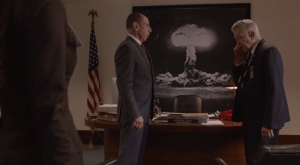 The next one, a Woody Allen reference of all things, will seem odd, but bear with me. After Episode 8, we know that Gordon Cole’s huge photo of a mushroom cloud behind his desk signals his knowledge that the bomb is directly connected to the “Blue Rose” (supernatural) cases that are his special interest. Turns out it was specifically the Trinity test on July 16, 1945 that ripped open the barrier between worlds that let an evil host through. Bob and his evil ilk are seen vomited forth by the evil white figure (see below) who was glimpsed devouring the couple on the couch in Episode 2, in front of the glass box; Bob is shown clearly as this spirit-mother’s darkest progeny. The fire the evil spirits want us to walk with is nuclear fire. Famously, the Manhattan Project’s leader, J. Robert Oppenheimer, later quoted the Bhagavad-Gita in reference to what they had wrought: “I am become death, destroyer of worlds.”
The next one, a Woody Allen reference of all things, will seem odd, but bear with me. After Episode 8, we know that Gordon Cole’s huge photo of a mushroom cloud behind his desk signals his knowledge that the bomb is directly connected to the “Blue Rose” (supernatural) cases that are his special interest. Turns out it was specifically the Trinity test on July 16, 1945 that ripped open the barrier between worlds that let an evil host through. Bob and his evil ilk are seen vomited forth by the evil white figure (see below) who was glimpsed devouring the couple on the couch in Episode 2, in front of the glass box; Bob is shown clearly as this spirit-mother’s darkest progeny. The fire the evil spirits want us to walk with is nuclear fire. Famously, the Manhattan Project’s leader, J. Robert Oppenheimer, later quoted the Bhagavad-Gita in reference to what they had wrought: “I am become death, destroyer of worlds.”
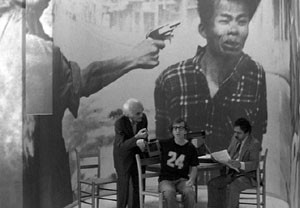 But before we knew this connection, the photo also recalled Woody Allen’s character Sandy Bates in his 1980 homage to Fellini, Stardust Memories. Bates is a film director anxious over his current production (like Marcello Mastroianni’s character in 8 1/2), and to reflect his dark mood his apartment is dominated by a gigantic blow-up of the famous b/w photograph of a South Vietnamese officer executing a Vietcong prisoner, as a reminder of the world’s darkness and atrocity. The significance of this reference may be nothing more than to subliminally activate the phrase “stardust memories” in a viewer who remembers that film—i.e., memories of our past life or origins in the stars (but see below).
But before we knew this connection, the photo also recalled Woody Allen’s character Sandy Bates in his 1980 homage to Fellini, Stardust Memories. Bates is a film director anxious over his current production (like Marcello Mastroianni’s character in 8 1/2), and to reflect his dark mood his apartment is dominated by a gigantic blow-up of the famous b/w photograph of a South Vietnamese officer executing a Vietcong prisoner, as a reminder of the world’s darkness and atrocity. The significance of this reference may be nothing more than to subliminally activate the phrase “stardust memories” in a viewer who remembers that film—i.e., memories of our past life or origins in the stars (but see below).
 On the opposite wall of Cole’s office is another big photo most would find depressing: Franz Kafka. The first free association that comes to mind for me and I assume many people would be the word “metamorphosis”—a man reborn as a bug (most imagine a cockroach, but in the original German it is mistkafer, a dung beetle or scarab, symbol of rebirth). In Episode 8, the Giant (or, the Giant’s father?), one of the caretakers in the Rebirth Fortress, dismayed at nuclear developments on Earth and alarmed at seeing Bob en route, sends his own spirit or seed to combat that evil force. The next scene, taking place in 1956, shows a frog-like winged insect hatching from a meteorite egg, which crawls into the body of a girl, no doubt to possess or impregnate her.
On the opposite wall of Cole’s office is another big photo most would find depressing: Franz Kafka. The first free association that comes to mind for me and I assume many people would be the word “metamorphosis”—a man reborn as a bug (most imagine a cockroach, but in the original German it is mistkafer, a dung beetle or scarab, symbol of rebirth). In Episode 8, the Giant (or, the Giant’s father?), one of the caretakers in the Rebirth Fortress, dismayed at nuclear developments on Earth and alarmed at seeing Bob en route, sends his own spirit or seed to combat that evil force. The next scene, taking place in 1956, shows a frog-like winged insect hatching from a meteorite egg, which crawls into the body of a girl, no doubt to possess or impregnate her.
 [The following updated 6/29/17 in light of reader comments.] Is the bug the terrestrial manifestation of the Giant and is the girl destined to be a savior figure? Is she Sarah Palmer, Laura’s Mom? (We saw Laura’s face in the Giant’s orb before his wife(?) sends it on its way to Earth, although 1956 is still about a decade and a half too early for Laura’s ‘conception.’) Or is the bug the larval form of Bob or one of his brethren, whose eggs were also seen in the ectoplasmic vomit spewed by the ‘spirit mother’? Whatever the case, we are likely to see a Kafkaesque transformation at some point. After the episode aired, Daniel McGachey (@DMcGachey) tweeted the picture above, from a 1991 book Twin Peaks: An Access Guide to the Town. It is clearly the source for the creature. The text describes a Chinook legend about “the ancestress of the Frog Clan” who was covered with these winged frog creatures. If any readers have any further information about this bit of mythology, or know if it is genuine, please let me know in comments.
[The following updated 6/29/17 in light of reader comments.] Is the bug the terrestrial manifestation of the Giant and is the girl destined to be a savior figure? Is she Sarah Palmer, Laura’s Mom? (We saw Laura’s face in the Giant’s orb before his wife(?) sends it on its way to Earth, although 1956 is still about a decade and a half too early for Laura’s ‘conception.’) Or is the bug the larval form of Bob or one of his brethren, whose eggs were also seen in the ectoplasmic vomit spewed by the ‘spirit mother’? Whatever the case, we are likely to see a Kafkaesque transformation at some point. After the episode aired, Daniel McGachey (@DMcGachey) tweeted the picture above, from a 1991 book Twin Peaks: An Access Guide to the Town. It is clearly the source for the creature. The text describes a Chinook legend about “the ancestress of the Frog Clan” who was covered with these winged frog creatures. If any readers have any further information about this bit of mythology, or know if it is genuine, please let me know in comments.
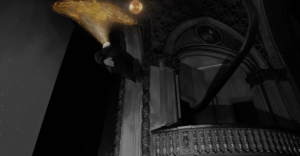 With the pictures in his office, Lynch (as Gordon Cole) seems to be signaling not only the origin of evil in our world but also possibly a pathway to redemption. The fact that the Giant and his wife—keepers of the fortress, presumably—interact with earth via a kind of newsreel projection also calls to mind cinema as the interface or mediator of rebirth. Also, as the giant’s suspended body is generating his seed/egg, his head produces a shower of golden sparkles, like stardust. After the orb is beheld and kissed by the Giant’s wife, a golden machine (@Dharmapoppins aptly compares it to a fallopian tube) projects the three-dimensional “golden orb” into the flat newsreel picture, where it then makes its way to Earth. The movie screen as uterus.
With the pictures in his office, Lynch (as Gordon Cole) seems to be signaling not only the origin of evil in our world but also possibly a pathway to redemption. The fact that the Giant and his wife—keepers of the fortress, presumably—interact with earth via a kind of newsreel projection also calls to mind cinema as the interface or mediator of rebirth. Also, as the giant’s suspended body is generating his seed/egg, his head produces a shower of golden sparkles, like stardust. After the orb is beheld and kissed by the Giant’s wife, a golden machine (@Dharmapoppins aptly compares it to a fallopian tube) projects the three-dimensional “golden orb” into the flat newsreel picture, where it then makes its way to Earth. The movie screen as uterus.
Hal Ashby’s great film Being There is another obvious reference for this series. Good Cooper (as Dougie Jones) ambles through life like the childlike gardener Chance (Peter Sellers). Like Chance, Cooper/Dougie is at this point a blank cipher on which other people project what they want to see/hear, and they guide him to success inadvertently. It is significant that “chance” as in luck (e.g., “Lucky 7 Insurance” and his luck at the casino, or in evading the hitmen) is so much a part of Good Cooper’s story at this point. Again, Lynch may simply be referencing the phrase “being there,” as in “be there” or “be here now”—i.e., be present in your life.
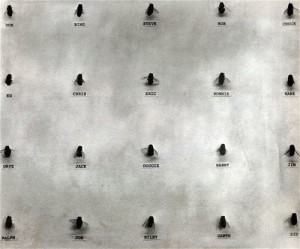 Lynch is also explicitly citing/alluding to his own works. This could easily turn into a long rabbit hole but I’ll just mention a few: “Dougie” for instance is name of the central “Rickie” in Lynch’s most famous “Rickie Board,” his 1994 Bee Board. The idea is to make a 4 by 5 array of identical objects or “Rickies”—Lynch most often used drawings of or actual dead insects like flies—and put a different name under each of them. An amazing effect is produced that each identical insect comes to take on a distinct personality because of its name. The reborn, amnesic Dale Cooper is a bit like a Rickie, a cipher being given shape and form by the name “Dougie” people use for him.
Lynch is also explicitly citing/alluding to his own works. This could easily turn into a long rabbit hole but I’ll just mention a few: “Dougie” for instance is name of the central “Rickie” in Lynch’s most famous “Rickie Board,” his 1994 Bee Board. The idea is to make a 4 by 5 array of identical objects or “Rickies”—Lynch most often used drawings of or actual dead insects like flies—and put a different name under each of them. An amazing effect is produced that each identical insect comes to take on a distinct personality because of its name. The reborn, amnesic Dale Cooper is a bit like a Rickie, a cipher being given shape and form by the name “Dougie” people use for him.
 Then there’s Eraserhead, of course: The fortress on the Purple Planet through which souls pass on their way to rebirth has a definite Eraserhead vibe. Remember the “Man in the Planet” who pulls a lever and releases the sperm-like seeds that become the deformed baby. Much of Episode 3 (the space box with its lever) and Episode 8 recall this Gnostic mechanism of cosmic insemination and rebirth. That film of course is about “things that can go wrong with birth,” a theme Lynch also revisited in his next film, Elephant Man.
Then there’s Eraserhead, of course: The fortress on the Purple Planet through which souls pass on their way to rebirth has a definite Eraserhead vibe. Remember the “Man in the Planet” who pulls a lever and releases the sperm-like seeds that become the deformed baby. Much of Episode 3 (the space box with its lever) and Episode 8 recall this Gnostic mechanism of cosmic insemination and rebirth. That film of course is about “things that can go wrong with birth,” a theme Lynch also revisited in his next film, Elephant Man.
And of course there is Mulholland Drive. I’ve written before about the importance of The Cowboy as a stand-in for Lynch in his most scolding, preacher mode: Stop bein’ a smart-aleck and pay attention, is what Lynch’s ultimate message for us full-of-ourselves, wise-ass humans is. Well, the other message The Cowboy delivers in that film is “time to wake up.” It is interesting that Lynch has cast Naomi Watts as the bewildered/protective wife of the befuddled Dougie—essentially reprising her role as the innocent rescuer/helper of the amnesic Rita in Mulholland Drive—and that their son, “Sonny Jim,” is in his obsessions (and flickering on/off lamp) a cowboy. The moving scene in Episode 4 when Cooper/Dougie stares at Sonny Jim in the driveway and begins to cry represents his beginning to wake up, and I imagine we can expect Sonny Jim to play a further role in Dale Cooper’s process of awakening, possibly in Episode 9.
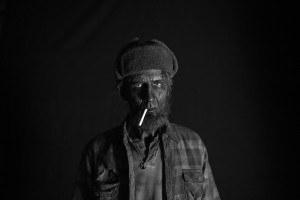 The shambling, soot-faced evil spirits that swarm in and around the famous Convenience Store (above which Mike once lived with Bob in their killin’ days) are reminiscent of the evil presence behind Winky’s diner in Mulholland Drive. “The Woodsman” who we met in Episode 8 and wants a light, kills the folks at the radio station, and hypnotizes the New Mexico town with his chant about the water and the well, etc., is like the creature behind Winky’s crossed with Abraham Lincoln (speaking in a voice that uncannily sounds like John Huston’s Gandalf in the 1977 Rankin Bass version of The Hobbit, which added a further dimension of strangeness for me). Turns out that not long before they filmed Twin Peaks, the actor who plays the Woodsman was also in a very short, very funny film called Linclone, about an evil clone of Lincoln, so there you go.
The shambling, soot-faced evil spirits that swarm in and around the famous Convenience Store (above which Mike once lived with Bob in their killin’ days) are reminiscent of the evil presence behind Winky’s diner in Mulholland Drive. “The Woodsman” who we met in Episode 8 and wants a light, kills the folks at the radio station, and hypnotizes the New Mexico town with his chant about the water and the well, etc., is like the creature behind Winky’s crossed with Abraham Lincoln (speaking in a voice that uncannily sounds like John Huston’s Gandalf in the 1977 Rankin Bass version of The Hobbit, which added a further dimension of strangeness for me). Turns out that not long before they filmed Twin Peaks, the actor who plays the Woodsman was also in a very short, very funny film called Linclone, about an evil clone of Lincoln, so there you go.
Gotta Guiding Light?
In all his interviews and published writings, Lynch projects an image of himself as a “pure artist,” right-brained, somewhat inarticulate about the meaning of his work (or unwilling to speak about it) but full of folksy wisdom. When Mitch Horowitz asked Lynch in a recent excellent radio interview (produced by my wife Laura Kwerel, so that’s a plug) whether he’d ever seen a ghost or a UFO, he said “No I haven’t” and did not elaborate. But clearly he (along with Mark Frost, his cowriter) knows a lot about the paranormal and the occult. And with the new Twin Peaks, Lynch is more clearly than ever telling a spiritual story via the medium of paranormal science fiction. Where the original series was like an occult-inflected soap opera, this one is turning into something much more epic, like a comic book, complete with superpowers and origin stories. Thus a great lens through which to view this unprecedented TV event is the work of Jeffrey Kripal, who mapped the core mythemes of the paranormal “super story” in his books Mutants and Mystics and The Super Natural.
With the new Twin Peaks, Lynch is more clearly than ever telling a spiritual story via the medium of paranormal science fiction.
Most obviously there is the “mytheme of radiation.” Ever since Lynch’s earliest work and especially in all the incarnations of Twin Peaks, energy in the form of electricity is the carrier of spirit. Lynch is obsessed with flickering lights, bad connections, old bakelite lamps and clocks, and power lines. In both Fire Walk With Me and the beautiful/devastating Episode 6 of the new series, Harry Dean Stanton’s character Carl has visions associated with the power lines that hang unnoticed over the streets of his town. And when Dale Cooper is reborn through an electrical outlet in an empty Rancho Rosa home, I was thinking: Lynch must have been reading Kripal. The strange pylons in the Fortress of Rebirth and on the space box in Episode 3 are somehow transformers of electrical-spiritual energy. Somehow, the rebirth system on our planet utilizes or co-opts human technology.
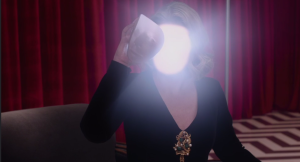 In this Twin Peaks incarnation, Lynch is also showing us more explicitly what he thinks about light as such. Early on, Laura Palmer in the Black Lodge pulls aside her face to reveal to Dale Cooper that she is a creature of light. Carl watches dumbstruck as the golden soul of the boy killed by Richard Horne’s truck ascends to the power lines above, where presumably he will be rerouted to some central reincarnational transformer. Lynch is showing his spiritual hand in this series more than ever before. As Yoda tells Luke Skywalker in The Empire Strikes Back, “Luminous beings are we, not this crude matter.” Lynch clearly agrees with Yoda. Lynch may be Yoda.
In this Twin Peaks incarnation, Lynch is also showing us more explicitly what he thinks about light as such. Early on, Laura Palmer in the Black Lodge pulls aside her face to reveal to Dale Cooper that she is a creature of light. Carl watches dumbstruck as the golden soul of the boy killed by Richard Horne’s truck ascends to the power lines above, where presumably he will be rerouted to some central reincarnational transformer. Lynch is showing his spiritual hand in this series more than ever before. As Yoda tells Luke Skywalker in The Empire Strikes Back, “Luminous beings are we, not this crude matter.” Lynch clearly agrees with Yoda. Lynch may be Yoda.
But there is also the Trinity mushroom cloud, and the Kubrick-esque journey inside it—one of the most beautiful visions I’ve ever seen on TV or in film, and a concrete historical reference I never quite expected from Lynch. Clearly this is a bad form of “radiation” that allows an unprecedented evil to gain access to our planet.
“Mutation” is another obvious mytheme throughout Lynch’s work, of course, and is the obvious result of radiation. Physical mutation describes the idea of “(re)birth gone awry,” beginning with Eraserhead and Elephant Man and Balthasar Getty’s character in Lost Highway (“reborn” with strange bumps on his head), not to mention the “evolution of the arm” (see below) and the various human body types and shapes (extremely fat, extremely thin, giants, dwarves, etc.) that appear throughout his work. In the new Twin Peaks I’m marveling at the interesting-looking actors Lynch has found to work with: people with Neandertal-esque brow ridges (Ray), weirdly sloping foreheads (the evil Richard Horne), and so on.
But then there is mutation as in “rebirth with superpowers,” and it is Good Cooper/Dougie who is showing us this new, more extravagantly sci-fi/comic-book side of Lynch. Cooper navigates the casino, seeing “Black Lodge icons” over the slot machines (“one-armed bandits,” colloquially—more on “arms” below) that will pay a jackpot; a green light flashing on coworker Anthony’s face tells him the man is lying; and lights on his “homework” guide his pencil. It is a kind of sixth sense or precognition manifesting—as it often does in real life—as literal “guiding lights.”
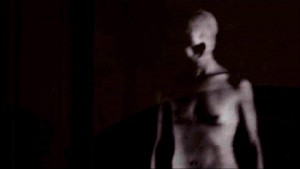 And there is the “mytheme of alienation.” This has been present from the start of the original series: Who are these entities in the Black Lodge? But it is becoming more and more explicit that they are not from or of our world, but that our own technology has allowed them to gain access. I have always wished Lynch would tell a full-on sci-fi story (forgetting Dune, of course), and now I am getting my wish. The amphibian-beetle from a meteorite egg in the New Mexico desert (which then crawls into the mouth of the sleeping girl) is the most explicitly “alien” creature Lynch has ever created, with the possible exception of the baby in Eraserhead. Then of course there is the eyeless ‘spirit mother’ (above). Lynch is more boldly saying that these “spirits” are really alien. They are not just projections of our own shadow selves.
And there is the “mytheme of alienation.” This has been present from the start of the original series: Who are these entities in the Black Lodge? But it is becoming more and more explicit that they are not from or of our world, but that our own technology has allowed them to gain access. I have always wished Lynch would tell a full-on sci-fi story (forgetting Dune, of course), and now I am getting my wish. The amphibian-beetle from a meteorite egg in the New Mexico desert (which then crawls into the mouth of the sleeping girl) is the most explicitly “alien” creature Lynch has ever created, with the possible exception of the baby in Eraserhead. Then of course there is the eyeless ‘spirit mother’ (above). Lynch is more boldly saying that these “spirits” are really alien. They are not just projections of our own shadow selves.
Spiritual Coffee
Clearly this reincarnation of Twin Peaks is pointing toward a spiritual tradition and practice, much more explicitly than any of Lynch’s previous works. The metaphysics has overtones of Theosophy (especially as smuggled via Evans-Wentz’s not-really-Buddhist-but-more-Theosophical Tibetan Book of the Dead) and Gnosticism (extraterrestrial spirits controlling rebirth on our planet, etc.). But I feel pretty confident that Lynch has no new message here that we couldn’t find in his other works, albeit perhaps more obliquely: Pay attention, wake up, dive within, and stop being a smart-aleck (in no particular order). Being good people follows from that. More than any artist, Lynch knows how to indicate the Good by means of the Bad—his work is full of unforgettable archetypes of obliviousness, lack of compassion, selfishness, and greed, as well as archetypes of innocence, compassion, simplicity, goodness. The polarity is explicit.
Remember that Lynch wants us to wake up in THIS world, the real world.
There’s no mystery about Lynch’s ultimate intent as an artist, and that is to get us to meditate. He’d specifically like us all to be Transcendental Meditators, because he thinks that’s the only real route to bliss and what he calls the “unified field.” He found TM as a young man and never looked back, and consequently proselytizes narrowly for it. But I’ve written before about how Zen meditation will get you just as quickly to the same place Lynch seems to go. That place is incredibly rewarding, and it does feel just like Twin Peaks, and you do get great ideas (“big fish”) when you’re faithful about it. I’m sure that any number of meditative/mystical practices will do the same. So, believe Lynch when he talks about TM, just mentally strike the T and the implied trademark after it: You just need the M, free of charge, and whatever flavor speaks to you … but you do need to do it, daily.
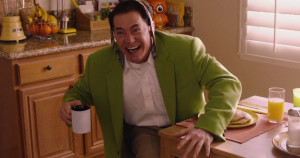 But also remember that Lynch wants us to wake up in THIS world, the real world. His puzzle films like Mulholland Drive reveal themselves to be lures to our desire to make connections, but we are meant to be spit out the other side with a renewed clarity that none of it is real, that it’s “all a recording.” He has planted a million little puzzles in Twin Peaks—we’ll all be poring over this for years—but the ultimate aim I’m sure is to bring us out the other side of our interpretive quest when we realize, with a kind of shock, that it is all a show.
But also remember that Lynch wants us to wake up in THIS world, the real world. His puzzle films like Mulholland Drive reveal themselves to be lures to our desire to make connections, but we are meant to be spit out the other side with a renewed clarity that none of it is real, that it’s “all a recording.” He has planted a million little puzzles in Twin Peaks—we’ll all be poring over this for years—but the ultimate aim I’m sure is to bring us out the other side of our interpretive quest when we realize, with a kind of shock, that it is all a show.
Thus I wouldn’t be surprised if there is some slap-you-in-the-face “Club Silencio” type scene before we are through, driving this point home. To an extent, the Roadhouse concerts sort of play that role: They break the fourth wall in a sense and create a bridge to the real world. I like to think, though, that in the last episode, the actors will all break character and appear on the dancefloor of the Roadhouse, as themselves, like the awesome celebratory end credits in Inland Empire.
The Devil Will Find Work for Idle Arms to Do
Lynch’s favorite symbol for what roots us in evil and suffering and ignorance is arms. We’ve known explicitly since Fire Walk With Me that Bob possesses people through their arms: Their arms go numb before they become his vessels. The one-armed man, remember, cut off his own arm to escape his possession by Bob’s evil companion in killing, Mike. I think arms are Lynch’s way of showing the idea of clinging/grasping as what holds us back from the good, and keeps us on the surface of life, preventing us from diving deep.
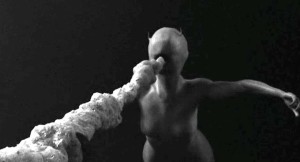 By this logic, the one-armed-man’s recalled self-amputation (from the original series) seems to represent “getting rid of grasping/clinging,” a great metaphor that every ancient Zen teacher still flickering on some eternal Chinese mountainside undoubtedly wishes he thought of. Also, recall how Laura Palmer said that sometimes her arms bend back, which we all thought was a reference to Bob (as her father Leland) tying her up in the train car where he raped and killed her … but now we have a new meaning: The supremely evil vomiting spirit mother’s arms are on backwards (something I only noticed when I looked closely at the still reproduced here). This seems like another kind of perversion of desire or attachment.
By this logic, the one-armed-man’s recalled self-amputation (from the original series) seems to represent “getting rid of grasping/clinging,” a great metaphor that every ancient Zen teacher still flickering on some eternal Chinese mountainside undoubtedly wishes he thought of. Also, recall how Laura Palmer said that sometimes her arms bend back, which we all thought was a reference to Bob (as her father Leland) tying her up in the train car where he raped and killed her … but now we have a new meaning: The supremely evil vomiting spirit mother’s arms are on backwards (something I only noticed when I looked closely at the still reproduced here). This seems like another kind of perversion of desire or attachment.
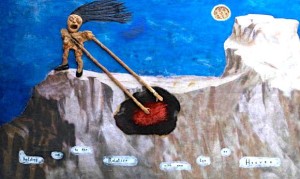 Lynch is obsessed with arms in his paintings as well: One of his lithographs is “Arm of Sores,” for instance, and many of his paintings such as “Boy Lights Fire” or “Pete Goes to His Girlfriend’s House” have evil figures with greatly elongated arms, doing or about to do mischief. And there is “Holding on to the Relative with One Eye on Heaven” (shown here).
Lynch is obsessed with arms in his paintings as well: One of his lithographs is “Arm of Sores,” for instance, and many of his paintings such as “Boy Lights Fire” or “Pete Goes to His Girlfriend’s House” have evil figures with greatly elongated arms, doing or about to do mischief. And there is “Holding on to the Relative with One Eye on Heaven” (shown here).
The neuron-like arm-tree in the Black Lodge, “the evolution of the arm,” on one hand seems to symbolize “making connections” (which we can connect to A.X.X.O.N.N. in Inland Empire)—and his/its role in Episode 7 makes this clear: It appears precisely to remind Dougie/Cooper of his FBI self-defense training: “squeeze his hand off.” In other words: reminding you of something you already know but just haven’t “made the connection.” The scary psychopath Ike the Spike clearly has “gripped too tightly” since the police have to peel his skin off the pistol grip after he flees the scene.
Lest we read too much into the arm’s “evolution,” however, remember that it was dictated principally by the refusal of Michael J. Anderson to reprise his role as the Man From Another Place (a.k.a. “dancing dwarf,” a.k.a. “Mike’s arm”) due to some personal dispute with Lynch. It’s too bad, he had much more personality than the tree, and was a better dancer.
When Will Bowie Show Up?
This is more a fan hope than a fan theory, but I think Lynch’s indirect denials to the contrary, it is altogether possible that David Bowie will show up late in the series reprising his role as Philip Jeffries, the FBI agent who disappeared in Buenos Aires after investigating someone named Judy. Lynch was able to film Catherine Coulson (the Log Lady), who was also dying of cancer and who died months before Bowie did. It would be just like the two Davids, the two greatest American artists of our time (I sort of consider Bowie American), to pull a surprise like this. Fans will go nuts. Bowie would have realized that, and being so concerned with legacy and sending a message to the future, would have done whatever he could to pop up as a surprise in Lynch’s show. These men, of all people, would have made it happen if they could.
 An added hunch: If Bowie does appear, it will be in Episode 15, the day before the big eclipse, and there may be additional Blackstar allusions or tie-ins. Remember that that song also is about a spirit rising from a dead body and being replaced by another; and remember that the video featured a headless skeleton floating in space. Twin Peaks seems to be “going there” in all kinds of ways, including the headless corpse of Major Briggs (possibly after a UFO journey that caused him to not age) and the various references to Jeffries and calls to a transforming black box in Buenos Aires, where Jeffries was last seen.
An added hunch: If Bowie does appear, it will be in Episode 15, the day before the big eclipse, and there may be additional Blackstar allusions or tie-ins. Remember that that song also is about a spirit rising from a dead body and being replaced by another; and remember that the video featured a headless skeleton floating in space. Twin Peaks seems to be “going there” in all kinds of ways, including the headless corpse of Major Briggs (possibly after a UFO journey that caused him to not age) and the various references to Jeffries and calls to a transforming black box in Buenos Aires, where Jeffries was last seen.
 I’ve been getting a “Blackstar vibe” from this series in other ways: Lynch has been signaling his interest in ritual magic in his paintings for a few years now (see the 2013 painting at left, for instance, “Red Man Does Magic Near His House”), and though it hasn’t yet surfaced in his films, we were treated to a big time evil ritual over the wounded Evil Cooper/Bob in Episode 8, and we may see more of the same as the series progresses. That the savior of humanity from the likes of Bob might be ultimately in the hands of women (the message of Bowie’s “Blackstar” video, i.e. a ritual replacing “ISIS” and its various dark masculine permutations with Isis the goddess) seems likely in Twin Peaks too. If the 1956 girl is the vessel for the good Giant from the Purple Planet (versus the vessel for Bob or one of his fellows, see above), perhaps she will play some savior role. Whatever the case, the series certainly seems to be taking an epic direction.
I’ve been getting a “Blackstar vibe” from this series in other ways: Lynch has been signaling his interest in ritual magic in his paintings for a few years now (see the 2013 painting at left, for instance, “Red Man Does Magic Near His House”), and though it hasn’t yet surfaced in his films, we were treated to a big time evil ritual over the wounded Evil Cooper/Bob in Episode 8, and we may see more of the same as the series progresses. That the savior of humanity from the likes of Bob might be ultimately in the hands of women (the message of Bowie’s “Blackstar” video, i.e. a ritual replacing “ISIS” and its various dark masculine permutations with Isis the goddess) seems likely in Twin Peaks too. If the 1956 girl is the vessel for the good Giant from the Purple Planet (versus the vessel for Bob or one of his fellows, see above), perhaps she will play some savior role. Whatever the case, the series certainly seems to be taking an epic direction.
If Bowie appears, he might have also reserved a new unreleased song to appear in Lynch’s series (and its much anticipated soundtrack album), so I would expect some other performer (perhaps one of the cast of Lazarus?) to perform it at the Roadhouse.
Again, this is fan hope as much as fan theory, but I’m keeping my arm’s fingers crossed.
I’ll update this post as new information emerges, as readers chime in (please chime in), and most likely as I’m proved wildly wrong.
Postscript: Arms Don’t Bend Back
The question of arms and how they properly behave happened to be central to the Satori (enlightenment) experience of Zen writer and teacher Daisetz Suzuki, who brought Zen to America in the middle decades of the last century. In an autobiographical essay he described that his initial kensho, or a kind of luminous awakening attained after intense koan meditation, was only deepened and solidified by a second, subsequent realization some days later: that arms do not bend back:
After kensho, I was still not fully conscious of my experience. I was still in a kind of dream. The greater depth of realization came later … when suddenly the Zen phrase hiji soto ni magarazu, “the elbow does not bend outwards,” became clear to me. “The elbow does not bend outwards” might seem to express a kind of necessity, but suddenly I saw that this restriction was really freedom, the true freedom, and I felt that the whole question of free will had been solved for me.
This kind of “duh” realization about something as simple as the elbow joint is a distinctive Zen experience. It expresses exactly what I was getting at in my previous post, about the paradoxical freedom that comes from the limitation implied by the Minkowski block universe. Enlightenment comes from this kind of revelatory awareness of physical limitation, while ignorance (and darkness) is its denial … as in Lynch’s evil arm perversions.
Master Minkowski’s Wild Ducks (Zen and the Glass Block Universe)
Probably because I am thinking about (and trying to finish a book on) precognition and retrocausation and the glass block universe they seem to imply, I keep finding my thoughts returning to a famous Zen koan from 8th-century China. You will have heard it: Master Ma and his student Pai Chang were walking along when they encountered a flock of wild ducks. “What is that?” Ma said. “Wild ducks,” Pai Chang answered. “Where have they gone?” Ma asked? “They’ve flown away,” Pai Chang said … at which point Master Ma grabbed his student’s nose and gave it a painful twist: “When have they ever flown away!”
The considerable evidence of precognition and retrocausation points to the reality of something like the glass block, the already-ness of the future and the persistence of the past.
There are many versions of the story, and many translations of the different versions. R.H. Blyth’s version spells out Ma’s meaning a bit, in case we are confused (which we are): “When did they ever fly away?” Ma says, “They have been here from the beginning!” Blyth’s Games Zen Masters Play (where this appears) probably was a strong influence on J.D. Salinger when he was writing The Catcher in the Rye; Holden Caulfield’s constant obsession with where the ducks at the lake in Central Park go in wintertime is an allusion to this koan. (Indeed, the whole novel is sort of about it, and about the young narrator’s gradual coming to a slightly more Zen-like understanding of questions of life and death, permanence and change.)
This “public case” (the original meaning of koan) has many layers, and it is important not to think that Pai Chang, just because he got his nose twisted, was wrong in saying that the ducks were gone. In their play-by-play commentary on these ancient dharma battles, some writers declare Pai-Chang the victor, not Ma. There’s Zen virtue in telling it just like it is. But the significance of this story that is obviously relevant to my obsession with precognition is this notion of permanence that Master Ma’s words imply: “When did they ever fly away?” is like an assertion of Hermann Minkowski’s argument, based on his student Einstein’s theory of relativity, that things in the past are still here, and that things that haven’t happened yet are here already.
 If Pai Chang, with his sore nose, is a bit like Heraclitus, who found that you can’t step in the same river twice, Ma is a bit like his counterpart in these debates, the shaman/mystic Parmenides, and also his later interpreter Zeno, asserting the permanence within apparent impermanence.
If Pai Chang, with his sore nose, is a bit like Heraclitus, who found that you can’t step in the same river twice, Ma is a bit like his counterpart in these debates, the shaman/mystic Parmenides, and also his later interpreter Zeno, asserting the permanence within apparent impermanence.
I’ve always been a Heraclitus man myself, and a couple years ago on this blog I rebelled against the glass block and the Eternalism it entailed, even going so far as accusing outspoken Eternalist Alan Moore of being a hoarder: Minkowski glass-block-ism, where “every condom, every syringe, every beer can is preserved in Jerusalem’s gutters,” seemed to me like a hoarder’s cosmology. I’ve changed my mind in the intervening time. I think that, like many people when confronting these questions, I allowed my knee-jerk, heavily culture-bound assumption of free will and the open-endedness of things to prevent me from considering the possible reality, realism, and even spiritual satisfactions of Minkowski’s glass block.
The Bird is the Word
Compare “Master Ma’s Wild Ducks” with a painfully beautiful anecdote from Bede’s Ecclesiastical History of the English People about the conversion of the Anglo-Saxons to Christiantiy. In the 6th century, the Northumbrian king Edwin was confronted by pressures to renounce his paganism and embrace the new religion; uncertain what was right, he took counsel with his “ealdormen and thegns” (advisors and nobles) on this question, and one of them stated his own opinion using the metaphor of a sparrow:
This is how the present life of man on earth, King, appears to me in comparison with that time which is unknown to us. You are sitting feasting with your ealdormen and thegns in winter time; the fire is burning on the hearth in the middle of the hall and all inside is warm, while outside the wintry storms of rain and snow are raging; and a sparrow flies swiftly through the hall. It enters in at one door and quickly flies out through the other. For the few moments it is inside, the storm and wintry tempest cannot touch it, but after the briefest moment of calm, it flits from your sight, out of the wintry storm and into it again. So this life of man appears but for a moment; what follows or indeed what went before, we know not at all. If this new doctrine brings us more certain information, it seems right that we should accept it.
I’ve always thought about the cold harsh uncertain life of those men in that hall—the same people who sang stories of the monster Grendel lurking in the wild wastes and muscular heroes like Beowulf who could bring temporary peace to their windswept fragile little kingdoms. For Edwin’s counselor (and for centuries of the Venerable Bede’s English readers), Christ was a kind of hero who could save us from the cold uncertainty of what awaited us beyond this mortal life—a solace the poor sparrow could not enjoy.
Christ, with His redeeming retrocausal tachyon blood, offered the exact same solution that Master Ma was offering Pai Chang: a way out of time, yet within time.
I also always think about that sparrow, flying in one door of a fire-warmed Anglo-Saxon hall and out the opposite door back into the cold. It is just like the wild ducks in the Chinese story: Not only has it flown away and gone, but it’s also (at the same time) there permanently, indelibly etched in the mind of every reader of Bede’s passage, frozen in mid-hall. Its flickering transit is eternal; it has always been there and always will be there.
 Having been raised in an atheist household, I for long time had trouble grasping the spiritual appeal of Christianity, with its seeming focus on death and even torture (Christ nailed to the Cross). It helped my understanding greatly to eventually read Bede’s account, and much later to realize that Christ, with His redeeming retrocausal tachyon blood, may have been offering the exact same solution and the same hope to those grim Anglo-Saxons that Master Ma was offering Pai Chang: a way out of time, yet within time. Thanks to Bede, and Master Ma, I get it.
Having been raised in an atheist household, I for long time had trouble grasping the spiritual appeal of Christianity, with its seeming focus on death and even torture (Christ nailed to the Cross). It helped my understanding greatly to eventually read Bede’s account, and much later to realize that Christ, with His redeeming retrocausal tachyon blood, may have been offering the exact same solution and the same hope to those grim Anglo-Saxons that Master Ma was offering Pai Chang: a way out of time, yet within time. Thanks to Bede, and Master Ma, I get it.
Through a Glass Block, Darkly
The Ming Dynasty Zen master Han-Shan recorded a direct enlightenment experience of the glass block. According to Guo-gu Shi:
Han-shan came across the stories of a Bramacharin who had left home in his youth and returned when he was white-haired. When people saw him, the neighbors asked, “Is that man [whom we know] still living today?” The Bramacharin replied, “I look like that man of the past, but I am not he.” On reading this story “Han-shan suddenly understood that all things do not come and go. When he got up from his seat and walked around, he did not see things in motion. When he opened the window blind, suddenly a wind blew the trees in the yard, and the leaves flew all over the sky. However, he did not see any signs of motion. When he went to urinate, he still did not see signs of flowing. He understood what the text spoke of as, “Streams and rivers run into the ocean and yet there is no flowing.” At this time, Hanshan shattered all doubt and existential concerns about birth and death.
Han-Shan might want to ask his doctor about the “no signs of flowing.” But in my own humble Zen practice, I too have had these brief altered perceptions that “nothing is really happening” even when things are visibly in flux in front of my eyes. I think there’s real truth to what those guys were experiencing back on their misty Chinese mountainsides (and are still experiencing).
There is real liberation in letting go of the weighty idea that we Westerners always carry around with us, that our actions are open-ended and thus that we bear responsibility for the world.
The biggest surprise of pursuing this whole business of precognition is discovering that it was never really about expanded human potential in the sense of developing some superpower. Experiencing precognition invariably brings you face to face with the limitations of mortal life and the futility to change your fate (or wyrd, as King Edwin would have called it). It has thus, unexpectedly, acted for me as a kind of koan, reinforcing again and again these spiritually surprising experiences of stasis-within-flux.
 There is real liberation in letting go of the weighty idea that we Westerners always carry around with us, that our actions are open-ended and thus that we bear responsibility for the world. They aren’t. And we don’t. Again, at least on some deep, hard-to-describe level. Paradoxically, in a Zen way, this realization makes you more free, not less, as well as more responsible for the world around you.
There is real liberation in letting go of the weighty idea that we Westerners always carry around with us, that our actions are open-ended and thus that we bear responsibility for the world. They aren’t. And we don’t. Again, at least on some deep, hard-to-describe level. Paradoxically, in a Zen way, this realization makes you more free, not less, as well as more responsible for the world around you.
It is an evidence-based Zen realization. The considerable evidence of precognition (and more generally, retrocausation) points to the reality of something like the glass block, the already-ness of the future and the persistence of the past. Whether the block is really sturdy glass or something a bit more viscous, like tree sap, or possesses a variable viscosity, is an open question. For now, we must just say that the mysteries of the glass block passeth understanding and our vision of time really is through a glass, darkly.
No Impossible Futures
To hold firm that it really is a Minkowski universe has implications for parapsychology in addition to spirituality. I think many investigators of precognition who argue that we precognize “possible futures,” on an analogy with the quantum wavefunction, are barking up the wrong tree. If the quantum neuroscience model I’ve been advocating is right, we precognize actual futures, but obliquely, unclearly, and in ways whose non-paradoxical-ness only becomes clear in hindsight.
The brain seems to be a tesseract, a tunnel from birth to death, bringing us oblique information about our already-exising future and dressing up that information in sometimes realistic but often quite oblique or deceptive costumes.
For example, you are never going to have a completely accurate and clear precognitive dream about an outcome you would or could intercede to prevent. It’s not that the causality police will swoop in in their flying saucers to stop you; it’s just that, from a future vantage point farther along your world-line in the block universe, it didn’t happen. No amount of searching in hindsight will find spent causal arrows for an impossible event. Things that couldn’t happen, never did.
According to this view, premonitions of dangers averted don’t necessarily represent those dangers per se, but the troubled thoughts and emotions experienced in their aftermath. For instance, in a case recorded by Louisa Rhine, a woman had a vivid dream in which her baby was crushed to death by a chandelier that had been hanging over the crib. Defying her husband’s urge to just ignore the dream and go back to sleep, she went and got their baby and brought her into their bed to sleep. Two hours later, they heard a crash in the nursery.
It was not that the woman’s premonition accurately showed her an event in a possible future, “a timeline not taken.” Rather, it accurately showed her her own horrified imagining of a terrible possibility, a “what if” (what if she’d ignored her dream); and because of her action, this premonition became part of a “time loop” formation in the glass block universe. Thankfully, because her mental image refluxed in time and caught her awareness two hours earlier, and she acted on it, her baby was with her and not in the nursery when the chandelier crashed onto the crib. But I really doubt there’s an other, parallel universe where the baby was in the crib when it happened.
 We should not confuse our imagination, our ability to picture many nonexistent worlds, or our ability to picture the universe from an imagined vantage point outside history, with real perception. It’s all a brain-generated hologram, a creation of Zen’s biggest frenemy, Solaris Mind.
We should not confuse our imagination, our ability to picture many nonexistent worlds, or our ability to picture the universe from an imagined vantage point outside history, with real perception. It’s all a brain-generated hologram, a creation of Zen’s biggest frenemy, Solaris Mind.
We can imagine “many worlds” all we want—it makes for fun thought experiments—but if I am right, the interpretation of quantum mechanics that leads to the many worlds idea is an effect of denying the future’s influence on the past. Once retrocausation is fully embraced, many worlds may look less appealing or realistic. Black holes might really create new universes; but I suspect our choices from moment to moment, or the seemingly random “choices” of every particle at every instant, do not. (Talk about a hoarder’s cosmology!)
Remembering Past Life
As I’ve argued many times in these posts, the brain seems to be a tesseract, a tunnel from birth to death, bringing us oblique information about our already-existing future and dressing up that information in sometimes realistic but often quite deceptive and obscure costumes. More generally, all living organisms, and systems within living organisms, seem to metabolize time, utilizing quantum biological processes to converge on optimal and efficient courses of action more than chance would predict.
The looping formations of chemistry and cause that are tantamount to life take on increasingly subtle and beautiful forms as you scroll forward through the glass block.
The emergence of complex forms has variously been attributed to some extra feature of matter, such as “morphic fields” or “syntropy.” The latter is probably pretty close to the reality, although it is not a cosmic liking of order per se, so much as a molecular and cellular tendency to organize by post-selecting on efficient outcomes, creating an overall illusion of a kind of cosmic Platonism (seen from our now-bound point of view).
I find the possibilities of Minkowski-ism increasingly inspiring and exciting. The future doesn’t look like the past, for one thing. The looping formations of chemistry and cause that are tantamount to life (and possibly, consciousness) take on increasingly subtle and beautiful forms as you scroll forward through the glass block. This is what the second law of thermodynamics and even the theory of complex systems cannot quite predict or describe.
 The fate of the universe does seem to be toward a kind of super-intelligence, perhaps a super organism, that can actually reach back and remember itself and even remember “past life,” its pre-superconscious formations. Intelligent life in our epoch could be an early adumbration of what intelligence will become and the kinds of increasingly fractal causal loops it will manifest.
The fate of the universe does seem to be toward a kind of super-intelligence, perhaps a super organism, that can actually reach back and remember itself and even remember “past life,” its pre-superconscious formations. Intelligent life in our epoch could be an early adumbration of what intelligence will become and the kinds of increasingly fractal causal loops it will manifest.
Thus if there is a higher consciousness, and a collective (un)conscious, it is in the future. What we call our consciousness may be memory of our lives from a distant future viewpoint.* I suppose it is all along what Christians back in the day meant. The afterlife really was something “after” all our lives—a resurrection occurring in the Not Yet, at the end of days.
Postscript: Me Go Zen™ in Your Coke Forever
As I imagine Han-Shan trying to empty his bladder in(to) Minkowski’s glass-block universe “with no signs of flowing,” my inner 2nd-grader can’t not think of a really racist schoolyard rhyme that was “going around” the playground one week at Kendrick Lakes Elementary School, circa 1974. Maybe you know the one. It was somehow the punchline of a really hilarious (to a Watergate-era 2nd-grader in racially homogeneous Lakewood, CO) story that I can no longer recall. But I’ll never forget the rhyme: “Me Chinese man, me play joke, me go pee-pee in your Coke.”
This image provoked, in addition to mirth, no small amount of reflection on human malice, as I tried to wrap my 7-year-old head around the horror of a monstrous Asian urinating in a person’s beverage, and the horror of drinking said beverage. I didn’t have that many friends, so I probably didn’t serve as a vector of this rhyme, merely an appreciative audience. But now I wonder: Was Han-Shan that Chinese Man?
Is Han-Shan still and forever pee-peeing in my Coke? When did he ever stop!
Whether or not he was Han-Shan or somebody else, that Chinese man is real … especially now that he is in your mind. Zen would ask you to take the Chinese man’s pee-Coke as a koan and see where it gets you.
NOTE
* In one of my early “glass block” moments, in the mortality-dread haze not long after 9/11, I was meditating on the DC Metro on my way to work, on the elevated tracks somewhere between Vienna and West Falls Church, and I suddenly realized that “this” was all being remembered, and thus that death—at least in the near future—was impossible. “I” (or something remembering me) was clearly “still alive” at some future time point from which I was remembering that moment on the train.
I didn’t know how far ahead the memory’s vantage point was—it may have been seconds or minutes or years.** But I have found since then that it makes a nice Zen exercise to repeat “this is a memory” and overlay that perception like a projection onto your experience, and see what happens after a little while.
FRACTAL NOTE-WITHIN-NOTE
** Perhaps right now, writing this, was the vantage point from which, on the train 16 years ago, I was still alive. That would make the ‘time to afterlife’ roughly 16 years … if it is a constant, and the afterlife is merely lived memory.
What Was Your Original Face on Mars?—Zen and the Prophetic Sublime
The famous “Face on Mars,” first photographed by the Viking orbiters in 1976, was the object of much speculation in the 1980s and 1990s and continues to be. After it was identified by Richard C. Hoagland, the Face became the central icon in a narrative of ancient global destruction—perhaps nuclear war—that, some suggested, may have tragically rendered our nearest cosmic neighbor a dead world, aeons in the past. The Face, staring out at the universe, seemed like it could be both a monument and a warning to our species … if it was a face.
The Face on Mars was eminently psi-worthy. Multiple artists’ encounters with this haunting image seem to have rippled back in time.
Later NASA photographs (such as the one below) revealed greater erosion, less symmetry, and a much less human visage than Viking’s low-res cameras; it’s not a face at all, most now agree, just an oddly eroded mesa. Yet what matters for me is the meme, the haunting idea sparked by those original pictures, which captured the imagination not only of the public but also of many scientists for years.
 Even the ever-skeptical Carl Sagan felt the Face deserved study, having himself always suggested the possibility that we might find alien ruins in our solar system. Although he distanced himself from wilder speculations about the feature, the dreadful possibility of a civilization destroying itself in a nuclear war was one that was close to his heart as a disarmament activist; it also happened to be Mars’s dust storms that gave him his first model of “nuclear winter.” Later writers like Mac Tonnies and physicist John Brandenburg elaborated on the ideas of a Martian apocalypse in prehistory, and the Mars Anomaly community retains a belief that the Face is artificial and that NASA and/or its contractors have manipulated later images to make it look otherwise.
Even the ever-skeptical Carl Sagan felt the Face deserved study, having himself always suggested the possibility that we might find alien ruins in our solar system. Although he distanced himself from wilder speculations about the feature, the dreadful possibility of a civilization destroying itself in a nuclear war was one that was close to his heart as a disarmament activist; it also happened to be Mars’s dust storms that gave him his first model of “nuclear winter.” Later writers like Mac Tonnies and physicist John Brandenburg elaborated on the ideas of a Martian apocalypse in prehistory, and the Mars Anomaly community retains a belief that the Face is artificial and that NASA and/or its contractors have manipulated later images to make it look otherwise.
The Face on Mars “meme complex” falls into a very specific aesthetic-psychological category, that of the sublime. The sublime was named by philosophers and aestheticians in the 18th Century (like Immanuel Kant, Edmund Burke, and Joseph Addison) to describe the specific feeling evoked by landscapes and works of art that suggest immensity and destruction. Towering thunderclouds and storms at sea, scenes of massive destruction on a Biblical scale, and wild landscapes with ruins in them all fit into this category. (Originally, the sublime was elevated above the merely beautiful as something that mainly men were able to savor and enjoy; the ‘weaker sex’ was believed to prefer pleasant domestic scenes, flowers, and other images that were not so existentially challenging.)
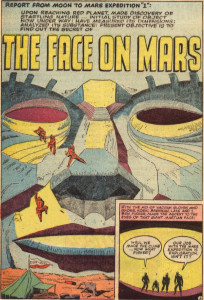 The sublime is highly relevant to psi, I believe. It happens to be precisely these kinds of sublime scenes and situations—including fires, shipwrecks, natural disasters, and haunted ruins in a dead landscape—that have always dominated people’s spontaneous accounts of ESP experiences. The many dreams and prophecies of the Titanic or 9/11 are examples, as are many of the “phantasms of the living” catalogued by the Society for Psychical Research in the 1880s. Thus it is not surprising that at least two prominent artists notably seem to have precognized the Face on Mars, the most famous “space ruin.” The best known, thanks in large part to Chris Knowles, is comic artist Jack Kirby, who wrote and illustrated a story called “The Face on Mars” in 1958—in which astronauts to the Red Planet explore a massive stone face and one of them receives a mind-transmission hologram showing the interplanetary war that laid waste the planet long ago. Kirby not only “saw” the face, in other words, but the whole meme-complex that formed around it (ancient planetary war and destruction).
The sublime is highly relevant to psi, I believe. It happens to be precisely these kinds of sublime scenes and situations—including fires, shipwrecks, natural disasters, and haunted ruins in a dead landscape—that have always dominated people’s spontaneous accounts of ESP experiences. The many dreams and prophecies of the Titanic or 9/11 are examples, as are many of the “phantasms of the living” catalogued by the Society for Psychical Research in the 1880s. Thus it is not surprising that at least two prominent artists notably seem to have precognized the Face on Mars, the most famous “space ruin.” The best known, thanks in large part to Chris Knowles, is comic artist Jack Kirby, who wrote and illustrated a story called “The Face on Mars” in 1958—in which astronauts to the Red Planet explore a massive stone face and one of them receives a mind-transmission hologram showing the interplanetary war that laid waste the planet long ago. Kirby not only “saw” the face, in other words, but the whole meme-complex that formed around it (ancient planetary war and destruction).
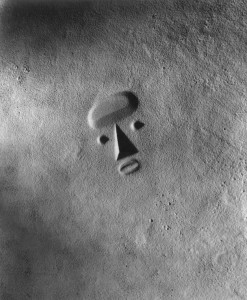 Eleven years earlier, in 1947—almost three decades before the Face was imaged by Viking—the Japanese-American sculptor Isamu Noguchi created a one-foot-square sand model for an earthwork called “Sculpture to be seen from Mars” and took a photograph of his model. All we now have is that photo, and it looks uncannily like Viking’s photograph, including the tilt at which it appears in the artist’s photo. The proposed dimensions of the earthwork, to be built in some “unused area” like a desert, are of a similar scale (Noguchi’s face was to be ten miles long, its nose a mile in height; the actual “Face” mesa in the Cydonia region on Mars is a little over a mile long). But more uncanny than the physical resemblance is the purpose of Noguchi’s earthwork: to signal the human presence to the cosmos in the aftermath of our species’ demise in a nuclear holocaust. It was, Noguchi said, “a requiem for all of us who live with the atom bomb.” At the time, following the destruction of two Japanese cities by such weapons, Noguchi worried that a world-destroying conflict was inevitable.
Eleven years earlier, in 1947—almost three decades before the Face was imaged by Viking—the Japanese-American sculptor Isamu Noguchi created a one-foot-square sand model for an earthwork called “Sculpture to be seen from Mars” and took a photograph of his model. All we now have is that photo, and it looks uncannily like Viking’s photograph, including the tilt at which it appears in the artist’s photo. The proposed dimensions of the earthwork, to be built in some “unused area” like a desert, are of a similar scale (Noguchi’s face was to be ten miles long, its nose a mile in height; the actual “Face” mesa in the Cydonia region on Mars is a little over a mile long). But more uncanny than the physical resemblance is the purpose of Noguchi’s earthwork: to signal the human presence to the cosmos in the aftermath of our species’ demise in a nuclear holocaust. It was, Noguchi said, “a requiem for all of us who live with the atom bomb.” At the time, following the destruction of two Japanese cities by such weapons, Noguchi worried that a world-destroying conflict was inevitable.
So here again, an artist seems to have prophesied not only a famous object/photograph but also the sublime meme complex surrounding it—although in Noguchi’s version, Mars and Earth swapped roles.
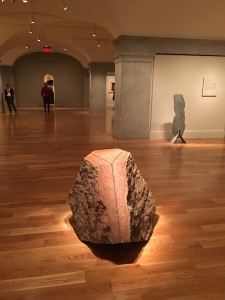 Noguchi was still alive and active in 1976, and right up to his death in 1988. He was intensely interested in science and technology all his life, including both nuclear weapons and space exploration. His 1970 granite sculpture Re-Entry Cone (right) is clearly based on an Apollo Command Module; one of his last works was a Miami monument to the astronauts killed in the Challenger disaster. So there is no doubt in my mind that he would have been aware of and interested in the Viking missions as well as the resurgent concerns about nuclear war during the Reagan era, when the ‘Face on Mars as remnant of a destroyed Martian civilization’ meme took shape. My regular readers will know that I think precognition centers on future exciting encounters and learning experiences during an individual’s lifetime. Kirby too was still alive and active at the time of the Viking missions and through the 1980s, dying in 1994 (and his comic would not have been influenced by Noguchi’s proposed sculpture, since the latter only existed in a single unpublished photograph).
Noguchi was still alive and active in 1976, and right up to his death in 1988. He was intensely interested in science and technology all his life, including both nuclear weapons and space exploration. His 1970 granite sculpture Re-Entry Cone (right) is clearly based on an Apollo Command Module; one of his last works was a Miami monument to the astronauts killed in the Challenger disaster. So there is no doubt in my mind that he would have been aware of and interested in the Viking missions as well as the resurgent concerns about nuclear war during the Reagan era, when the ‘Face on Mars as remnant of a destroyed Martian civilization’ meme took shape. My regular readers will know that I think precognition centers on future exciting encounters and learning experiences during an individual’s lifetime. Kirby too was still alive and active at the time of the Viking missions and through the 1980s, dying in 1994 (and his comic would not have been influenced by Noguchi’s proposed sculpture, since the latter only existed in a single unpublished photograph).
The Sublime Semiotics of Prophecy
The sublime, or aesthetic pleasure in signs of destruction, is essentially identical to the Lacanian notion of jouissance and to the older Freudian notion of “death drive.” It was Freud who most brilliantly theorized these childhood roots of the sublime. In his 1920 essay Beyond the Pleasure Principle, Freud described watching his toddler grandson repeatedly throwing a spool over the side of his crib and exclaiming “fort” (gone), then pulling it back and enjoying its return, “da” (there), and then doing the same thing with his own reflection in a mirror. Playing with loss and recovery is a way of conceptually mastering the idea of nothingness/annihilation. Paintings of sublime scenes stage this same pleasure at annihilation-and-return, losing and finding again, but on a grander scale.
This sense of “but I survived” is the basis of the sublime, the semiotic language of prophecy.
As I argued in the context of Thomas Pynchon’s prescient-about-prescience novel Gravity’s Rainbow (about an American officer whose sexual response anticipates V2 strikes during the Blitz), the “psi reflex” really orients to rewards, not only sexual rewards (as in Daryl Bem’s and Dean Radin’s presentiment experiments involving erotic pictures) but also the reward of surviving some chaotic or entropic threat. Although psychical phenomena and ESP have always been linked to “trauma,” this notion masks the fact that they really seem to key in on signals of survival: Implicitly, if you’re traumatized, then you’ve survived. If psi, as precognition, is a biological function, it has to have emerged and prevailed as an adaptive trait, orienting the organism toward its own future survival/reproduction or that of its kin.
 This sense of “but I survived” is the basis of the aesthetic sublime: Enjoyment of the fact that I’m still here, even amid these signs of ruin. It is why the sublime perfectly describes the semiotic language of prophecy. Some of those on the Star Gate remote viewing project, such as Edwin May and Dale Graff, have argued that our psi faculty keys in on actual entropy gradients like fires, explosions, and nuclear reactions. The accuracy of remote viewers when assigned such targets is a crucial fact, but it misses the important point that signs of entropy in the past, or symbols of entropy that never really existed, may be just as vivid to our psi eyes as the real thing.* I suspect psi, as precognition, is a fundamentally semiotic phenomenon, involving a sensitivity to associatively encoded information refluxing from the brain’s own future and not entropic ripples through spacetime.
This sense of “but I survived” is the basis of the aesthetic sublime: Enjoyment of the fact that I’m still here, even amid these signs of ruin. It is why the sublime perfectly describes the semiotic language of prophecy. Some of those on the Star Gate remote viewing project, such as Edwin May and Dale Graff, have argued that our psi faculty keys in on actual entropy gradients like fires, explosions, and nuclear reactions. The accuracy of remote viewers when assigned such targets is a crucial fact, but it misses the important point that signs of entropy in the past, or symbols of entropy that never really existed, may be just as vivid to our psi eyes as the real thing.* I suspect psi, as precognition, is a fundamentally semiotic phenomenon, involving a sensitivity to associatively encoded information refluxing from the brain’s own future and not entropic ripples through spacetime.
It was a big aha moment in my own study of precognitive dreams when I realized that sublime signifiers like ruins, as well as fossils and other “subterranean” images, which in Freudian and Jungian dream interpretation are easily taken as signs of past-ness, actually seemed to be pointers of a precognitive or future meaning. (I strongly recommend others engaged in precognitive dreamwork check to see if this holds for them as well.) It makes a counterintuitive sense: Ruins and fossils and bones and caves and other “buried” things are things awaiting discovery. They are fragments of some story still latent in the landscape, and thus they lie in one’s future, not one’s prior history. Our “unconscious minds” (whatever that means) understand this, even if our conscious selves don’t.
 Culturally conditioned assumptions about time and memory, the persistence of the past, and the metaphoric likening of remembering to excavating traces left in the earth, have always distorted our perception of cognitive processes and only helped obscure the precognitive dimension of mental functioning. Centuries of psychology and philosophy have focused on how we are ruled by our past, without considering how the memory and history might be masks concealing our prophetic nature.
Culturally conditioned assumptions about time and memory, the persistence of the past, and the metaphoric likening of remembering to excavating traces left in the earth, have always distorted our perception of cognitive processes and only helped obscure the precognitive dimension of mental functioning. Centuries of psychology and philosophy have focused on how we are ruled by our past, without considering how the memory and history might be masks concealing our prophetic nature.
Another aspect of the sublime is extreme contrast: Pictures or stories conveying enormity versus smallness, eternity versus the immediate, and extreme age versus newness/futurity provoke this uneasy fascination with our own finitude. Noguchi’s work was sublime in exactly this sense: It savored the contrast between immensity and intimacy, alienness and familiarity, technology and nature. Hayden Herrera suggests that, in addition to being a memorial for humanity, bringing two planets and two ideas, the new and old, into juxtaposition, the face may also have been meant as a monument to Noguchi’s father, Yone Noguchi, who had died that same year (1947) in Japan. I would suggest that these immediate inspirations—grief over his father and the possible demise of humanity—acted as a concrete nucleus “constellating” a sublime premonition of the Face on Mars.
The Face on Mars was eminently psi-worthy, a kind of cosmic ‘fort-da’ in which humanity seemed to find, impossibly, its own reflection but also a distressing mirror of its own mortality, on a distant world. Multiple artists’ encounters with this haunting image seem to have rippled back in time along the resonating string of their creative jouissance.
A Religion of the Void
The Face on Mars always reminds me of one of the most famous Zen koans: “What was your original face before your mother and father were born?”**
One of the most characteristic motifs in sci-fi is the idea of traveling to the ends of the universe and finding something of our own that we have lost or forgotten.
Credit for bringing Zen to America is always given to Daisetz Suzuki, who in turn influenced popularizers like Alan Watts. As Kay Larson notes in her wonderful book Where the Heart Beats, the musician John Cage also did much to explicate Suzuki’s ideas for the art world, not only in his music but also in his books and lectures. But I think it was Cage’s friend Noguchi who probably deserves even more credit for the silent Zen transmission … to America and to science fiction. Zen, with its emphasis on Void and Nothingness, is the most sublime as well as the most science-fictional of religions.
 Zen is famously a wordless transmission: According to legend, the disciples all gathered to hear Sakyamuni Buddha deliver a sermon, but all he did was pick up a flower and twirl it in his fingers. Just one disciple, Kashyapa, “got it” and made a little smile. This was the birth of Zen. (In Japanese, the “Flower Sermon” is called nengemisho, literally “pick up flower, subtle smile.”) Every aspect of mid-century design in America was influenced by Noguchi’s work and is thus a wordless transmission of Zen not unlike the Buddha’s holding up of the flower. His techno-organic minimalist coffee tables and his Akari lamps are way more Zen, in a truly sublime way, than the famously Zen-inspired designs of Apple products, and America “got it” without even knowing. Noguchi’s designs were hugely influential. My apartment was full of cheap Ikea Akari-inspired lamps, for instance, long before I knew about Noguchi.
Zen is famously a wordless transmission: According to legend, the disciples all gathered to hear Sakyamuni Buddha deliver a sermon, but all he did was pick up a flower and twirl it in his fingers. Just one disciple, Kashyapa, “got it” and made a little smile. This was the birth of Zen. (In Japanese, the “Flower Sermon” is called nengemisho, literally “pick up flower, subtle smile.”) Every aspect of mid-century design in America was influenced by Noguchi’s work and is thus a wordless transmission of Zen not unlike the Buddha’s holding up of the flower. His techno-organic minimalist coffee tables and his Akari lamps are way more Zen, in a truly sublime way, than the famously Zen-inspired designs of Apple products, and America “got it” without even knowing. Noguchi’s designs were hugely influential. My apartment was full of cheap Ikea Akari-inspired lamps, for instance, long before I knew about Noguchi.
 They were partly influential through the vehicle of science fiction. I think Noguchi shaped the iconography of mid- to late-century SF more than anybody realizes: His sculptures from the 1940s (such as Remembrance, right) are direct precursors of Richard Powers’ pulp sci-fi covers of the 1950s and 1960s for example—they are the same techno-organic forms, rendered solidly in metal and stone instead of paint. Noguchi’s furniture, such as his classic coffee table (below), could be models for alien furnishings used throughout the original Star Trek series. And several of Noguchi’s stone and clay sculptures could easily be the model for the aeons-old star gate in the iconic Star Trek Season One episode “The City on the Edge of Forever.” If H.R. Giger’s “biomechanoids” came to define alienness post-1979, it was the more enigmatic and cerebral Zen-inspired forms created by Noguchi and transmitted via Star Trek and SF book covers that defined it prior to that.
They were partly influential through the vehicle of science fiction. I think Noguchi shaped the iconography of mid- to late-century SF more than anybody realizes: His sculptures from the 1940s (such as Remembrance, right) are direct precursors of Richard Powers’ pulp sci-fi covers of the 1950s and 1960s for example—they are the same techno-organic forms, rendered solidly in metal and stone instead of paint. Noguchi’s furniture, such as his classic coffee table (below), could be models for alien furnishings used throughout the original Star Trek series. And several of Noguchi’s stone and clay sculptures could easily be the model for the aeons-old star gate in the iconic Star Trek Season One episode “The City on the Edge of Forever.” If H.R. Giger’s “biomechanoids” came to define alienness post-1979, it was the more enigmatic and cerebral Zen-inspired forms created by Noguchi and transmitted via Star Trek and SF book covers that defined it prior to that.
 Science fiction has always been the genre most suited to expressing the sublime. One of the most, if not the most, characteristic motifs in sci-fi is the idea of traveling to the ends of the universe (via the most futuristic technology) and finding something of our own that we have lost or forgotten, something belonging to the past, even something impossibly ancient. How many Star Trek episodes had this basic premise: finding some relic of Earth’s spacefaring past, encountering (impossibly) some figure from Earth’s history or a planet whose civilization is based on some Earth society, or meeting some simulacra of a lost love? When Dave Bowman travels through the Jovian stargate only to find himself in a French Rococo hotel suite, or when Kris Kelvin travels all the way to Solaris only to find his dead ex girlfriend, these are all expressions of this same idea.
Science fiction has always been the genre most suited to expressing the sublime. One of the most, if not the most, characteristic motifs in sci-fi is the idea of traveling to the ends of the universe (via the most futuristic technology) and finding something of our own that we have lost or forgotten, something belonging to the past, even something impossibly ancient. How many Star Trek episodes had this basic premise: finding some relic of Earth’s spacefaring past, encountering (impossibly) some figure from Earth’s history or a planet whose civilization is based on some Earth society, or meeting some simulacra of a lost love? When Dave Bowman travels through the Jovian stargate only to find himself in a French Rococo hotel suite, or when Kris Kelvin travels all the way to Solaris only to find his dead ex girlfriend, these are all expressions of this same idea.
Whenever a Noguchi exhibition comes to one of the Smithsonian museums in Washington DC, like the “Archaic/Modern” exhibit currently at the American Art Museum, I walk among his sculptures and pottery and lamps and furniture with a sense of familiarity; this is the sublime sci-fi aesthetic of my childhood. It is precisely the comfort of that aesthetic (and not the ever-nauseating autumn leaves and sand gardens and bald kneeling monks) that led me to Zen when I was an adult. Zen is a sci-fi religion, totally portable and baggage-free, thus the perfect religion for space travel—a religion of the Void.
Zen is also a psi religion. Zen comes from dhyana, which just means meditation; meditation (along with dream recording) is an essential practice for developing an awareness of our precognitive functioning. As I’ve hectored you before: If you don’t have a meditative practice (whether Zen or Dzogchen or TM or something), what are you waiting for?
Ancient Faces in the Clouds of Causality
Although it is more speculative, another artist who might join Kirby and Noguchi in the MFC, the Mars Face Club, is Ron Walotsky, an illustrator best known for doing most of the covers for the Magazine of Fantasy and Science Fiction as well as many SF book covers from the late 1960s through the end of the millennium. His cover for a 1970 Pyramid Books edition of Arthur C. Clarke’s Against the Fall of Night shows a cracked landscape with an enormous upturned face earthwork on the horizon.
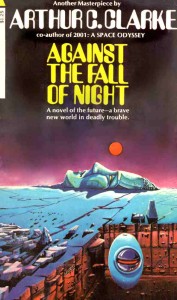 Clarke’s novel, originally written in 1953, is about a young man’s journey outside his protected city on a far-future Earth, long since devastated by an interplanetary war. There is no face in the story like the one on the cover—Walotsky, in the tradition of Powers, was embellishing—yet the whole novel is clearly on the same themes as the Face on Mars meme: the sublime contrast of ancient and futuristic, distance and intimacy, as well as dim memory of an ancient aeons-ago conflict. An ancient face gazing up at the stars seems to suggest a remnant of a civilization that once looked outward (and forward) but long since withdrew and stagnated.
Clarke’s novel, originally written in 1953, is about a young man’s journey outside his protected city on a far-future Earth, long since devastated by an interplanetary war. There is no face in the story like the one on the cover—Walotsky, in the tradition of Powers, was embellishing—yet the whole novel is clearly on the same themes as the Face on Mars meme: the sublime contrast of ancient and futuristic, distance and intimacy, as well as dim memory of an ancient aeons-ago conflict. An ancient face gazing up at the stars seems to suggest a remnant of a civilization that once looked outward (and forward) but long since withdrew and stagnated.
Revitalizing human civilization after untold years of stagnation in some protected enclave or a global dark age is nearly as common a motif in SF as far journeying only to find one’s past, and the motifs are often found together. The end of Planet of the Apes or Logan’s Run come to mind here, of course. Walotsky died in 2002; whether he was precognizing the Face on Mars when he did his illustration or was simply inspired by somewhat similar images in then-recent SF, such as the Statue of Liberty on the beach in Planet of the Apes, is impossible to say.
But the more I delved into Walotsky and his life and work, the more interesting I found him. His work is full of images of masks, for one thing, and his most interesting fine-art works were real masks made from the shells of horseshoe crabs. He described that his initial inspiration for this series, which he called “Ancient Warriors of Lost Civilizations,” came from staring at one of these shells one day, and it appeared to him like a face—in other words, the same pareidolia that led people to see a face in an eroded Martian mesa.
 Walotsky honored this vision with his masks from the late 1980s up until his death, perhaps not consciously recalling the very real “source” for this idea that, as someone with a love of space and science fiction, he would undoubtedly have seen: Carl Sagan’s Cosmos series in 1980, specifically the segment in Episode Two about the Heike crabs of the Inland Sea in Japan. The 1185 battle of the Heike clan against the Genji clan was fought on the shores of this sea, and a species of crab with a wrinkled carapace occasionally produced specimens that seemed face-like. These were preferentially saved from the fishermen’s nets, tossed back into the water (fort-da again!) … and thus an inadvertent selective breeding, over the centuries, led to a prevalence of crabs with a samurai grimace, believed in folk tradition to be ghosts of the Heike warriors.
Walotsky honored this vision with his masks from the late 1980s up until his death, perhaps not consciously recalling the very real “source” for this idea that, as someone with a love of space and science fiction, he would undoubtedly have seen: Carl Sagan’s Cosmos series in 1980, specifically the segment in Episode Two about the Heike crabs of the Inland Sea in Japan. The 1185 battle of the Heike clan against the Genji clan was fought on the shores of this sea, and a species of crab with a wrinkled carapace occasionally produced specimens that seemed face-like. These were preferentially saved from the fishermen’s nets, tossed back into the water (fort-da again!) … and thus an inadvertent selective breeding, over the centuries, led to a prevalence of crabs with a samurai grimace, believed in folk tradition to be ghosts of the Heike warriors.
The Heike crabs, with their warrior faces, are more than a bit like the Face on Mars—living monuments of an ancient destructive war. But these “ghosts” have also been shaped, sculpted, precisely by generations of human selection. There are no real ghosts, in other words, only a subtle and accelerated Darwinian process, abetted by pareidolia and forgetting—just as Walotsky may have seen and forgotten a fascinating/haunting segment in a PBS series and taken inspiration from it in his art.
Since it is only ever confirmed in hindsight, skeptics can always make a similar argument against the reality of precognition: It is the retrospective view on the past, inevitably reframed by salient events, that produces seeming prophecies, faces in the clouds of causality. The first task in the study of prophecy is establishing the extent to which our own activity in the present, scouring the past for precedents and selecting them out of a larger mass of irrelevancies, actually produces alleged coincidences instead of simply discovering them. When assessing Walotsky’s cover illustration for Against the Fall of Night, I lean toward “mere coincidence” rather than precognitive inspiration … but there is never any way to be sure.
NOTES
* Here’s a good example. One night in the Summer of 2013 (August 9, to be exact) I recorded in my dream diary: “hypnagogic vision of an old but crisp/unread paperback from the 70s about some esoteric science-fictioney topic, with a dark blue or black, orange, and red starburst cover.” The concentric colorful radiating circles suggested an explosion of light or perhaps consciousness; the next morning I went to my bookshelf to pull out an old pulp collection by Alfred Bester called Starburst, but the cover showed a moon of Mars and a rocket, nothing like in my vision.
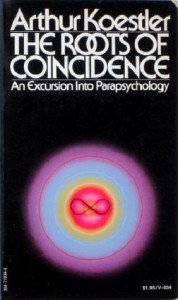 The very next day, on August 10, I was in an unfamiliar city, Providence, RI, on a trip with my wife’s family, and as I always do in new towns, I immediately gravitated to the used bookstores. Perusing the occult section of Paper Nautilus bookstore on South Angell Street, my eye fell on the black spine of The Roots of Coincidence by Arthur Koestler and I slid it out, astonished to find that it had nearly the exact cover I had seen on drifting to sleep two nights earlier. The colors were slightly more dark and muted, and there was a small infinity symbol in the center that I had not seen; but otherwise it was the same concentric starburst design in the lower two thirds of an otherwise black cover, the same familiar 1970s paperback size and feel and smell and typography, and it was on precisely the somewhat science-fictional themes that were then obsessing me. (Although I knew Koestler as a journalist on political topics, I was then unaware that the study of ESP and coincidences had dominated his interests during the last couple decades of his life.)
The very next day, on August 10, I was in an unfamiliar city, Providence, RI, on a trip with my wife’s family, and as I always do in new towns, I immediately gravitated to the used bookstores. Perusing the occult section of Paper Nautilus bookstore on South Angell Street, my eye fell on the black spine of The Roots of Coincidence by Arthur Koestler and I slid it out, astonished to find that it had nearly the exact cover I had seen on drifting to sleep two nights earlier. The colors were slightly more dark and muted, and there was a small infinity symbol in the center that I had not seen; but otherwise it was the same concentric starburst design in the lower two thirds of an otherwise black cover, the same familiar 1970s paperback size and feel and smell and typography, and it was on precisely the somewhat science-fictional themes that were then obsessing me. (Although I knew Koestler as a journalist on political topics, I was then unaware that the study of ESP and coincidences had dominated his interests during the last couple decades of his life.)
Finding Koestler’s surprising book was quite a reward, and it proved to be a crucial touchstone for me in my thinking and writing about chance and coincidence. But more importantly, it was just the first of many examples I have recorded of entropic images and symbols I have encountered in my reading, most often on the Internet, soon after receiving some kind of psychic preview in my dreams or hypnagogic states. A picture merely suggesting a entropic event like an explosion is just as fascinating to the precognitive unconscious as a real one.
** Implicit in Zen’s “What was your original face?” is an invitation to make that face. Hint: We carry much of our stress, as well as much of what we are thinking or feeling, in our face. It produces a noticeable felt shift, a profound centering, just to become conscious of whatever grimace your face has hardened into and just “blanking” the face—erasing it of all expression, completely relaxing all facial muscles.
For some, the jury is still out on what the Face on Mars is. But all of it, the whole meme, including the uncertainty, should help solve the koan about your original face. Be like the face on Mars: ancient, impassive, alien, and empty—and possibly, no actual “face” at all.
Zen, Signs, and the Arrival of Meaning
Even though they were widely panned when they came out and have now been mostly forgotten, I have a soft spot for M. Night Shyamalan’s films from the early 2000s—Unbreakable, Signs, and The Village. Signs, especially, I thought was a satisfying, intimate-scale sci-fi film about alien invasion, but it lost many of its viewers by the end because the aliens were a bit cheesy, as was the ultimate message. This is always Shyamalan’s problem: He frequently has interesting paranormal premises but can never quite pull off making them believable; you kind of have to see through the faults to appreciate what he’s attempting.
Zen is the religion of our future precognitive selves. When we step out of the linear world of desire, we enter the circular world of enjoyment, taking immense pleasure in things just as they are.
“Synchronicity” is the ideology of most Hollywood cinema, and Shyamalan is blatant about pushing belief in it as the moral of the story in Signs. After his wife’s death, Mel Gibson’s character (a former Episcopal priest) has lost his faith, no longer believes anything has meaning, etc. His kids and his younger brother (Joaquin Phoenix) hate him for this. But in the end, he rediscovers his faith in “signs” (i.e., synchronicity) when his family is threatened. He beats the alien intruder in his home by piecing together the random flotsam of his family members’ foibles into a coherent, life-saving message that the universe was all along trying to send him: his wife’s dying words that his brother, a former failed baseball player, should “swing away,” plus his daughter’s constant annoying habit of leaving half-drunk glasses of water around the house. He realizes his brother just needs to splash the alien with a glass of water using his baseball bat and then go to town on it. (I suppose, when you put it that way, it is kind of dumb.)
Denis Villeneuve’s recent masterpiece Arrival reminds me of all the best things about Signs minus the overreach, cheesiness, and problematic message. For one thing, Signs’ slow, suspenseful opening act, centered on one family’s experience, via the media, of the ominous appearance of UFOs over major cities, might as well be the template for the first act of Arrival. The structure of both films—telling the story of a tense and uncertain “first contact” via a character living under the shadow of loss—is the same; both films tack back and forth between the present alien conflict and “flashbacks” of the death of a loved one. And nearly identical to Signs is the way Louise Banks (Amy Adams’ character) in Arrival solves the problem facing her and humanity by realizing the true meaning of her random thoughts, which she had previously overlooked or misinterpreted.
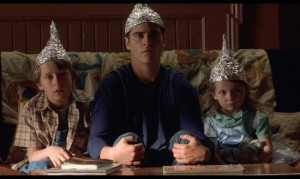 In other words, Arrival is like a permutation of the same set of thematic elements or mythemes (including even somebody’s wife’s dying words playing a key role), but they are rearranged into a much more compelling narrative in which the “meaningful events” that seem like the standard tragic Hollywood backstory (dying family member, etc.) in fact emerge as a story the character chooses, warts and all, in her future—a forestory. As I mentioned in my previous post, I don’t agree that precognition could ever be so conscious or clear as depicted in Arrival; but I admire the effort and the fact that Villeneuve told a much more interesting cinematic story on these themes than most other directors would have. The “uplift” at the end of the film is just right: a brief and inspiring peek into a world where we realize that we are prophetic beings but just don’t know it. I obviously really believe this is true—there is abundant evidence for it, both experimental and anecdotal.
In other words, Arrival is like a permutation of the same set of thematic elements or mythemes (including even somebody’s wife’s dying words playing a key role), but they are rearranged into a much more compelling narrative in which the “meaningful events” that seem like the standard tragic Hollywood backstory (dying family member, etc.) in fact emerge as a story the character chooses, warts and all, in her future—a forestory. As I mentioned in my previous post, I don’t agree that precognition could ever be so conscious or clear as depicted in Arrival; but I admire the effort and the fact that Villeneuve told a much more interesting cinematic story on these themes than most other directors would have. The “uplift” at the end of the film is just right: a brief and inspiring peek into a world where we realize that we are prophetic beings but just don’t know it. I obviously really believe this is true—there is abundant evidence for it, both experimental and anecdotal.
These similarities, but crucial differences, between Signs and Arrival are really instructive for clarifying the difference that I have tried to persuade people about on this blog: between the Jungian “everything is (already) meaningful” idea—which can only ever ultimately amount to a kind of reassuring but empty metaphysical oatmeal or, at worst, the basis for manipulation and religious dogma—and the more challenging, more thought-provoking, and more liberating perspective of Arrival, that meaning always is something that arrives from the future. We make our lives meaningful, and renew those meanings in our actions; and our best and most creative insights seem to come from reaching into the Not Yet in obscure and subtle ways.
Going in Circles
The fact that our moral and spiritual lives must be a constant active project, not just finding meaning ready-made, is a deep irony, given the objection most often raised against a universe in which fate and foreknowledge exist: If everything is predestined, why get up in the morning and do anything? Why lift a finger, since everything will happen anyway?
The predestined future includes all your “freely willed” actions that bring it about. There is no escaping the responsibility of action.
A moment’s thought reveals the fallacy there: If you don’t reach and pick up your spoon, your oatmeal will not magically levitate to your mouth. The predestined future includes all your “freely willed” actions that bring it about. There is no escaping the responsibility of action. The notion of ‘just lying in bed because what’s the point’ is to be beguiled by an image, a stage-representation of passivity, not anything real.
Predestination, the Minkowski block universe, fate, wyrd, post-selection, whatever you want to call it, presents a koan, forces us to confront the real meaty question: Instead of “do I or don’t I have free will?”—a canard—the more pertinent thing you should ask yourself is, “who am I to even ask this question?” … as well as “what should my attitude be?” Hint: In my Twitter feed, the wonderful @BabaRamDass is always advising that we adopt a spectatorial role in our lives, to identify with the witness of our actions and not the “actor.” He’s right. When you really make a practice of this, it has a transformative effect. Mysteriously, it doesn’t make you any more “passive”—the opposite, in fact.
It seems no accident that (as my wife pointed out when we saw Arrival) the heptapods’ glass screen is the same dimensions as a movie screen, and the whole experience of the film is staged to express the idea that we are basically spectators of something. This seems like a nod to Kubrick, who did the same thing in 2001—the slab is like an up-ended movie screen, and many of that film’s major moments are also spectacles or demonstrations that are watched or witnessed. “Witnessing” seems indeed to be the attitude of the heptapods toward their own existence; “If they’re scientists, they don’t ask very many questions,” as Jeremy Renner’s narration puts it during the montage.
 Although the choice faced by Louise Banks at the end of Arrival is particularly stark (for the purposes of telling a good story, you have to make these choices stark), and although, again, precognition would never be as vivid and clear as it is portrayed, I agree with the Zen message of the film: Life is in the enjoying of it, however things turn out. This is I believe precisely how precognitive creatures would approach life, and why I do believe Zen is the religion of our future precognitive (or, somewhat more precognitive) selves. When we step out of the world of desire (aims, goals, ambitions, cravings), which is linear and ultimately the source of frustration and suffering, we enter the world of enjoyment, which is circular/directionless and takes immense pleasure in things just as they are. I’m sure it was intentional that the Heptapods’ written language as portrayed in the film so closely resembles the brushstroke circles that are ubiquitous in Japanese Zen art and Zen book covers.**
Although the choice faced by Louise Banks at the end of Arrival is particularly stark (for the purposes of telling a good story, you have to make these choices stark), and although, again, precognition would never be as vivid and clear as it is portrayed, I agree with the Zen message of the film: Life is in the enjoying of it, however things turn out. This is I believe precisely how precognitive creatures would approach life, and why I do believe Zen is the religion of our future precognitive (or, somewhat more precognitive) selves. When we step out of the world of desire (aims, goals, ambitions, cravings), which is linear and ultimately the source of frustration and suffering, we enter the world of enjoyment, which is circular/directionless and takes immense pleasure in things just as they are. I’m sure it was intentional that the Heptapods’ written language as portrayed in the film so closely resembles the brushstroke circles that are ubiquitous in Japanese Zen art and Zen book covers.**
Postscript: The Alien and Death
On his blog, David Halperin has a great post on Arrival, reading the story in terms of its interesting similarities to the UFO abduction literature, e.g., Strieber. He rereads the future events in Louise Banks’ visions as really past events (the way the viewer assumes throughout the first half of the film). Although I’m all for deconstructing paranormal stories by removing the paranormal element and seeing what you are left with, in this case it is only an interesting thought experiment; there is no evidence this is (at all) what the filmmaker, scriptwriter, or Ted Chiang had in mind.
Misrecognized precognition may be precisely what enables the brain to turn our denial of death into a paranormal experience.
Halperin doesn’t want to believe in precognition (or the paranormal in general) and thus finds the precognitive aspect of the story silly. Obviously I don’t agree, and I would cite ample experimental evidence in my defense here (and recommend he actually take the J.W. Dunne challenge before he dismiss precognition). But I do like his insights about the relationship of “the alien” and death, as part of the secret equation in these narratives. Somehow UFOs and aliens may be manifestations of our desperate denial of death, he suggests, and I think this is spot-on. Both Signs and Arrival draw the equivalence vividly. However, I think misrecognized precognition may be precisely what enables the brain to turn our denial of death into a paranormal experience.
For Halperin, the alien is the dead (imagined, conjured into being). What if the alien is instead the dying … ourselves, or our loved ones, in the future? Death is an “alien” thing, as Halperin says, and it is always by definition from the future that it arrives for us. Could some “alien encounters” be precognitive of a diminutive, frail, pallid, bald loved one dying of cancer, or ourselves in such a condition, seen in the mirror?
In Strieber’s collaboration with Jeff Kripal, The Super Natural, he acknowledges his recognition that the weirdly erotic feminine alien for which he is so famous was really somehow related to his wife Anne. It makes me wonder whether his “visitor experience” could have been informed partly by premonitions of Anne’s struggle with cancer decades later, and whether experiences of “greys” more generally are not precognitive of a distinctly new (in the late 20th Century) experience: caring for family members undergoing chemotherapy/radiation treatments. It can only be a hypothesis—the only way to examine this would be to look at family histories of “abductees,” both prior and subsequent histories. A tall order, I’m sure.
There is much in the abductee literature and Strieber’s own writings resembling the Victorian construct of hysteria, and in their classic 1895 text on the subject, Josef Breuer and Sigmund Freud noted that the origin of hysterical symptoms is often a period of caretaking in a patient’s past. For example in one case study, “Fraulein Elisabeth Von R.” developed hysterical leg pains after feeling sexual attraction for a man, which she denied expressing because she was then busy caring for her dying father. The conflict between the grave, self-denying business of caring for a mortally ill family member and sexual or otherwise life-affirming feelings that feel morally incompatible with that situation precipitates a “symptom.”
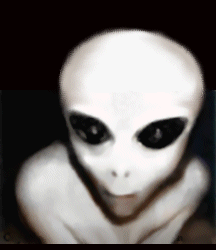 Precognitive symptoms originate from similar scenes, and similar conflicting emotions (which I have sometimes called “jouissance“), in a person’s future. The conflict might not only be sexual feelings, but also the most basic reward signal, “but I survived,” which is unbearable in the context of grief for a loved one (or shock at the loss of anonymous others, as in a disaster like the Titanic or 9/11). As I’ve argued elsewhere, it is precisely that sublime reward signal of survival in the context of loss or destruction that appears to become “displaced in time.” Because no one believes in precognition, those displaced emotions and experiences will almost always be misunderstood and misinterpreted.
Precognitive symptoms originate from similar scenes, and similar conflicting emotions (which I have sometimes called “jouissance“), in a person’s future. The conflict might not only be sexual feelings, but also the most basic reward signal, “but I survived,” which is unbearable in the context of grief for a loved one (or shock at the loss of anonymous others, as in a disaster like the Titanic or 9/11). As I’ve argued elsewhere, it is precisely that sublime reward signal of survival in the context of loss or destruction that appears to become “displaced in time.” Because no one believes in precognition, those displaced emotions and experiences will almost always be misunderstood and misinterpreted.
I wonder if it is our fear of death that leads us to fear and thus deny that our synchronicities and OOBEs and other paranormal experiences are really precognitive. Death is the ultimate bad thing lying in wait for us in our future. Among other tactics for beating death is simply killing (or ignoring) the messenger.
NOTES:
* The other film comparison that comes to mind with Arrival is Don’t Look Now, Nicolas Roeg’s 1973 masterpiece also on the theme of misrecognized precognition. In that narrative too, the inciting incident is the death of a child (such a scenario is, I suppose, low-hanging fruit for a storyteller who wants to establish ultimate loss and grief as the counterweight to subsequent events in a story about fate and foreknowledge); and as in Arrival, the psychic protagonist, the girl’s father John Baxter (Donald Sutherland), misrecognizes all subsequent premonitions as meaningless coincidences, including a vision of his wife that leads him to believe she was abducted, propelling him to his own murder.
Minus the full-on tragic dimension, this is really the way precognition works, particularly the way rationalists resolutely in denial of our more extraordinary natures will find themselves falling victim (usually in less consequential, merely annoying or neurotic ways) to the logic of the precognitive unconscious. The only “mistake” in Don’t Look Now is that (if I’m right) John Baxter would have seen and misinterpreted a vision of something preceding his death, not a vision of his funeral afterward.
** On the afternoon before first seeing Arrival, my thoughts for no apparent reason went to a Daisetz Suzuki lecture on those brushstroke circles that I had read about several years ago in the context of their influence on the composer John Cage; then in the movie, when the heptapods first produced their writing on the glass, I was happily amazed. This is precisely how precognition works—for all of us—a subtle skewing of our thoughts toward exciting and rewarding experiences in our (usually imminent) future. That same afternoon, the earworm in my head was a line from a Simon and Garfunkel song, “Somethin’ tells me it’s all happening at the zoo…”—also directly relevant to the climactic plot twist in Arrival.
Just pay attention—precognition is a constant process in our thoughts. And yes, by the very nature of the beast, it is usually impossible to prove that it’s not hindsight bias. Usually, but not always.


